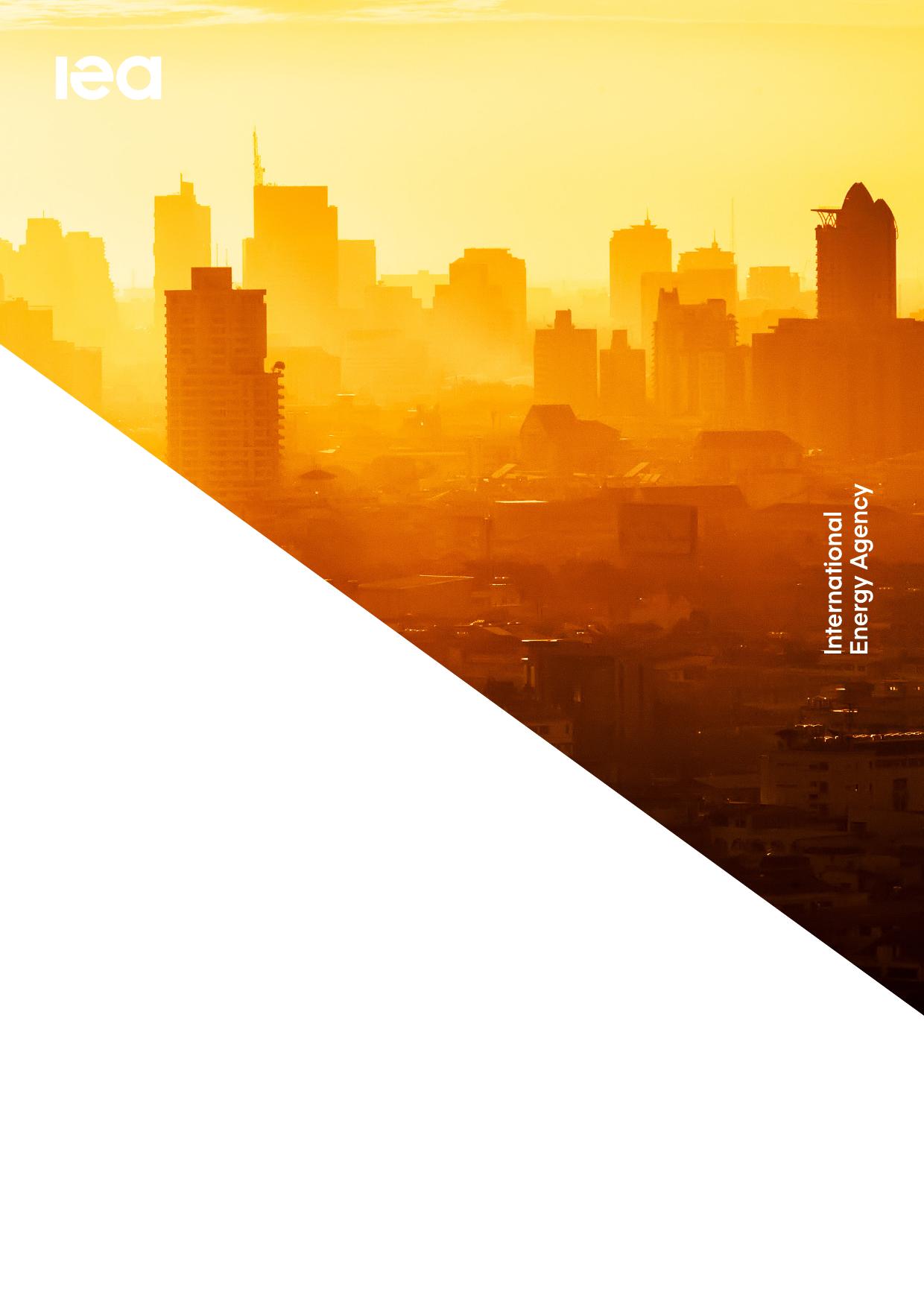EnergyEfficiency2023INTERNATIONALENERGYAGENCYTheIEAexaminestheIEAmemberIEAassociationfullspectrumcountries:countries:ofenergyissuesincludingoil,gasandAustraliaArgentinacoalsupplyandAustriaBrazildemand,renewableBelgiumChinaenergytechnologies,CanadaEgyptelectricitymarkets,CzechRepublicIndiaenergyefficiency,DenmarkIndonesiaaccesstoenergy,EstoniaKenyademandsideFinlandMoroccomanagementandFranceSenegalmuchmore.ThroughGermanySingaporeitswork,theIEAGreeceSouthAfricaadvocatespoliciesthatHungaryThailandwillenhancetheIrelandUkrainereliability,affordabilityItalyandsustainabilityofJapanenergyinitsKorea31membercountries,Lithuania13associationLuxembourgcountriesandbeyond.MexicoNetherlandsThispublicationandanyNewZealandmapincludedhereinareNorwaywithoutprejudicetothePolandstatusoforsovereigntyoverPortugalanyterritory,totheSlovakRepublicdelimitationofinternationalSpainfrontiersandboundariesandSwedentothenameofanyterritory,Switzerlandcityorarea.RepublicofTürkiyeUnitedKingdomUnitedStatesTheEuropeanCommissionalsoparticipatesintheworkoftheIEASource:IEA.InternationalEnergyAgencyWebsite:www.iea.orgEnergyEfficiency2023AbstractAbstractEnergyEfficiency2023istheIEA’sprimaryannualanalysisonglobaldevelopmentsinenergyefficiencymarketsandpolicy.Itexploresrecenttrendsinenergyintensity,demandandefficiency-relatedinvestment,policyandtechnology.Thistentheditionofthemarketreportalsofeaturesanewspotlightsection,focusedonkeyissuesfacingpolicymakersthisyear.Inparticular,thereportdetailswhatisentailedwiththeproposedglobaltargettodoubleenergyefficiencyprogressandwhatwillbegainedbyachievingit.Thisyear’sreportcomesamidsttheongoingeffectsoftheenergyandclimatecrisesinwhatisexpectedtobethehottestyearonrecord.Inthiscontext,2023globalenergyefficiencyprogress,asmeasuredbyprimaryenergyintensity,isexpectedtobeslightlybelowthelong-termtrendinaslowdownfrom2022.However,thereportmakesclearthataprofoundtransformationisunderwayinenergyefficiencyandcleanenergymorebroadly,withmanygovernmentsintroducingnew,orstrengtheningexisting,policiesandenergy-savingprogrammes.Thesepoliciesareleadingtofasterdeploymentofefficienttechnologiesandarecontributingtowardsanexpectedpeakingoffossilfueldemandinthecomingyears.PAGE3IEA.CCBY4.0.EnergyEfficiency2023AcknowledgementsAcknowledgementsEnergyEfficiency2023waspreparedbytheEnergyEfficiencyandInclusiveTransitionsOffice(EEIT)intheDirectorateofEnergyMarketsandSecurity(EMS)andincollaborationwithotherdirectoratesoftheInternationalEnergyAgency(IEA).ThereportwasdesignedanddirectedbyNicholasHowarth,EnergyAnalyst(EEIT).OtherleadauthorswereLucasBoehlé,FedericoCallioni,HadrienLoyant,JackMillerandFabianVoswinkel.DianeMunroeditedthereport.Principalauthors(inalphabeticalorder)were:ClaraCamarasa(cooling),ConorGask(Chinaandsectoranalysis),PaulineHenriot(systemsefficiency),KristinaKlimovich(PACEandbehaviour),NatalieKauf(SoutheastAsia,systemsefficiency),SimratKaur(India),SilviaLaera(systemsefficiency),EmmaMooney(behaviour,industryandEEOs),AlisonPridmore(transport),SungjinOh(governmentspendingandpolicyupdates),JoshOxby(employment),KseniaPetrichenko(buildingsandsystemsefficiency),CorneliaSchenk(investment,India),andBrendanReidenbach(investmentindigital).FurthersupportandinputwereprovidedbyJulietteDenis-SenezJappe,CarolineFedrine,LisaMarieGrenier,AndikaHermawan,YujunHuangandOrestisKarampinis.MitsidiProjetosandIanHamiltonalsoprovidedmuchvaluedanalyticalsupport.Leadauthorsforspecialspotlightsectionswereasfollows:LucasBoehléandFedericoCallioni(energyintensityprogress);HadrienLoyant,JackMillerandFabianVoswinkel(doublingefficiencyprogress);ClaraCamarasa,ArnauRisquezMartinandFabianVoswinkel(coolinginthehottestyearonrecord);PaulineHenriot,SilviaLaera,NatalieKaufandArnauRisquezMartin(benefitsofsystemsefficiency);LucasBoehlé,IanHamilton,HadrienLoyantandKseniaPetrichenko(gasandresidentialheating);SimratKaur,CorneliaSchenk,andArnauRisquezMartin(coolinginIndia).BrianMotherway,HeadofEEITprovidedoverallstrategicdirectiontothereport,alongwithVidaRozite,EnergyAnalyst.MelanieSlade,SeniorProgrammeManager,alsogaveexpertadviceandmanagementsupporttothereport.KeisukeSadamori,DirectorofEnergyMarketsandSecurity(EMS)providedimportantexpertguidanceandadvice.Valuablecomments,feedbackandguidancewereprovidedbyotherseniormanagerswithintheIEAandinparticular,TorilBosoni,LauraCozzi,DanDorner,PaoloFrankl,TimGould,TimurGül,DennisHesselingandNickJohnstone.PAGE4IEA.CCBY4.0.EnergyEfficiency2023AcknowledgementsThisyear’smarketreportbenefitedfromaspecialanalysisconductedbyEMScolleaguesJoelCouseandLouisChambeaudrawingonfuelreportsfromacrossthedirectorate.ParticularthanksgotoCarlosFernandezAlvarez,HeymiBahar,ErenCam,PabloHevia-Koch,GergelyMolnar,andaswellasDavideD’Ambrosio,CiaránHealy,JulianKeutz,ArneLilienkampandDavidMartin.DataandanalysisfromtheIEAEnergyDataCentrewasfundamentaltothereport,particularlyfromRobertaQuadrelli,AlexandreBizeul,PedroCarvalho,ThomasElghozi,JuhaKöykkä,DomenicoLattanzio,ArnauRisquezMartinandPouyaTaghavi-Moharamli.AnalysisandinputfromtheIEAWorldEnergyOutlook,TrackingCleanEnergyProgress,WorldEnergyInvestment,EnergyEfficiencyHub,EnergyTechnologyPerspectivesandSustainableRecoveryTrackerteamswasessentialtothiswork.ParticularthanksgotoBlandineBarreau,ElizabethConnelly,DanielCrow,ChiaraDelmastro,TanguyDeBienassis,AraceliFernandezPales,MathildeHuismans,MartinKueppers,ShaneMcDonagh,YannickMonschauer,RafaelMartinezGordon,ApostolosPetropoulos,ArthurRoge,JonathanSinton,LeonieStaas,TiffanyVass,AnthonyVautrinandDanielWetzel.ThereportwouldnothavebeenpossiblewithoutthesupportofJethroMullen,ActingHeadoftheCommunicationsandDigitalOffice(CDO),andhisteamwhowereresponsibleforproductionandlaunchsupport,especiallyPoeliBojorquez,CurtisBrainard,AstridDumond,ZacharyEgan,ThereseWalshandWonJikYang.ThereportwasmadepossiblebyassistancefromtheMinistryofEconomy,TradeandIndustry,Japan.TheItalianMinistryofEnvironmentandEnergySecurityisalsogratefullyacknowledgedfortheirsupportthroughtheircontributionstotheIEA’sDigitalDemandDrivenElectricityNetworks(3DEN)initiative.PeerreviewersManyseniorgovernmentofficialsandinternationalexpertsprovidedinputandreviewedpreliminarydraftsofthereport.Theirsuggestionswereofgreatvalue.Theyinclude:AlfaLavalMadeleineGilborneSatishKumarAllianceforanEnergyEfficientEconomy(AEEE)SteveNadelAmericanCouncilforanEnergy-EfficientEconomyNickMeetenAppliedEnergyRikaSafrinaDavidMorgadoASEANAlexAblazaJarrodLeakAsianDevelopmentBankAsia-PacificESCOIndustryAllianceAustralianAllianceforEnergyProductivity(A2EP)PAGE5IEA.CCBY4.0.EnergyEfficiency2023AcknowledgementsChinaNationalInstituteofPengchengLiStandardisationCLASPMattMalinowskiChristineEganClimateStrategy&PartnersPeterSweatmanDanfossSaraVadSørensenEcoHomesWinifredAtangaEconomic&HumanDimensionsSkipLaitnerResearchAssociatesEnelXVitoriaDelicadoMontoyaEmanuelaSartoriEnergyEfficiency&ConservationBrianFitzgeraldAuthority,NewZealandEnergyEfficiencyCouncil,AustraliaJeremySungEnergyEfficiencyMovement,ABBMikeUmikerEnergyinDemandRodJanssenEnergyProStevenFawkesEngieFlorenceDufourEuropeanHeatPumpAssociationThomasNowakEuropeanTransportandEnergyPierpaoloCazzolaResearchCentreofITS,UCDavisFraunhoferInstituteforSystemsandWolfgangEichhammerInnovationGhanaEnergyCommissionAdolfNiiAshongGIZLilianaCamposGovernmentofAustriaThomasDeutsGovernmentofNorwayTomAndreasMathiassonGovernmentofSpainMarBlazquezGovernmentofTürkiyeBarışSanlıIDAE,SpainMarisaOlanoIndependentconsultantsPaduS.PadmanabhanJacobTeterInstituteofEnergyEconomics,JapanKevinLaneMETI,JapanKoichiSasakiMinistryofEconomicAffairs&ClimateHarutoShinodaPolicy,TheNetherlandsJosephineRisMinistryofEconomicAffairsandJeltedeJongEmployment,FinlandTimoRitonummiMitsui&Co.GlobalStrategicStudiesInstituteTakashiHongoNaturalResourcesCanadaOpenexpOfficeofEnergyEfficiencyOregonDepartmentofEnergyYaminaSahebRegulatoryAssistanceProjectEdithBayerRéseaudeTransportd’Électricité(RTE),JanRosenowFranceBiankaShoai-TehraniRMITUniversityRockyMountainInstituteAlanPearsSchneiderElectricAmoryLovinsVincentMinierPAGE6IEA.CCBY4.0.EnergyEfficiency2023AcknowledgementsSignifyHarryVerhaarCarlosLopezSwedishEnergyAgencyNaokoDoiDanielWeaverTheInstituteofEnergyEconomicsMelissaTomassiniUKDepartmentforEnergySecurity&DavidShipworthNetZeroUNIDOYouthAdvisorLynnetteDrayJohnRobertCottonUniversityCollegeLondonEnergyAshokSarkarInstituteUniversityCollegeofLondonUNOPSWorldBankPAGE7IEA.CCBY4.0.EnergyEfficiency2023TableofcontentsTableofcontentsExecutivesummary..................................................................................................................9Chapter1.Energyefficiencyanddemandtrends..............................................................16Energyintensityanddemand...............................................................................................16Energypricesandaffordability.............................................................................................29Chapter2.Sectortrendsinenergyefficiency.....................................................................35Overview...............................................................................................................................35Transport...............................................................................................................................37Industry..................................................................................................................................45Buildings................................................................................................................................51Electrificationandsystemlevelefficiency............................................................................56Chapter3.Financeandemployment...................................................................................62Efficiencyinvestmenttrends.................................................................................................62Propertyassessedcleanenergyfinancing...........................................................................70Energyefficiencyemployment..............................................................................................72Chapter4.Energyefficiencypolicyprogressupdates......................................................75Internationaldevelopments...................................................................................................75Nationalandregionaldevelopments....................................................................................76Regulationsandstandards...................................................................................................82Behaviourchange.................................................................................................................85Energyefficiencyobligationschemes...................................................................................88Chapter5.Keyissuesforgovernments..............................................................................90Whyisenergyintensityprogresslowerin2023despitesignificantpolicyaction?..............90Whatdoesdoublingglobalprogressonenergyefficiencyentail?.......................................96Howdoesthehottestyearonrecorddriveurgencyforefficiencymeasures?..................102Howareconsumersbenefitingfromsystemefficiency?....................................................107Hastheenergycrisisacceleratedtheshiftawayfromgasinresidentialspaceheating?.113CanefficientcoolinghelpmanagefastrisingelectricitydemandinIndiaandachievethermalcomfortforall?.......................................................................................................119PAGE8IEA.CCBY4.0.ExecutivesummaryEfficiencypolicymomentumbuilds,butglobalenergyintensityprogressslowsEnergyefficiencyiscurrentlyseeingastrongglobalfocusamongpolicymakersinrecognitionofitsimportantroleinenhancingenergysecurityandaffordability,andinacceleratingcleanenergytransitions.Thiscomes,however,astheestimated2023rateofprogressinenergyintensity–themainmetricusedfortheenergyefficiencyoftheglobaleconomy–issettofallbacktobelowlonger-termtrends,to1.3%fromastronger2%lastyear.Thelowerenergyintensityimprovementratelargelyreflectsanincreaseinenergydemandof1.7%in2023,comparedwith1.3%ayearago.Annualprimaryenergyintensityimprovement,2001-2022,2023E,andbyscenario,2022-20305%x2improvement4%Primaryenergyintensityimprovement3%IEA.CCBY4.0.2%1%0%202120222023E2022-302022-302022-302001-102011-20STEPSAPSNZEIEA.CCBY4.0.Note:STEPS=StatedPoliciesScenario;APS=AnnouncedPledgesScenario;andNZE=NetZeroEmissionsby2050Scenario.Atthesame,thisyear’sslowerprogressinglobalenergyintensitymasksexceptionalgainsinsomecountriesandregions,wherestrongpolicyaction,increasedinvestmentsandconsumerbehaviourchangesledtosharpimprovementswellabovetheaverageglobalrate.ThisyeartheEuropeanUnionandtheUnitedStates,amongmanyotherssincethebeginningoftheenergycrisis,includingKorea,TürkiyeandtheUnitedKingdom,haveregisteredrobustimprovementsrangingfrom4%to14%.PAGE9In2023,globalmomentumtotargetadoublingintherateofefficiencyprogressto4%gatheredpace,whichcouldcuttoday’senergybillsinadvancedcountriesbyone-thirdandmakeup50%ofCO2reductionsby2030.InJune,46governmentsparticipatingintheIEA’s8thAnnualGlobalConferenceonEnergyEfficiencyendorsedthe‘VersaillesStatement:Thecrucialdecadeforenergyefficiency’,agreeingtostrengthenenergyefficiencyactionsinlinewithadoublingofglobalenergyintensityprogresseachyearthisdecadeto2030.PolicyactionistranslatingintoinvestmentanddeploymentTheenergycrisishasunambiguouslyacceleratedtheenergytransition,withenergyefficiencypolicyactionacentralplankofgovernmentinitiatives.Sincethestartoftheenergycrisisinearly2022therehasbeenamajorescalationinaction,withcountriesrepresenting70%ofglobalenergydemandintroducingorsignificantlystrengtheningefficiencypolicypackages.Annualenergyefficiencyinvestmentisup45%since2020,withparticularlystronggrowthinelectricvehiclesandheatpumps.Almostoneineveryfivecarssoldtodayisanelectricvehicleandgrowthinglobalheatpumpsalesisnowoutpacinggasboilersinmanymarkets.Globalenergyusecoverageofminimumperformancestandardsformajorenduses,2000-2023100%Energyconsumptioncovered(%)80%2000IEA.CCBY4.0.60%40%201020%0%2023EIEA.CCBY4.0.Note:Coverageforspacecooling,spaceheating,waterheating,refrigerationandlightingisshownforresidentialsectors.Sources:IEAanalysisbasedontheIEAPoliciesandmeasures(PAMS)database,CLASPPolicyResourceCenter.AccordingtotheIEA’sGovernmentEnergySpendingTracker,since2020almostUSD700billionhasbeenspentonenergyefficiencyinvestmentsupport,with70%ofthisinjustfivecountries:theUnitedStates,Italy,Germany,NorwayandFrance.PAGE10TheInflationReductionActof2022intheUnitedStatesincludesUSD86billionIEA.CCBY4.0.forenergyefficiencyactions,whiletheEuropeanUnionhasstrengtheneditsEnergyEfficiencyDirectivetocurbenergydemand.However,theimpactofnewgovernmentpolicies,regulationsandenergysavingprogrammes,coupledwithanunprecedentedlevelofinvestmentstoscaleupmoreefficienttechnologies,arenotalwaysimmediate,withefficiencygainsandenergyintensityprogressrealisedoveraperiodofyears.Moreover,thisyear’soverallglobalintensityprogressmasksmoresignificantgainsinsomecountriesandregionsasotherssawmuchlowerprogress.Afteranenergyintensityimprovementof8%intheEuropeanUnionin2022,anotherexceptionallyhighyearisexpectedin2023,witha5%gaininprogress.TheUnitedStatesisalsoontracktoposta4%improvementin2023.Astrongpost-pandemicresurgenceinChina’seconomicgrowthofaround5%isforecastin2023,alongwithasimilarreboundinenergydemand.Thesepreliminaryestimatesfor2023suggestthattheoveralllevelofenergyintensityinChinaisnotexpectedtochangethisyear.Ittakes40%moreenergytofuelGDPinChinathanintheUnitedStates,andalmostdoubletheenergytofuelthesamegrowthasintheEuropeanUnion.Thisshiftinthebalanceofeconomicactivity,alongwithaslowingofthecountry’senergyintensityimprovementalongwiththatofsomeotherregionsthisyear,helpsexplaintheslowdowninglobalenergyintensityprogressin2023.ThedeploymentofefficienttechnologiesiscurbingenergydemandandheraldingthepeakingoffossilfuelsInthefirsthalfof2023,heatpumpsaleswereup75%,comparedtothesameperiodayearago,inGermany,theNetherlandsandSwedencombined.Anelectricvehicleorheatpumpnotonlyshiftsenergyusetoelectricitythatisincreasinglycomingfromcleanenergysourcesbutalsousesmuchlessfinalenergythanaconventionalcarorgasboilertodothesamejob.Consumersnowhavebetterchoiceswhenrenovatingtheirhomesorbuyinganewvehicle.Thesechoicesarestartingtoopenupopportunitiesfornewlevelsofenergyefficiency.Forexample,globalsalesofgasolineanddieselcars,two-andthree-wheelers,andtruckspeakedin2017,2018and2019,respectively.Thismeansglobalgasolinedemand–whichismainlyusedbypassengercars–isexpectedtopeakandstabilisein2023ataround27mb/d.Atthecountrylevel,93outof146countriesrepresenting60%oftotalgasolineconsumptionhaveseendemandalreadypeak,plateauordecline.Thispatternisexpectedtoculminateinroadtransportasawhole,whichincludesdiesel-fuelledvehicles,suchastrucksandbuses,peakingataround45mb/din2025.PAGE11PeakingofresidentialgasandgasolinedemandsResidentialgasdemand(2007-2021)Gasolinedemand(2007-2023)NumberofcountriesShareoftotaldemand50100%100100%4080%8080%3060%6060%2040%4040%1020%2020%0DeclineorplateauIncreasingdemand0%00%indemandDeclineorplateauIncreasingdemandindemandNumberofcountries(leftaxis)Shareoftotaldemandin%(rightaxis)IEA.CCBY4.0.Sources:IEA(2023),WorldEnergyBalances,accessedOctober2023;IEA(2023),Oil2023:AnalysisandForecastto2028.Lookingatthemajorheatingcountriesaroundtheworld,residentialgasdemandhasalreadypeaked,plateaued,orisdecliningin34outofatotalof78countriesrepresentinghalfofalldemand.InEurope,residentialandcommercialgasdemanddroppedmorethan15%in2022comparedtotheyearbefore,undergreatpressureasaresultofhigherpricesfollowingRussia’sinvasionofUkraine.While40%ofthisdeclinecanbeattributedtotherelativelymildwinterlastyear,morethanhalfwasthroughvariousgas-savingmeasures,althoughthisincludesdemanddestructionaswellasefficiencygains.Thisshifttoelectrificationoftransportandheatingcomesatthesametimeasrenewableenergyistakingonarapidlyincreasingshareofelectricityproduction.Thisisseeingtheroleofenergyefficiencyevolvingfromaconsiderationofend-usealonetoaconvergenceofoveralluse,demandflexibility,andoptimiseduseofvariablerenewableresources.Inelectricitysystemswithhigherlevelsofvariablerenewablepenetration,earlyevidencesuggeststhatsuchsystemsthinkingcandeliverenergybillsavingsofuptoathird.Theworldisseeingrecordhottemperatures,boostingtheneedforcoolingandloweringtheneedforheatingIn2023theworldalsoexperienceditshottestyearonrecord,threateningtotriggeraviciouscycleofbothhigherelectricityuseandcarbonemissions.Heatwavescanalsoworsenhealthdisparities,reduceproductivity,raiseelectricitycosts,disruptessentialservices,anddrivemigration.ExtremeheatputsstrainsonPAGE12IEA.CCBY4.0.electricitysystems,requiringsubstantialinvestmentsingridinfrastructureandIEA.CCBY4.0.powergenerationwhileburdeningconsumerswithhighcoolingcosts,especiallyforthemostvulnerable.Datashowsextremeheatdrivesincreaseddemandforairconditioners,withsustainedaveragedailytemperaturesof30°Cboostingweeklysalesby16%inChina,forexample.DuringtheMaytoSeptemberglobalheatwavethisyear,peoplewerelookingonlineforairconditionersmorethanever,withthesearchterm'srelativepopularityonGoogleupmorethan30%worldwidecomparedwiththehistoricalaveragelevelofsearchesforthosemonths.Highertemperaturesalsohavedifferentimpactsonelectricitydemandonaregionalbasis.Forexample,IEAanalysisshowsthatevery1°Cincreaseintheaveragedailytemperatureabove24°Cdrivesariseofabout4%inelectricitydemandinTexas,whileinIndia,whereairconditionerownershipislower,thesametemperatureincreasedrivesa2%rise.BetweenMayandSeptemberin2023,powergridshitrecordlevelsofpeakdemandinmanyofthelargestcountriesintheworld,includingChina,theUnitedStates,India,Brazil,Canada,Thailand,MalaysiaandColombia–togetheraccountingformorethan60%oftotalglobalelectricitydemand.Insomeregions,suchasintheMiddleEastandpartsoftheUnitedStates,spacecoolingcanrepresentmorethan70%ofpeakresidentialdemandonhotdays.Amilderwinter,thesecondwarmestonrecordinEurope,alsocontributedtoreducedenergydemand,helpingimprovethisyear’senergyintensityresultsinEuropeandtheUnitedStates.Doublingefficiencyprogresscouldcutenergybillsbyone-thirdandmakeup50%ofCO2reductionsby2030Asmomentumbuildsaroundtheglobaltargettodoubleefficiencyprogressfromthe2022levelof2%to4%eachyearuntil2030,internationalefforts,includingthoseatCOP28,haveamajorroletoplayinshapingfutureenergyefficiencyanddemandpathways.Whiledoublingtherateofglobalenergyintensityprogressisachallengingtarget,itisnotanunprecedentedlevelofprogress.Inthepasttenyears,90%ofcountrieshaveachievedthe4%rateatleastonce,andhalfhavedonesoatleastthreetimes.However,onlyfourG20countries–China,France,theUnitedKingdomandIndonesia–havedonesooveracontinuous5-yearperiodwithinthelastdecade,thoughseveralothershavecomeclose.Inmostsectors,governmentscanmakerapidprogresstowardsdoublingbybuildinguponbestpracticeinexistingpoliciesandacceleratingthedeploymentofalready-availabletechnologies.Forexample,lightingstandardsintheEuropeanPAGE13Union,India,Japan,SouthAfricaandtheUnitedKingdomarealreadyatorexceedthelevelsetoutintheNZEScenario.Similarly,allindustrialelectricmotorswithinacertainoutputrangesoldintheEuropeanUnion,Japan,Switzerland,TürkiyeandtheUnitedKingdommustadheretotheefficiencyclassseenintheNZEScenario.Similarcasescanbefoundforbuildingregulations,andvehiclestandardsimprovementssettocomeintoforceby2030.Proportionofcountriestosurpassa4%annualenergyintensityimprovementoneormoretimesbetween2012and2021100%Proportionofcountries80%60%40%20%0%AtleasttwiceAtleastthreetimesAtleastfourtimesAtleastfivetimesAtleastoncein10yearsin10yearsin10yearsin10yearsin10yearsNote:150countries.Sources:IEA(2023),Aglobaltargettodoubleefficiencyprogressisessentialtokeepnetzeroonthetable,Comparedtoahigherenergydemandscenariowitharound2%annualenergyintensityprogresseachyearthisdecade,doublingto4%peryearwouldreduceCO2emissionsby7GtCO2–or20%ofcurrenttotalemissions,takingtheshareofenergyefficiencyandrelatedmeasurestohalfofallemissionsreductionsthisdecade.Itwouldalsocuttoday’senergybillsinadvancedeconomiesbyaroundone-third.Achievingthedoublingtargetwouldalsosee4.5millionmorejobsthantodayinenergyefficiencyacrossthemanufacturing,buildingrenovation,construction,industryandtransportsectors.Thesebenefitsonlyhighlightthatnowisnotthetimetopauseonenergyefficiencyactionbutthetimetofurtherexploitefficiency’spotentialtoaddressthemultipleintersectingcrisesofenergy,climateandcostofliving.PAGE14IEA.CCBY4.0.PAGE15IEA.CCBY4.0.EnergyEfficiency2023Chapter1.EnergyefficiencyanddemandtrendsChapter1.EnergyefficiencyanddemandtrendsEnergyintensityanddemandEfficiencypolicyactionsrapidlyincrease,butglobalenergyintensityprogressslowsamidmyriadfactorsIn2023,focushasremainedsteadfastontheimportanceofenergyefficiencyforacceleratingcleanenergytransitions,reducingenergycosts,andenhancingenergysecurity.However,globalenergyintensityprogress–orthereductioninenergyintensityoftheglobaleconomy–isexpectedtoslow,afteracceleratingbyabout2%in2022,andfallingtoslowerlevelsofaround1.3%in2023.EnergyintensityisdefinedastheamountofprimaryenergyusedtoproduceagivenamountofeconomicoutputorGDP,andisthemainglobalindicatortotrackprogressofenergyefficiency.Annualprimaryenergyintensityimprovement,2001-2022,2023E,andbyscenario,2022-20305%x2improvement4%Primaryenergyintensityimprovement3%IEA.CCBY4.0.2%1%0%202120222023E2022-302022-302022-302001-102011-20STEPSAPSNZEIEA.CCBY4.0.Notes:STEPS=StatedPoliciesScenario;APS=AnnouncedPledgesScenario;andNZE=NetZeroEmissionsby2050Scenario.Asanindicativerange,aGDPgrowthof3%withcurrentlyexpectedenergydemandgrowthofbetween2%and1%wouldyieldenergyintensityimprovementofbetween1%and2%,respectively.Despitethisyear’sslowerglobalprogress,itisimportanttorecognisethattheenergycrisishasunequivocallyacceleratedtheenergytransitionandefficiencygainsinmanymarkets.TheimpactofnewpoliciesandtechnologiesarenotPAGE16EnergyEfficiency2023Chapter1.Energyefficiencyanddemandtrendsalwaysimmediate,withefficiencygainsandenergyintensityprogressrealisedoveraperiodyears.ThisisespeciallytrueinEurope,aswellasothercountriesandregions,wheregovernmentshaverecentlyintroducedsweepingnewpolicies,regulationsandincentivestocurbenergydemandwhileconsumersandbusinessescontinuetoimplementenergysavingmeasuresinresponsetosharplyhighercosts.Whiletheenergycrisishascausedsignificanthardshipforhouseholdsandeconomiclossforbusinesses–especiallythosedependentonnaturalgas–ithasalsoledtoanimportanttransformationinenergyefficiencytrends.Thescaleupofradicallymoreefficienttechnologiesthatuseelectricityratherthandirectlyburningfossilfuelsisdrivingmuchhigherlevelsofefficiencyprogress.Thistransformation,combinedwithrecorddeploymentofsolarcapacity,isshorteningtherunwayforgrowthinfossilfuelsinmanymarkets.EnergyintensityimprovementinEuropemovestorecordlevelsasenergycrisisdriveschangeIntheEuropeanUnion,theenergycrisispromptedgovernmentresponsemeasuresandconsumerbehaviourchangesthatledtoanaverageintensityprogressofalmost8%in2022andtoanestimated5%in2023.Thiscomesasenergydemandisexpectedtofallby4%in2023.Bycomparison,inresponsetotheenergysystemrepercussionsoftheGreatEastJapanEarthquakeandefficiencymeasuresintroducedbythegovernment,Japaneseenergyintensityimprovedbyjustover7%in2011.IntheNetherlandsitreachedanastonishing14%in2022–oneofthehighestrateseverachievedforamajoreconomy–amidsomeofthesharpestincreasesinenergypricesintheregion.Elsewhere,verystrongenergyintensityimprovementswereregisteredinKorea,TürkiyeandtheUnitedKingdom.WhileeconomicgrowthintheEuropeanUnionisexpectedtoslowtoaround0.7%in2023,itrosetoanaboveaverage3.6%in2022despiteitbeingoneofthemostexposedregionsintheworldtotheenergycrisis.ThestrongconsumerspendingreboundfromtheCovid-19pandemicinthefirsthalfoftheyeardroveeconomicgrowthbutfadedastheyearprogressed.Meanwhile,energyusersreducedconsumptionbyasteep5.7%inanefforttomitigatehighenergycostsamidsupplyinsecurity.Ofcourse,somedemandreductioncameattheexpenseoflowerlevelsofcomfort,ofenergyintensiveindustrialactivities,aswellasimprovementsinenergyefficiency.Bythesecondhalfof2022theeconomicimpactoftheenergycrisissawamajorslowdownintheeuroarea,withmanymemberstatesbeingpushedintorecession.Energyintensiveindustrieswereparticularlyhardhit,withindustrialgasdemandPAGE17IEA.CCBY4.0.EnergyEfficiency2023Chapter1.Energyefficiencyanddemandtrendsfallingbyalmost20%y-o-yduringthe2022/2023winterseasoninOECDEurope.Withinflationcuttingdeeplyintohouseholdbudgetsandenergypricesstillelevated,thislossofmomentumovertheyearisexpectedtoreduceannualeconomicgrowthtolessthan1%for2023.Energyintensityprogress,selectedEUcountriesandtheUnitedKingdom,2022NetherlandsLuxembourgIrelandFranceLithuaniaBelgiumRomaniaAustriaHungaryGermanyItalyPolandEuropeanUnionDenmarkSlovakRepublicSwedenUnitedKingdomFinlandLatviaSloveniaCroatiaGreecePortugalSpainCzechia2022-2030NZECyprusMaltaBulgaria-2%0%2%4%6%8%10%12%14%16%EnergyintensityprogressIEA.CCBY4.0.Note:seeCyprus1disclaimer.Source:IEAanalysisbasedondatafromIEA(2023),WorldEnergyBalances,accessedOctober2023.1NotebytheRepublicofTürkiyeIEA.CCBY4.0.Theinformationinthisdocumentwithreferenceto“Cyprus”relatestothesouthernpartoftheIsland.ThereisnosingleauthorityrepresentingbothTurkishandGreekCypriotpeopleontheIsland.TürkiyerecognisestheTurkishRepublicofNorthernCyprus(TRNC).UntilalastingandequitablesolutionisfoundwithinthecontextoftheUnitedNations,Türkiyeshallpreserveitspositionconcerningthe“Cyprusissue”.NotebyalltheEuropeanUnionMemberStatesoftheOECDandtheEuropeanUnionTheRepublicofCyprusisrecognisedbyallmembersoftheUnitedNationswiththeexceptionofTürkiye.TheinformationinthisdocumentrelatestotheareaundertheeffectivecontroloftheGovernmentoftheRepublicofCyprus.PAGE18EnergyEfficiency2023Chapter1.EnergyefficiencyanddemandtrendsStrongprogressinmanymarketswasovershadowedbymoreenergyintensivegrowthinothersThereissignificantvariationintheoverallenergyintensityofmajoreconomiesduetodifferencesineconomicstructure,efficiencylevelsandclimate.Countriesthataremuchcolderormuchwarmertendtohaveahigherintensitylevelduetogreaterwarmingorcoolingdemands.Meanwhile,forexample,theimpactofmoreenergy-intensiveindustriesisapparentinPeople’sRepublicofChina(hereafter,“China”),whichistheworld’smanufacturinghub.Ituses40%moreenergytofuelGDPgrowththantheUnitedStates,andalmostdoubletheenergytofuelthesameeconomicgrowththanintheEuropeanUnion.Thesethreemajorcountriesorregionsconstitutealmosthalfofglobalenergydemand,withChinahavingthelargestshareat25%,followedbytheUnitedStatesat14%andtheEuropeanUnionat9%.Non-G20nationsaccountfor26%ofglobalenergydemand.Primaryenergyintensityandtotalenergysupply,G20andnon-G20countriesbyregion,202110EnergyIntensityRussia9MiddleEastAfrica876543China2Non-G20CountriesAmericasAsiaPacificEurope(excl.China)100100200300400500600TotalEnergySupply(EJ)IEA.CCBY4.0.Notes:PrimaryenergyintensityistheratiooftotalenergysupplytoGDP(MJperthousand2015USDPPP).Source:IEAanalysisbasedondatafromIEA(2023),WorldEnergyBalances,accessedOctober2023.Asthelargestenergyconsumingsectoraccountingforaroundone-thirdoftotaldemand,industryhasaparticularlylargeroleindrivingoverallenergyintensity.Chinahasthelargestshareofworldindustrialenergyconsumption,accountingfor37%oftheglobaltotalcomparedwith9%fortheUnitedStatesand8%fortheEuropeanUnion.PAGE19IEA.CCBY4.0.EnergyEfficiency2023Chapter1.EnergyefficiencyanddemandtrendsIn2006Chinaintroduceda“dualenergycontrols”policythatplacedlimitsongrowthinenergyconsumptionandrequiredreductionsinenergyintensityforhighenergyconsumingentities.Incombinationwithtargetssetunderitsfive-yeareconomicplanningframework,thesemeasureshaveseenannualgrowthinenergyconsumptionofonlyhalftherateofitseconomicgrowthoverthepastdecade.China’sNationalDevelopmentandReformCommission(NDRC)estimatesthateconomy-wideenergyintensityhasbeenreducedbyover26%between2012-2022,whichisthefastestoverallrateofimprovementforasustainedperiodofanyG20country.Theseregionalforceshelpexplainwhythisyear’simprovementinglobalenergyintensityislikelytobeslightlybelowthehistoricalaveragedespitemajortransformationsoccurringasaresultoftheenergycrisis.Thismeansthatwithoutstrongefficiencyprogress,fastergrowthinChinarelativetootherregionscouldresultinastructuralshifttoamoreenergyintensiveglobaleconomy.Householdconsumptionin2021accountedforaround38%ofChina’sGDP,comparedtoover68%intheUnitedStates,highlightingsignificantspaceforreductioninenergyintensityasaresultofwiderstructuralchangestotheeconomy.RecentlyChinahassignalleditsintentionstoenhancethefundamentalroleofconsumptionineconomicdevelopment.Thiswouldmeanashiftfrominvestment-ledtoconsumption-ledeconomicgrowth,aimingtoaccelerateitsuseofelectricvehiclesandhouseholdappliances,boostdomestictourismandpromotegreenproductsinruralareas.ShiftsinglobaleconomicandenergydemandgrowthhavemajorimplicationsforintensityprogressOverallglobaleconomicgrowthisexpectedtobebelowaveragecomparedwithlong-termhistoricaltrends,slowingto3%in2023from3.5%in2022,accordingtotheInternationalMonetaryFund.Atthesametime,energydemandgrowthisexpectedtoacceleratein2023to1.7%,upfrom1.3%theyearbefore.Economicgrowthinadvancedeconomiesissettoslowto1.5%in2023from2.6%in2022,whileinemerginganddevelopingmarketsitissettoremainsteadyataround4%AnotableexceptioninthisoverallslowdownisanexpectedaccelerationingrowthinChinatoaround5%,upfrom3%lastyear,asthecountryreboundsfrompandemicrestrictions.WhiletheimpactofCovid-19temporarilyupendedthenormalrelationshipbetweeneconomicgrowthandenergy,overthe2000-2019periodeachpercentagepointriseinglobalGDP,expressedinrealpurchasingpowerparity(PPP)terms,sawenergydemandincreasebyabout0.6%.ChangesinenergyintensityillustratehowtherelationshipbetweenGDPandenergydemanddiffersbetweencountriesandregions,aswellasovertime.ForPAGE20IEA.CCBY4.0.EnergyEfficiency2023Chapter1.Energyefficiencyanddemandtrendsadvancedeconomies,priortoCovid-19energyintensityfellbyaround1.8%peryearbetween2000and2019,involvingmodestGDPgrowthofapproximately2%andvirtuallyunchangedenergyconsumption.InleadingeconomiesenergydemandactuallydeclinedwhileGDPgrew.Forexample,inEuropeenergydemandpeakedin2006andwas10%lowerby2019,whileintheUnitedStatesithasstayedvirtuallythesame.RegionalcontributionstoglobalchangesinGDPandtotalenergysupply,2010-2023Eandbyscenario,2022-20304%Annualpercentagechange3%2%1%0%-1%-2%-3%GDPTESGDPTESGDPTESGDPTESTESTESSTEPSAPSNZE2010-2019CAGR20222023E2022-2030CAGRAsiaPacificNorthAmericaEuropeCentralandSouthAmericaAfricaMiddleEastEurasiaGlobalchangeIEA.CCBY4.0.Notes:TES=totalenergysupply.STEPS=StatedPoliciesScenario;APS=AnnouncedPledgesScenario;andNZE=NetZeroEmissionsby2050Scenario.Sources:IEA(2023),GlobalEnergyandClimateModel;IEA(2023),WorldEnergyBalances,accessedOctober2023.Inemergingmarketsanddevelopingeconomies(EMDE),energyintensityimprovedataslightlyhigherannualrateof1.9%onaveragebetween2000and2019,withaverageGDPgrowthof6%peryearrequiring3.6%moreenergyperyear.Behindthisenergygrowthstoryisthecatch-upinlivingstandards,withanaveragepersoninanEMDEusingthreetimeslessenergyintheirhomeandfourtimeslessfortransportcomparedwithapersoninanadvancedeconomy.Inthisyear’smarketreport,threeenergyconsumptionpathwaysareexplored–high,mediumandlow.Inthefirst,theStatedPoliciesScenario(STEPS),whichmapsthetrajectoryimpliedbytoday’spolicysettings,energyintensityprogresses2.3%peryearonaveragethisdecadealongwithGDPgrowthofaround3%andenergydemandofjustunder1%peryear.AhigherrateofenergyintensityprogressisseenintheAnnouncedPledgesScenario(APS),whichassumesthatallaspirationaltargetsannouncedbyPAGE21IEA.CCBY4.0.EnergyEfficiency2023Chapter1.Energyefficiencyanddemandtrendsgovernmentsaremetontimeandinfull.Thisseesenergydemandgrowthdecouplefurtherfromeconomicgrowth,with3.1%energyintensitygainsandholdingenergydemandalmostconstant.TheNZEScenario,whichmapsoutawaytoachievea1.5°Cstabilisationintheriseinglobalaveragetemperatures,alongsideuniversalaccesstomodernenergyby2030,seesenergyintensitydoublefromlastyear’slevelofaround2%tojustover4%onaverageeveryyearbetweennowand2030.Sucharesultwouldseeanabsolutedecouplingofeconomicgrowthfromenergydemand,withannualexpansionof3%inGDPeachyearonaveragethisdecadeseeingjustovera1%annualdeclineinenergydemanddespiteanannualexpansionof3%inGDPeachyear.GreaterlevelsofenergyefficiencywillbeneededtosecureapeakingoffossilfueldemandthisdecadeToprovidegreatervisiononcurrentenergydemandtrendsandgeographicalinsightintowhatisdrivingenergyintensitychange,thisyear’smarketreportprovidesasynthesisviewoftheoftheIEA’sbenchmarkmarketreportsforthemajorfuels,includingelectricity,oil,gasandcoal.Thiscollectiveanalysisinformsthe2023forecastoftotalenergysupply,andalongwithGDPestimates,arethemaininputsforassessingthechangeinenergyintensityforthecurrentyearof1.3%.In2023,energydemandgrowthiscentredinAsianeconomies,particularlyChina,whichisexpectedtomorethanoffsetslowingordecliningenergyconsumptioninothermajorcountriesorregions,suchastheUnitedStatesandEurope.Onbalance,thisseesgrowthinoverallglobalenergydemandaccelerateto1.7%.AccordingtotheIEA’sNovember2023OilMarketReportglobaloildemandisforecasttoincreaseby2.4%in2023,withjetfuelandpetrochemicalfeedstockstheprimarydriversofgrowth.Chinawillaccountfor77%ofthegainsfollowingapost-Covidreboundinfirsthalfoftheyear.Afterrisingby2.4mb/d,including0.2mb/dinbiofuels,in2023,globaloildemandgrowthisexpectedtoslowsharply,risingbyjust0.9mb/din2024.Roadtransportcurrentlyaccountsforaround45%ofglobaloildemand.Roadtransportfueluse,theprimarydriverofoildemand,isforecasttopeakandbegintodeclinefrom2025.Incrementalelectricvehiclesalescurrentlydisplacingaround0.4mb/dperyearwiththecumulativeimpactexpectedtoreach4mb/dperyearby2030.Oildemandforpassengercarsisexpectedtostartpeakingthisyear,andbythesecondhalfofthedecadefortotalroadtransportmoregenerally.Morethan50countrieshometo60%oftheworld’spopulationnowhavepoliciestoencourageelectricvehicles,with30countriessettingtargetdatestophaseoutnewsalesofinternalcombustionenginecars.AccordingtotheIEA’sWorldPAGE22IEA.CCBY4.0.EnergyEfficiency2023Chapter1.EnergyefficiencyanddemandtrendsEnergyOutlook2023,by2030,theSTEPSseesoverallglobaloildemandpeakandplateauataround102mb/d,withcontinuedgrowthinemerginganddevelopingcountries,whilefurtherincreasesinthepetrochemicalandaviationsectorsareoffsetbydeclinesinroadtransport.AccordingtotheOctoberupdateoftheIEA’sGasMarketReportseries,followingadeclineof1.5%in2022,worldnaturalgasdemandisexpectedtostaybroadlyflatin2023.Thiscoincideswithstrongmarketvolatilityandamplifiedlevelsofuncertaintytriggeredbytheenergycrisis.AshighlightedintheMedium-TermGasReport2023,theeventsofthepasttwoyearscouldbringtoaclosethe“GoldenDecadeofGas”(2011-2020),inwhichgascontributedaround40%ofthegrowthinprimaryenergysupplyworldwide.Regionalcontributionstoglobalchangesinfueldemands,byscenario,2010-2030Oil2010-2019CAGR20222023ESTEPS2022-2030APS2022-2030NZE2022-2030-4%-3%-2%-1%0%1%2%3%AnnualchangeinpercentageNaturalGas2010-2019CAGR20222023ESTEPS2022-2030APS2022-2030NZE2022-2030-4%-3%-2%-1%0%1%2%3%AnnualchangeinpercentageCoal2010-2019CAGR20222023ESTEPS2022-2030APS2022-2030NZE2022-2030-8%-6%-4%-2%0%2%4%6%AfricaAnnualchangeinpercentageAsiaPacificNorthAmericaEuropeCentralandSouthAmericaMiddleEastEurasiaGlobalchangeIEA.CCBY4.0.Sources:IEA(2023),GlobalEnergyandClimateModel;IEA(2023),WorldEnergyBalances,accessedOctober2023;IEA(2023),WorldEnergyOutlook2023extendeddatatable;IEA(2023),Medium-TermGasReportOctober2023;IEA(2023),OilMarketReport,November2023;IEA(2023),CoalMarketUpdate,July2023PAGE23IEA.CCBY4.0.EnergyEfficiency2023Chapter1.EnergyefficiencyanddemandtrendsGas-to-powerdemandin2022fellbyjust4%inEurope,partlybecausehydrofell19%in2022,somoregaswasneededforelectricity.In2023,thereboundinhydropoweroutput,contributestoa15%declineingas-to-powerdemand.InthematuremarketsoftheAsiaPacific,EuropeandNorthAmerica,overallgasconsumptionhasalreadypeakedduetodeploymentofrenewablepowergenerationandmoreefficientheating,andissettodeclineoverthecomingyears.TheSTEPSseesglobalgasdemandreachingapeakin2030,withannualglobalgrowthfortherestofthisdecadeofjust0.5%eachyearcomparedwithwellover2%duringthe2010-2019period.Lastyear,totalglobalcoaldemandreachedanall-timehigh,increasingby3.3%,drivenbyitslowerpricerelativetonaturalgasandreadyavailabilityinmanypartsoftheworld.Coal-firedgenerationwasalsosupportedbyoverallweaknuclearpowerandhydropowerproduction.Thisstronggrowthin2022wasparticularlyconcerningforclimategoalsgivencoalisthesinglelargestsourceofCO2emissions.Coaluserisestoanewrecordin2023asgrowthslowsto0.4%,closertoitslonger-termhistoricalrange.Thisyear’sgrowthreflectsstructuraldeclinesintheUnitedStates(-22%)andEuropeanUnion(-17%)offsetbycontinuedgrowthinAsia.BasedonpreliminaryestimatesfromtheIEA’sJuly2023CoalMarketReport,in2023,demandisforecasttoriseby3.5%inChinaand5%inIndia.TheseestimateswillbeupdatedinDecember.Together,thesetwocountriesaccountfor70%ofglobalcoaldemand.EnergydemandinChinareboundsin2023PreliminarydatasuggeststhatenergydemandincreasedinChinabyaround5%in2023,largelyduetohighereconomicactivityafterCovid-relatedlockdownrestrictionswerelifted.Coaldemand,whichroseby4.6%lastyear,isexpectedtoincreaseby3.5%in2023,withpowersectoruseup4.5%andnon-powergrowingby2%.Gasdemandisforecasttoincreaseby7%in2023,afterdecliningforthefirsttimeinfourdecadesin2022.Electricitydemandgrowthisexpectedat5.3%,upfrom3.7%theyearbefore.OildemandinChinaalsorosebyalmost10%,from14.7mb/dto16.4mb/din2023,with43%ofthisgrowthcomingfromroadtransport,36%fromfeedstocksand21%fromjetfuel.Gasolinedemandforroadtransportisforecasttorisebyalmost10%thisyearbeforeitstartspeakingin2024.Consumptionofgasolinewasresponsiblefor43%oftotaloildemandgrowththisyearandisforecasttodeclinefrom3.7mb/dto3.5mb/dby2028.PAGE24IEA.CCBY4.0.EnergyEfficiency2023Chapter1.EnergyefficiencyanddemandtrendsChangeinoildemandbyfuels,WorldandChina,2022-2023and2023-2028100%8%Other80%Jet/Kerosene60%21%8%Roadtransport40%Gasoil/diesel20%6%Gasoline0%Petrochemicals-20%46%25%23%Naphtha21%LPG/Ethane14%8%IEA.CCBY4.04%36%21%54%25%21%8%42%23%8%14%-22%-15%2022-232023-282022-232023-28WorldChinaSource:IEA(2023),Oil2023:AnalysisandForecastto2028.AvoidedenergydemandiskeytoachievingafasterrateofdecarbonisationofthepowersectorOverallelectricitydemandgrowthisexpectedtostayrelativelysteadyataround2%in2023followinganincreaseofjustover2%lastyear.Thiscompareswithalonger-termhistoricaltrendof2.5%growthperyearonaveragebetween2010and2019.In2023,thegainsareprimarilyconcentratedinChinaataround5%andIndiaat6.5%,whileelectricitydemandisexpectedtocontractinEuropeandtheUnitedStatesby2.5%andjustunder2%,respectively.Renewablesareexpectedtomeetallelectricitydemandgrowthin2023and2024,withChinaaccountingforaroundhalfofcapacityadditions,ledbyexpansionofsolarPV,especiallyfordistributedsystems.Overthepastdecade,avoidedelectricitydemandfromenergyefficiencygainsandacceleratingrenewabledeploymentcontributedtotheshareofrenewableenergyinelectricitygenerationincreasingfromaround20%in2010toabout30%in2022.However,fossilfuelsstilldominatethepowersector,witha61%shareinglobalelectricitygenerationin2022.PAGE25IEA.CCBY4.0.EnergyEfficiency2023Chapter1.EnergyefficiencyanddemandtrendsRegionalcontributionstoglobalchangesinelectricitygeneration,byscenario,2010-2030Electricity-0.5%0.0%0.5%1.0%1.5%2.0%2.5%3.0%3.5%4.0%2010-2019CAGRAnnualchangeinpercentage20222023ESTEPS2022-2030APS2022-2030NZE2022-2030-1.0%AsiaPacificNorthAmericaEuropeCentralandSouthAmericaAfricaMiddleEastEurasiaGlobalchangeIEA.CCBY4.0.Sources:IEAanalysisbasedonIEA(2023)GlobalEnergyandClimateModelandondatafromIEA(2023),WorldEnergyBalances,accessedOctober2023;IEA(2023)WorldEnergyOutlook2023extendeddatatable;2022and2023data;IEA(2023)ElectricityMarketReport–Update2023.Fasteractiononenergyefficiencymeansmoreavoidedenergydemand,whichisessentialtoacceleratingthesubstitutionoffossilfuelsforrenewableenergy.Thisisbecausetheincreaseindemandfromtheelectrificationofendusescanbeoffsetbyoverallefficiencygains.Forexample,switchingfromconventionallightpointstoLEDtechnologyintheUnitedStatescouldsaveenoughenergytopower3millionelectricvehiclesperyear,orheat2.6millionhomeswithheatpumps.Electricityproductionandshareofrenewables,2010-2022andbyscenario,2030Electricityproduction(TWh)4000080%Shareofrenewables3500070%3000060%2500050%2000040%1500030%1000020%500010%0201520212022203020300%2010STEPSAPS2030NZECoalNaturalgasHydrogenandammoniaOilNuclearRenewablesShareofRenewables(rightaxis)IEA.CCBY4.0.Sources:IEA(2023),NetZeroRoadmap:AGlobalPathwaytoKeepthe1.5°CGoalinReach:2023Update;IEA(2023),WorldEnergyBalances,accessedOctober2023.PAGE26IEA.CCBY4.0.EnergyEfficiency2023Chapter1.EnergyefficiencyanddemandtrendsIntheNZEScenario,therateofprogressofenergyefficiencydoublesandinstalledrenewableelectricitycapacitytriplesby2030,relativeto2022,withrenewablesaccountingforamuchhighershareat59%ofglobalelectricitygeneration.ProfoundenergyefficiencytransformationsaretakingplaceatcountryandregionallevelsChina,theUnitedStatesandEuropearetogetherresponsibleformorethanhalfofglobalGDPandenergyconsumption,sodevelopmentsintheseregionscanhelpquicklyunpackwhatisbehindglobalenergyintensitytrends.InEuropetheeffectsoftheenergycrisiscontinuetobefelt,withenergydemandforecasttodeclineby3%in2023afterdroppingby4.8%theyearbefore.ThisisoccurringasGDPgrowthslowsto0.9%in2023after3.8%in2022,yieldingenergyintensityprogressofaround4%for2023.ThepolicymeasuresintheREPowerEUplanandlowerdemandfromconsumersareexpectedtocontributetobroaderEuropeangasconsumptiondecliningby7%,thiscompareswithadropof13%in2022.Europe’scoalconsumptionisforecasttodropby15%duetoacombinationofrenewableenergyexpansionandstrongefficiencyprogress.Similarly,electricitydemandintheEuropeanUnionisforecasttodeclineby3%in2023,fallingforthesecondyearinarowandtoitslowestlevelintwodecades,despitehigherlevelsofelectrificationfromrecordsalesinelectricvehiclesandheatpumps.TheUnitedStatesseesastrongdegreeofdecouplingofitsenergyconsumptionfromitseconomyin2023,withGDPexpectedtogrowby2.4%andenergydemandexpectedatalower1.7%,yieldinganenergyintensityimprovementof4%.ThisispartlyduetotheimplementationoftheInflationReductionAct(IRA)thatstartedlastyear,andmarksthelargestinvestmentincleanenergyandclimateactioninthehistoryofthecountry.Afterasharpincreaseinheatingandcoolingdegreedaysin2022,anequallyabruptdeclinecontributeda2%fallinelectricitydemandin2023,substantiallyloweringuseofcoal-firedpowerby22%.Gasdemandisexpectedtoremainflat.Chinahasledtheworldinrecentyearsinenergyintensityimprovements,averaging3.8%peryearovertheperiod2010-2019.China’seconomyisexpectedtogrowbyjustover5%in2023.ThecountryhascontinueditsreboundfromCovid-19restrictionsboostingairtravelinparticular.However,significantdevelopmentofthepetrochemicalindustryin2023hasdrivenasharpincreaseinoiluse.ThisiscontributingtotheexpectationthatChina’slevelofenergyintensitywillnotchangein2023beforereturningtolongertermstendsofprogressgoingforward.PAGE27IEA.CCBY4.0.EnergyEfficiency2023Chapter1.EnergyefficiencyanddemandtrendsGDP,totalenergysupplyandenergyintensity,2022-2023,percentagechangeGDPandTESEnergyIntensityWorld3.0%1.3%1.7%China5.2%0.0%5.2%United2.4%4.0%States-1.7%Europe0.9%-3.1%4.0%-4%-2%0%2%4%6%-1%0%1%3%5%6%GDPTESEnergyIntensityImprovementIEA.CCBY4.0.Source:TES(IEAfuelmarketreportsynthesis)GDP(OxfordEconomics)Chinahasmaintainedtheaccelerationofitscleanenergytransitionbyrapidlygrowingtheshareofrenewablesforpowergeneration,butneverthelessitsgasandcoaldemandareprojectedtorisebyaround7%and4%,respectively,in2023.Coaldemandinthepowersectorisexpectedtobeup4.5%,whileconsumptionfromnon-powerusesisprojectedtogrowby2%.Similarly,eventhoughChinaisresponsibleformostglobalelectricvehiclesales,itsoildemandisexpectedtoincreasebyabout10%in2023,drivenprimarilybyjetfuelandpetrochemicalfeedstocks.Chinaisresponsiblefor77%ofglobaloildemandgrowthin2023.HistoryshowsadoublingofenergyintensityprogressispossiblewithstronggovernmentsupportGlobalenergyintensityprogressdoubledtoaround1.7%peryearonaverageinthe2011-2020period,followinganaverage0.8%improvementinthepreviousdecade.TheNZEScenarioseesthisprogressrisetojustabove4%peryearonaverageby2030.Thisrateofprogresswouldimplyasubstantialandconcertedeffortonthepartofgovernmentstoimplementnew,andstrengthenexisting,energyefficiency-relatedpoliciesandmeasures.OutofallindividualG20economies–togetherresponsibleforaround80%ofglobalenergyconsumption–fourteencountriesacceleratedtheirenergyintensityimprovementsduring2011-2020comparedwiththepreviousdecade.HalfofPAGE28IEA.CCBY4.0.EnergyEfficiency2023Chapter1.Energyefficiencyanddemandtrendsthosecountriesevendoubledtheirrateofimprovementfromonedecadetothenext,providingevidencethatsignificantchangeispossible.ArgentinaandBrazil,theonlytwoG20countrieswithnegativeenergyintensityimprovementsinthepastdecade,andwhoseupwardtrendmightbeassociatedwithstructuralchanges,switchedtopositiveefficiencyadvancementsin2021and2022,signallingapossibleturningpointintheirprogressaswell.MoredetailonwhatisinvolvedwiththedoublingofenergyefficiencyprogressthisdecadeisexploredinmoredetailinChapter5ofthisreport.Primaryenergyintensitytrends,G20countries,2001-2022EnergyIntensity202110-yearaverageannualenergy1-yearannualintensityimprovementsenergyintensityimprovementUnitedKingdomTürkiyeGlobalrateofprogress-4%0%4%8%12%16%ItalyneededintheIEANetAnnualgrowthZeroby2050ScenarioGermanyGlobalrateofprogress2020-20212021-2022IndonesianeededintheIEANetZeroby2050ScenarioEU27JapanMexicoFranceBrazilArgentinaIndiaAustraliaUnitedStatesG20WorldKoreaSaudiArabiaChinaSouthAfricaCanadaRussia0510-4%-2%0%2%4%6%AnnualgrowthMJper2015USDPPP2001-20102011-2020R20…21IEA.CCBY4.0.Note:2022datanotyetavailableforSouthAfrica,SaudiArabiaandIndonesia.Sources:IEAanalysisbasedonIEA(2023),IEAWorldEnergyBalances,accessedOctober2023;IEA(2023),TrackingCleanEnergyProgress2023.EnergypricesandaffordabilityWhilenewrisksemergein2023,wholesalecommoditypriceshavecooledaftersharpincreaseslastyearTheturmoilintheMiddleEasthasintroducednewrisksforenergypricesandputmarketsontenterhooks.Theseunwelcomeeventscomefollowingayearinwhichenergypricesreachedrecordlevels,dueinlargeparttotheRussianFederation’sPAGE29IEA.CCBY4.0.EnergyEfficiency2023Chapter1.Energyefficiencyanddemandtrends(hereafter,“Russia”),invasionofUkraine.Nevertheless,2023hasseenawelcomecoolingoffofwholesalecommodityprices.However,pricesarestillabovepre-crisislevelsand,inmostcases,declineshavenotyetbeenfullypassedthroughtoconsumers,whostillfacehighhouseholdenergybillsandcommercialinputcosts.Europeanwholesalegasprices–whichsawthesteepestincreaseofallenergycarriersin2022–havedecreasedmostdrastically,fromTTFspotpricesofUSD37/MBtuin2022toaroundUSD10/MBtuinJulythisyear.AsEuropepreparesforanotherwinterinwhichitaimstokeepgasdemanddown,pricesarenotexpectedtoshowthesamesharpincreasesaslastyear.Storagelevelsremainhighfollowinglowwithdrawalsin2022,andtheadditionofnewLNGimportterminalsandarampupinnaturalgasproductionintheUnitedStateshavecombinedtoincreasesupplyavailability.Naturalgaspricesintheshortandmediumtermareforecasttoremainabovetheirhistoricalaverages,whichwillweighondemandgrowthinthecomingyears.Energycommoditypriceindices,2019-2023Gas(TTF)Oil(WTI)Coal(FOBNewcastle)2507502000600Priceindex(June2019=100)4501600200300IEA.CCBY4.0.150120015008001004005000IEA.CCBY4.0.Sources:IEAanalysisbasedondatafromArgusMediaGroup(coal,oil)andICIS2023(gas).Allrightsreserved.Crudeoilpriceshavealsofallenin2023,comingdownfromlevelsashighasUSD120/bblforUSWestTexasIntermediateinspring2022.However,pricesarestillhigherthanin2019,whenoilcostaroundUSD60/bbl.GiventherecentconflictintheMiddleEast,oilsupplyriskshaveincreasedagain.Aftermorethanayearofhighpricesandvolatility,thepriceofcoaldroppedfromUSD400/tin2022toaroundUSD140/tinmid-2023.Coalpricesareforecasttoplateauandremainabovepre-crisislevelsinthecomingyears.WholesaleelectricitypricesalsoPAGE30EnergyEfficiency2023Chapter1.Energyefficiencyanddemandtrendsincreasedin2022,largelyasaresultofthenaturalgasandcoalusedinpowergeneration,buthavecomedownin2023.Lowerenergypricesalsofedintosupplychainsforkeymaterialsintheconstructionandindustrysectors,whichcaninfluencethepaceofenergyefficiencyinvestment.SteelpricesintheUnitedStates,ChinaandtheEuropeanUnionhaveallcomedownfrom2022highsbutnotyettopre-crisislevels.Globalpricesofironandaluminiumhavealsoslightlydecreasedin2023,whilethepriceofcopperremainsrelativelystableatelevatedlevels.Theconstructionsectordoesnotshowthesamedeclineincosts,buthigherpricesappeartohavepeakedin2022.TheChineseconstructionsectorcontinuestofacelowinvestmentanddecliningdemandfornewproperties,whileinEuropeandNorthAmericahigherinterestratesarecausingactivityintheconstructionsectortostall.Non-energycommoditypriceindices,2019-2023150Construction220Metals140Jan-20Jan-21Jan-222021130200120Index2019=100110180100IEA.CCBY4.0.1609080140Jan-191201008060Jan-232019202020222023USChinaEuropeSteelUSSteelChinaSteelEUAluminium(world)Copper(world)Iron(world)IEA.CCBY4.0.Sources:IEA(2023),WorldEnergyInvestment2023;NBSChina,ex-factorypriceindexofindustrialproducts;Eurostat,constructioncosts,newresidentialbuildingsquarterlydata;UnitedStatesCensusBureau,ConstructionPriceIndices.ConsumersstillfeelthepressureontheirenergybillsasretailpricestaketimetoadaptWhilewholesalepriceshavecomedowninQ1-Q32023,consumerenergypricesremainhighlyelevated.2022sawoneofthesharpestincreasesinenergyinflationincountriesacrosstheglobe.Thisupwardpressurehasslowed,andinsomecasesreversed,withmostcountriesseeingadropinthelevelofenergypriceinflationacross2023relativeto2022.However,becausepricesincreasewhileinflationispositive,manycountrieshaveyettoseeabsoluteenergypricesdrop.Wherepriceshavecomedown,theyareinmostcasesstillabovepre-crisislevels.Moreover,therearemanycountriesinwhichconsumersarespendingevenmoreonenergyin2023thantheydidin2022.PAGE31EnergyEfficiency2023Chapter1.EnergyefficiencyanddemandtrendsHighconsumerenergypricesarealsoreflectedincontinuedabove-averagehouseholdenergyexpendituresin2023.Householdnaturalgasandelectricitybillsdonotalwaysimmediatelyseethechangesinwholesalepricesforseveralreasons,includingthepracticebyenergyretailersofpurchasingwholesaleenergyfarinadvance,delaysinpassinglowercoststhroughtoconsumers,orinsomecasesincreasesinthefixedchargesinenergybillsrelativetounitprices.Additionally,somegovernmentschemestoshieldconsumersfromhighpricesinitiatedduringthecrisishavecometoanendorarebeingtaperedoff.Percentagechangeinconsumerenergyprices,year-on-yearinSeptemberandtotalchangeSep2021-Sep2023,selectedcountriesNetherlandsBelgiumNorwaySwedenSpainJapanEU-27ChileUnitedKingdomUnitedStatesGermanyItalyKoreaCanadaSouthAfricaHungaryFranceColombia-60-40-20020406080100120PercentagechangeinpriceSeptember2021-2022September2022-2023Totalchange2021-2023IEA.CCBY4.0.Source:OECD(2023),OECDEnergyConsumerPriceIndexDatabase,accessedOctober2023.SomeEuropeancountrieshaveseenaveragehouseholdenergyexpenditureperdwellingrisefurtherin2023comparedtolastyear–withafewnotableexceptionssuchastheNetherlands,whichsawpricesfallafterhavingoneofthehighestconsumerenergypriceincreasesin2022duetothecountry’sheavydependencyonnaturalgasforresidentialheating.Asaresult,thenumberofhouseholdslivinginenergypovertyisincreasing.Forexample,Europesawanincreaseinpeoplebeingunabletokeeptheirhomeadequatelywarmfrom6.9%in2021to9.3%in2022.InsomeEuropeancountries,purchasingpowerisatitslowestlevelin40years,largelyduetoenergycosts.PAGE32IEA.CCBY4.0.EnergyEfficiency2023Chapter1.EnergyefficiencyanddemandtrendsConsumertransportfuelpricesatthepumparegenerallyquickertoadapttochangesincrudeoilpricesbecauseconsumersarenottiedtofixed-price,longer-termcontracts,althoughthiseffectcanbemitigatedbychangesintaxationrates.Asaresult,mostEuropeanconsumerssawtransportationfuelcostsdeclineslightlyin2023comparedto2022.Averagehomeenergyexpenditureperdwelling,2021-20236000USD/dwelling500040003000200010000ChilePolandJapanGermanyNetherlandsUnitedAustriaUnitedFinlandKorea2021StatesKingdom20222023EIEA.CCBY4.0.2023isestimatedbasedondatafromQ1-Q22023.Notes:Dataincludeshomeheatingandothernon-transportenergyexpenditure.Estimatesbasedonannualprices.Sources:IEAanalysisbasedonIEA(2023),EnergyPrices,accessedOctober2023;IEA(2023),EnergyEnd-usesandEfficiencyIndicators,accessedOctober2023;IEA(2023),WorldEnergyBalances,accessedOctober2023.TargetedefficiencyinvestmentsareneededtotemperhighenergybillsandeaserisingpublicbudgetdeficitsAsofJunethisyear,governmentsspentoverUSD900billiononfinancialsupporttoshieldhouseholdsfromtheworstoftheenergybillincreases.However,sustainedhighenergypricesanddecreasesinpurchasingpowercontinuetoposechallengesforhouseholdsandrisksfurtherincreasingenergypoverty.Recordlevelsofspendingtofundthepost-19pandemiceconomicrecoveryandenergycrisishaveputconsiderablepressureonpublicbudgets.Inthiscontext,untargetedinterventionsposesustainabilitychallengesonmultiplelevels,withtheEuropeanCommissionurgingEUcountriestostopuntargetedenergyaidby2024.Targetedsupportandrampingupefficiencyinvestmentscaneaseenergypoverty,whilehavinglessofanimpactonbudgetdeficits.Energyefficiencymeasuresstructurallylowerenergybills,ratherthanonlyatemporaryfix,andprovidearangeofothermultiplebenefits.Forexample,theUnitedKingdomhasannouncedplansPAGE33IEA.CCBY4.0.EnergyEfficiency2023Chapter1.Energyefficiencyanddemandtrendstodecreaseitsenergypricecapfurther,butatthesametimehelpedensuresomeofthemostvulnerableconsumersremainsuppliedthiswinterbyexpandingaccesstotheWarmHomeDiscountSchemeforlow-incomehouseholds.Inresponsetoincreasedcostsofliving,theUnitedKingdomfurtherannouncedthattheGreatBritishInsulationSchemewillspecificallyraisesupporttohouseholdsinthelowestcounciltaxbandsorlivinginahomewithlowerenergyperformance.PAGE34IEA.CCBY4.0.EnergyEfficiency2023Chapter2.SectortrendsinenergyefficiencyChapter2.SectortrendsinenergyefficiencyOverviewProgressonenergyefficiencywilldeterminetheglobaltrajectoryforenergydemandIntheIEA’sTrackingCleanEnergyProgress2023report,allthekeyelementsthatcontributetoachievingtheavoidedenergydemandneededtoliftannualprogressinenergyintensityto4%areanalysedindetail.Toachievethistarget,energyefficiencyplaysamajorroleinallsectorsacrosshundredsoftechnologies,alongwiththeoverlappingandcloselyrelatedavoidedenergydemandmeasuresofelectrification,behaviouralchange,digitalisationandmaterialefficiency.Globaltotalfinalenergyconsumptionwasaround440EJin2022,withindustryresponsibleforthebiggestshareat38%,followedbybuildingsat30%andtransportat26%.Otherendusescontributedtheremaining6%.Thelevelofimprovementinenergyintensityoverthisdecadewilldeterminewhethertheworlddevelopsalongahigh-,medium-orlow-energydemandpathway.ThiswillhaveprofoundconsequencesforotherCO2mitigationmeasures.UndercurrentpoliciesintheIEA’sStatedPoliciesScenario(STEPS),finalenergyconsumptionrisesbyabout1%peryearonaveragethisdecadeto2030,intheAnnouncedPledgesScenario(APS)itstabilises,whileitfallsbyabout1%peryearonaverageintheNetZeroEmissionsby2050Scenario(NZEScenario).IEAtrackingofthekeyelementsrelatedtoenergyintensityprogressIEA.CCBY4.0.Source:IEA(2023),TrackingCleanEnergyProgress2023.IEA.CCBY4.0.PAGE35EnergyEfficiency2023Chapter2.SectortrendsinenergyefficiencyOfallthesub-sectorsandtechnologiesrelatedtoimprovingenergyintensityprogress,onlytwoare“ontrack”todelivertheavoidedenergydemandintheNZEScenario–electricvehiclesandlighting.Mostrequire‘moreeffortneeded’toachievethemilestonesby2030,whilemanyare“notontrack”,particularlyintheindustrysector.Aspartoftheradicalliftneededinefficiencyprogress,theincreasingpaceofelectrificationandrenewableenergydeploymentmeanstheroleofenergyefficienttechnologiesisalsochangingtowardsdigitallyenabledsystemoptimisationtolowerenergybills,increasegridstabilityandmaximiseemissionsreductions.Thissectiondivesintothesedifferentsectorsandcross-cuttingareastogiveamoregranularinsightonenergyintensitytrends.AnewIEAEfficiencyPolicyLevelIndexForthisyear’sreport,anewEfficiencyPolicyLevelIndexhasbeendevelopedtoenableclearcomparisonsofenergyefficiencypoliciesacrossdifferentcountries,policytypesandenduses.TheindexisscaledtotheefficiencylevelforeachenduseasdescribedintheNZEScenariotohelpcountriestrackprogressagainstnetzerogoals.TheNZEScenariopresentsonepossiblepathwaytoreachnetzeroemissionsin2050.However,countriesmayfollowdifferentpathwayswithdifferingpolicypriorities.Anindexvalueof100denotesthepolicylevelequivalenttotheNZEScenarioin2030.Inthisyear’sreport,theindexisappliedtoenergyperformancestandardsandsectoralelectrificationlevels.Theworldhasmovedfrombeing‘notontrack’to‘moreeffortsneeded’toreachefficiencylevelsfornetzeroTheenergycrisispropelled2022toarecordyearforintensityprogress,withalmostallcountriespostingimprovementrateswellabovetheirhistoricalaverages.InTrackingCleanEnergyProgress2023,theindicatorforenergyefficiencychangedfrombeing“notontrack”to“moreeffortsneeded”.Between2000and2022,energyintensityatthesectorlevelimprovedmostinthebuildingsandtransportsectors,withtheamountofenergyconsumedperunitoffloorareaandenergyusedperpassengerkilometretravelledfallingbyaround25%.Efficiencyprogresswasslightlyslowerintheindustrialsector,withtheamountofenergyneededtoproduceaunitofvaluefallingbyalmost20%–oraround1%peryear.PAGE36IEA.CCBY4.0.EnergyEfficiency2023Chapter2.SectortrendsinenergyefficiencyDuringtheyearsleadinguptotheenergycrisisin2022,therewasanotableslowdowninefficiencyimprovementinallsectorsexcepttransport,whereconsistentlyhighersalesofelectricvehiclestransformedprogress.Efficiencyprogressinresidentialbuildingsstalledbecauseofincreasingdemandandagrowinghousingstock,whileenergyintensityinindustryfellmoreslowly–andactuallyincreasedduringthepandemic–largelyduetostrongsteelproductiongrowthinChina.GlobalenergyintensitybysectorintheNetZeroby2050Scenario,2000-2030Index(2000=100)110TFCIntensity10090Transport(lightdutyvehicles)80Industry7060Residentialbuildings502030NZEtargets402000200220042006200820102012201420162018202020222030IEA.CCBY4.0.Note:End-useindicatorsusedfortransport,industryandresidentialbuildingsareroadpassengerkilometreenergyintensity(MJ/pkm),valueaddedenergyintensity(MJ/USD)andresidentialfloorspaceenergyintensity(MJ/squaremetre),respectively.Source:IEA(2023),TrackingCleanEnergyProgress2023.TransportTransportenergyconsumptiongraduallyreturnstopre-pandemiclevelsasthetransitiongatherspaceThetransportsectoraccountsforaround120EJ,or26%,oftotalfinalenergyconsumption,responsiblefornearly8GtofglobalCO2emissionsin2022.From2010to2022,totalenergyconsumptioninthesectorgrewatanaverageofjustunder1.2%peryeardespitealargeincreaseinthedistancetravelled.Forexample,thenumberofpassengerkilometrestravelledincarsrosebyanaverageofabout3%peryearbetween2010and2022.Around44%oftransportenergyconsumptionisfromthethreelargestenergyconsumers,theUnitedStates,theEuropeanUnionandChina.Between2010and2022transportenergyconsumptiongrewatanannualrateof5%inChina,roseslightlyby0.2%intheUnitedStates,andstayedconstantintheEuropeanUnion.PAGE37IEA.CCBY4.0.EnergyEfficiency2023Chapter2.SectortrendsinenergyefficiencyJapanwasastandoutperformerintermsofefficiencyprogress,withenergydemandfallingbyaround2%peryearevenasthenumberofpassengerkilometrestravelledslightlyrose.Transportwasthemostseriouslyimpactedend-usesectorbyCovid-19,withdemandfallingby14%in2020,andisonlynowreturningtopre-pandemiclevels.In2022,transportenergydemandwasstillrebounding,risingby4%,andmostofthiscomingfromaviation,whichisstillaquarterlowerthan2019levels.Totalfinalenergyconsumptionfortransport,2010-2022,andbyscenario,2030140TransportTotalFinalConsumption(EJ)120IEA.CCBY4.0.100806040200201520212022Brazil2030STEPS2030APS2030NZE2010EuropeanUnionChinaJapanIndiaRestofWorld2030NZEUnitedStatesIEA.CCby4.0Notes:STEPS=StatedPoliciesScenario;APS=AnnouncedPledgesScenario;andNZE=NetZeroEmissionsby2050Scenario.InternationalbunkersfinalconsumptionincludedinRestofWorld.Source:IEA(2023),WorldEnergyOutlook2023..Transportisthesectormostheavilyreliantonoil,whichaccountsfornearly91%offinalenergyuse,downonly3.5%fromtheearly1970s.Onlyaround1%oftransportenergyconsumptioniscurrentlyelectric,althoughthisischangingfast,withelectricitydemandfromroadtransportup60%in2022comparedwith2019levels.Withelectricvehicles–whicharegenerallymuchmoreefficientthanconventionalcars–gainingmarketsharerapidly,thetransportsectorisperhapsthemostdynamicend-usesectorforthecleanenergytransition.Globalgasolinedemandplateausthisyear,impactedbyimprovingpassengercarefficienciesandelectrificationIn2023,totaloildemandinthetransportationsectorisexpectedtoaccountfor58mb/d,oraround60%oftheprojected102mb/dinglobalconsumption.Gasolinedemand–whichismainlyusedbypassengercars–issettopeakandPAGE38EnergyEfficiency2023Chapter2.Sectortrendsinenergyefficiencystabiliseataround27mb/dthesameyear,followedbyroadtransportasawholein2025at45mb/d.Crucially,demandforoilfromcombustiblefossilfuels(whichexcludesbiofuels,petrochemicalfeedstocksandothernon-energyuses)isforecasttohititsapexat81.6mb/dduring2028,accordingtotheIEA’smedium-termoutlook,Oil2023.Thismilestoneisdrivenbythehistoricpivottowardslower-emissiontransportsources.Totaltransportfueldemand,efficiencyandEVsavings,2022-202870mb/d656055502023202420252026202720282022EfficiencysavingsTotaltransportdemandAdditionalbiofuelsEVsavingsIEA.CCby4.0Source:IEA(2023),Oil2023:AnalysisandForecastto2028.Attheregionallevel,overalltransportationoildemandisexpectedtocontinuetogrowinChinaandIndia,whiletheOECDaswholemayseedemandpeakin2023.Projecteddemandin2028wouldbe7.8mb/dhigherwithoutthesavingsfromnewEVsandefficiencyimprovementsfrom2022onwards.ElectrificationissettodrivearadicalliftinpassengervehicleefficiencywhiletrucksstayintheslowlaneSalesofgasolineanddieselcars,two-andthree-wheelersandtruckspeakedin2017,2018and2019,respectively.Justtwoyearsago,around4%ofvehiclessoldwereEVs.Thisrosetoaround15%ofcarsalesin2022,whilein2023around18%ofvehiclessoldareexpectedtobeelectric.IntheSTEPStheshareofelectriccarsintotalcarsalesreachashareof40%by2030,andintheNZEScenariotheshareincreasestomorethan65%by2030and100%by2035.IntheNZEScenariotheaverageannualimprovementinenergyefficiencyforpassengercarsmorethantriplesfromcurrentratesofaround1.6%peryearto5%ayearby2030.Forheavy-dutytrucksefficiencyimprovementsarerelativelyPAGE39IEA.CCBY4.0.EnergyEfficiency2023Chapter2.Sectortrendsinenergyefficiencyslowerduetothelowerelectrificationlevels,withtheannualimprovementincreasingtoover2.6%in2030,fromonly0.3%peryearfrom2010-2021.Globalenergyintensityprogressforpassengercarsandheavy-dutytrucks,2010-2022,andbyscenario,20306%Annualimprovementinenergyintensity5%4%3%2%1%0%Heavy-dutyPassengertruckscarsCAGR2010-202120222030NZE2030STEPS2030APSIEA.CCby4.0Notes:STEPS=StatedPoliciesScenario;APS=AnnouncedPledgesScenario;andNZE=NetZeroEmissionsby2050Scenario.EnergyintensitycalculatedinPJ/passenger-kilometreforpassengercarsandPJ/tonne-kilometreforheavy-dutytrucks.Sources:IEA(2023),TrackingCleanEnergyProgress;IEA(2023),WorldEnergyOutlook2023.Althoughtheyrepresentfewerthan8%ofvehicles(excludingtwo-andthree-wheelers),trucksandbuses,whichmainlyusedieselratherthangasoline,areresponsibleformorethan35%ofdirectCO2emissionsfromroadtransport.In2022,CO2emissionsfromtrucksreboundedtoaroundtheir2019levelandcurrenttrendssuggestthattheyaresettoreachrecordlevelsin2023.In2022,nearly66000electricbusesand60000medium-andheavy-dutytrucksweresoldworldwide,representingabout4.5%ofallbussalesand1.2%oftrucksalesworldwide.In2023,proposalsforstrengtheningstandardsforheavy-dutyvehicleshavebeenputforwardinEuropeandtheUnitedStates.TheEuropeanUnionhasproposedrevisionsformorestringentCO2standardsforheavy-dutyvehicles,includinga100%zeroemissiontargetby2030forcitybusesanda90%reductionfortrucksby2040.Theoriginalstandardcovers70%ofemissionswhilethenewstandardwouldcover95%.PAGE40IEA.CCBY4.0.EnergyEfficiency2023Chapter2.SectortrendsinenergyefficiencyMexicoCityincreaseselectrificationeffortsinpublictransportMexicoCity’sfirstfullyelectrifiedMetrobuslinestartedoperatingin2023,consistingofatotalof60buseswith330kmrange,allowing18-hourshifts.Thesebusescanbefullychargedovernight,byusing32highpowerchargersdeployedinadedicatedchargingstation,takinglessthanfourhours.AnotherimportantMetrobusline,carrying120000dailycommuters,isbeingelectrifiedwiththedeploymentof55newelectricbuses,withmoretocomeasdieselbusesreachtheendoftheirlifespan.Thetrolleyfleethasalsobeenrenovatedandexpanded,with425newunitsaddedinthelastfiveyearsandanewlineopenedin2023,withanotherexpectedin2024.Theelectrificationofthetaxifleetisalsoprogressing,withhundredsofcarsalreadyinoperation.Additionally,withthenewprogrammeFinanciamientoalTransportePúblicoIndividualSosteniblelaunchedin2023,thecityincreasedtheeffortstoreplacepartofthemorethan25000nearlyobsoletetaxis,providinggrantsofMXN180000(USD10000)fortheacquisitionofelectricvehiclesandMXN135000(USD7500)forhybrids.IntheUnitedStates,higherstandardswereproposedwhichincludenewtargetsforheavydutyhighwayvehiclesformodelyears2028through2032,aswellasupdatestothepreviouslyfinalisedstandardsfor2027trucks.InMarch2023,Indonesiaannouncedthecountrywill,withthesupportoftheIEA,developfueleconomystandardsfortrucks.InApril2023Phase1ofIndia’sfuelconsumptionstandardsforheavydutyvehicleswereimplemented,introducingaminimumperformancerequirement.InKorea,itsfirstGHGemissionstandardtocovertrucks(above3.5t)aimstoreduceemissionby2%in2023,4.5%in2024and7.5%in2025,comparedwiththeaveragevaluefrom2021to2022ofallvehiclessolddomestically.FueleconomystandardsforcarsarebeingstrengthenedwithcountriesstartingtoalignwithnetzerolevelsThestringencyofmanyfueleconomystandardshasstronglyincreasedoverthelastdecade,withagrowingnumberofcountriesalsostrengtheningincentiveprogrammes.Atleastthreejurisdictions–theEuropeanUnion,theUnitedKingdomandtheUnitedStates–haveputinplaceorhaveunderproposalfleetaveragestandardsfornewpassengervehiclesalesthatareinlinewiththeNZEScenario.Thislevelisreflectedbyavalueof100oraboveintheIEAEfficiencyPolicyLevelIndex.TherehasbeensubstantialprogressinthisareawiththeIndexPAGE41IEA.CCBY4.0.EnergyEfficiency2023Chapter2.Sectortrendsinenergyefficiencyincreasingfromamedianlevelof5in2010toabove50in2023.Withcurrentexpectedimprovementpathways,itwillreachalmost80by2030,closelyapproachingNZEScenariolevels.Fueleconomystandardsinmanyjurisdictionsfollowtank-to-wheelefficienciesthatdonotconsidertheproductionofthefuel.However,withelectricvehiclesontherise,productionefficienciesincreaseinimportanceastheycanvarywidely,especiallydependingontheshareoffossilfuelinputsinelectricitygeneration.Forthisreason,initsfueleconomystandardfor2030,Japanisemployingawell-to-wheelapproachwhichallowscomparingtheprimaryenergyneededformovingthevehicleacrossdifferentfuels,includingalsoelectricityandhydrogen.Newstandardsarealsobeingputinplace.NewZealand'sfirst-everemissionsstandardsforlight-dutyvehiclescameintoforcein2023,andtheAustraliangovernmentiscurrentlydevelopingfuelefficiencystandardsfornewlight-dutyvehicles.InMarch2023,theEuropeanUnionstrengthenedthe2030tailpipeemissionsreductiontargetfornewcarsfrom-37.5%to-55%comparedto1990levelsandintroduceda100%reductionfor2035.IntheUnitedStates,proposalstoupdatefueleconomystandardscouldinvolvetargetsfora2%peryearimprovementinfuelefficiencyforpassengercarsand4%peryearinlighttrucks.IEAEfficiencyPolicyLevelIndex,fueleconomystandardsfornewpassengercars,globalcountryrange,2010-2030140120PolicylevelrangeIndex100=2030NZEScenariolevelIEA.CCBY4.0.Medianpolicylevel100Typicalelectriccar80MostefficientICEcar60Typicalcompact(ICE)40TypicalSUV(ICE)202030NZEScenariolevel0201520202023202520302010IEA.CCby4.0Notes:ICE=internalcombustionengine.AllfuelconsumptionisnormalisedtotheWLTPtestcycleandtank-to-wheelefficienciesaccordingtotheICCTmethodology.Fueleconomystandards2023areinforce,2030includeinforceandproposedvalues.Allexamplevehiclesmodelyear2023.MostefficientICEcar:Mazda2Hybrid1.5,Typicalcompact(ICE):FordFiesta,TypicalSUV(ICE):NissanQashqai,Typicalelectriccar:TeslaModel3.Anindexof100denotesthefueleconomypolicylevelfor2030intheNZEScenario(3lge/100km).Itcoversonlyusagephaseefficiencyanddoesnotallowlifecycleassessment.Countrysamplerepresents69%ofglobalroadtransportenergydemand.PAGE42EnergyEfficiency2023Chapter2.SectortrendsinenergyefficiencySalesofelectricvehiclesaregrowingstrongly,underpinnedbymoreambitioustargetsElectriccarmarketsareseeingstronggrowthwithglobalsalesexceeding10millionvehiclesin2022.Bytheendof2023,14millioninvehiclesalesisexpected,a35%year-on-yearincrease.Asaresult,electriccarscouldaccountfor18%oftotalcarsalesgloballyin2023.Two-andthree-wheelershavethehighestelectrificationsharestodayofanyroadtransportmode,inparticularinemergingmarketanddevelopingeconomies.MorethanhalfoftheelectriccarsonroadsworldwideareinChina,wheretheshareofsalesat29%in2022hasalreadyexceededitsnationaltargetof20%for2025.InEurope,thesecondlargestmarket,electriccarsalesincreasedbyover15%in2022,meaningthatmorethanoneineveryfivecarssoldwaselectric.ElectriccarsalesintheUnitedStates–thethird-largestmarket–increased55%in2022,reachingashareof8%.India,ThailandandIndonesiaalsosawnotableincreasesinelectricmobilityin2022.Collectively,salesofelectriccarsinthesecountriesmorethantripledrelativeto2021andin2022wereseventimeshigherthanin2019.OverhalfofIndia’sthree-wheelerregistrationsin2022wereelectric,withgrowthdrivenbysupportfromgovernmentincentives,lowerlifecyclecostscomparedwithconventionalmodels,aswellashigherconventionalfuelprices.Annualnewvehiclesalesbycartype,EVsalesshareandyear-on-yearsalesgrowth,global,2020to2023EVsandFCEVssalesshareandgrowth140%70Millionunitssold120%60100%5080%4060%3040%2020%100%02020202120222023E2020202120222023EEVsandFCEVsOtherthanEVsandFCEVsEVsandFCEVsOthervehiclesEVsandFCEVssalesshareYear-on-yearsalesgrowthIEA.CCBY4.0.Notes:Electricvehicles(EVs)includebatteryelectricandplug-inhybridvehicles.FCEVs=fuelcellelectricvehicles.Source:IEA(2023),GlobalEVOutlook2023.PAGE43IEA.CCBY4.0.EnergyEfficiency2023Chapter2.SectortrendsinenergyefficiencyGlobalEVgrowthisunderpinnedbyadoptionofincreasinglyambitiousstrategiesforpromotingzero-emissionvehiclesinarangeofcountries.TheAustraliangovernmentisdevelopinganationalEVstrategywhichaimstoencourageincreasedEVdemandandaffordability.Canadawillrequireallnewcarstobezero-emissionvehiclesby2035,withatleast20%in2026and60%in2030.InCostaRica,theLawofIncentivesforGreenTransportationtopromoteEVpurchaseswasapprovedin2022,whileGhana’srecentlyreleasedEVstrategyaimsfor4%,16%and32%ofnewsalestobeEVsin2025,2030,and2050,respectively.InIndonesia,governmentvehicleshavebeenrequiredtobeelectricsince2022,andEVpurchasesubsidieswereputinplacein2023.Withlargercarsbecomingmorepopularthanever,electricvehiclesofferaradicalefficiencybreakthroughIn2022,SUVsaccountedforaround46%ofglobalcarsales,upfromonly16%in2010,withnoticeablegrowthintheUnitedStates,IndiaandEurope,amongothers.Thetrendtowardsheavierconventionalvehicleswithhigherfueluseisputtingupwardpressureonoildemand.IntheUnitedStates,forexample,anaveragestandardSUVweighs800kgmoreandneedsaround45%morefuelthananaveragemedium-sizedcartotravelthesamedistance.ForEVs,theenergyconsumptionincreaseofastandardSUVoveracompactcaris33%atanequalweightdifference.Vehicleefficiency(usagephase)andweight,newvehicles,UnitedStates,202318MercedesG-Wagon16Fuelconsumption(lge/100km)LandRoverMercedesPorscheICE14IEA.CCBY4.0.DiscoveryS-ClassCayenneCadillacEscaladeEVJeepGrandWagoneer12MercedesChevroletRangeRoverC-ClassBlazer10ToyotaSequoiaToyota8Camry6MINIHondaToyotaFordF150Ram1500AudiRivianRivianKiaCooperAccordVenzaAudiPickupPickupe-tronR1TR1SMitsubishiRioKiaA3BMWMercedesFordF-1504MirageNiro7SeriesEQSLightningToyota2ToyotaNissanHyundaibZ4XVolvoVWCorollaLEAFIoniq5C40ID.40Toyota1000PriusBMWKiaTeslaTeslai3sNiroel.Model3TeslaModelSModelX15002000250030003500Weight(kg)Notes:lge=Litresofgasolineequivalent.Allvehiclesaremodelyear2023,exceptforBMWi3sandVolkswagenGolf(modelyear2021)andHyundaiIonis5(modelyear2022).ForSUVsandpickuptrucks,theall-wheeldriveversionisused.TheefficienciesfollowUSEPAmethodology,coveringtank-to-wheelefficiencies.ICE=internalcombustionenginevehicle,EV=electricvehicle.Source:U.S.EnvironmentalProtectionAgency.PAGE44EnergyEfficiency2023Chapter2.SectortrendsinenergyefficiencyElectricSUVnumbersarealsogrowingrapidly,accountingforaround16%oftotalSUVsales,andforoverhalfofglobalEVcarsalesforthefirsttimein2022.Comparedtoaconventionalcar,evensomeofthelargestandheaviestelectricSUVsrequirelessenergytotravelthesamedistancethanthemostefficientconventionalsmallcars.However,largerbatteries,theheaviestandlargestsinglecomponentofanelectriccar,putadditionalpressureonbatterysupplychains,requirehigherenergyuseinvehicleproductionandfurtherincreasesdemandforcriticalminerals,whilelargerSUVsresultinincreasedroadandparkingspacerequirements,greaterrisktothesafetyofpedestriansand,reflectingtheirhighercost,canresultinissuesrelatingtoequityandaccesstocarownership.Addressingtheserisksinadvanceispossiblethroughanumberofactions,includingincentivisingthemarkettoreduceaveragecarweightforbothconventionalandelectricSUVs.Forexample,since2022France’sBonusMalusSchemehasaccountedforweightandfrom2024inParisandLyonweight-basedparkingchargeswillapply.InNorway,taxeswereintroducedforEVsforthefirsttime.FromJanuary2023aweighttaxofNOK12.5(USD1.24)foreverykgofvehicleweightabove500kgwasimplemented,aswellasataxbasedonvehicleprice.InKorea,anenergyefficiencylabelandratingwasintroducedforelectricvehiclesandwillbedisplayedfromApril2024,makingiteasierforconsumerstochoosethemostefficientoption.IndustryIndustrialenergyconsumptionwillcontinuetogrowoverthenextdecadeTheindustrysectoraccountsforalmost170EJ,oraboutone-thirdoftoday’sglobaltotalfinalenergyconsumption.Industrialenergyconsumptionhassteadilyriseninrecentyears,byaround1.3%perannumfrom2010to2022.Since2000,totalglobalenergyindustryconsumptionrosebyalmost70%.Around38%ofglobalindustrialenergyconsumptionisinChina,greaterthantheEuropeanUnion,UnitedStates,IndiaandJapancombined(28%).Between2010and2022,itgrewatanannualrateof2%inChina,4.5%inIndia,and0.7%intheUnitedStates,whileitfellby0.8%intheEuropeanUnionand1.4%inJapan.PAGE45IEA.CCBY4.0.EnergyEfficiency2023Chapter2.SectortrendsinenergyefficiencyTotalfinalenergyconsumptionforindustry,2010-2022,andbyscenario,2030IndustrialTotalFinalConsumption(EJ)2001801601401201008060402002015202120222030STEPS2030APS2030NZE2010ChinaEuropeanUnionUnitedStatesIndiaJapanRestofWorld2030NZEIEA.CCby4.0Source:IEA(2023),WorldEnergyOutlook2023.IndustryenergyconsumptionincreasesfurtherunderallIEAscenariosoverthenextdecade,risingby1.4%peryearintheSTEPSby2030.UndertheNZEScenario,globalgrowthinindustryenergydemandislimitedto0.6%peryear,drivenbymassdeploymentofmoreefficientanddigitalisedprocesses,technologies,increasedrecyclingandelectrification.DespitetherecentslowdownindemandgrowthinChina,itwillcontinuetoputupwardpressureonindustrialenergydemandalongwithIndia,whichundertheSTEPSwillseethelargestenergydemandgrowthofanycountryinthenextthreedecadesat3.3%peryear.Industrialemissionsslightlydeclinedbyaround2%in2022,withthesectorbeingresponsibleforemittingabout9GtCO₂throughcombinedenergyuseandprocessemissions,equivalenttoaboutone-quarterofglobalemissions,butnotincludingindirectemissionsassociatedwithelectricityconsumption.Industrialenergyuseisheavilydominatedbyfossilfuels,withcoalaccountingfor28%,naturalgas18%andoil19%.Electricityprovides23%,withitssharesteadilyincreasing,andbiomassandwasteheatrepresenttheremainder.Steel,cementandaluminiumtogetheraccountforalmost60%ofindustrialenergyconsumption.Energyefficiencyoptionsaremostlybasedonfuelswitching,recyclingandmaterialsubstitutions,aswellasmoreefficientmotorsystemsandequipment,andadvancedenergymanagementsystems.PAGE46IEA.CCBY4.0.EnergyEfficiency2023Chapter2.SectortrendsinenergyefficiencyGlobalenergyintensityprogressfortotalindustryandbymajorsegments,2010-2022,andbyscenario,20304%Annualimprovementinenergyintensity3%2%1%0%-1%-2%SteelCementAluminiumIndustry(total)2030APSCAGR2010-202120222030NZE2030STEPSIEA.CCBY4.0.Note:EnergyintensitycalculatedinPJ/USDBillion(2022,PPP)forindustry(total)andPJ/Milliontonneforsteel,cementandaluminium.Sources:IEA(2023),TrackingCleanEnergyProgress;IEA(2023),WorldEnergyOutlook2023.ChinaexpandscoverageofindustrialenergyefficiencybenchmarksChinahastakenactionsinthepastdecadetoreduceenergyintensityinindustry,whichaccountsforabouttwo-thirdsofthecountry’stotalenergyconsumption.Thegovernment’sActionPlanforIncreasingIndustrialEnergyEfficiencysetsoutbroad-basedtargetsfortheperiodfrom2021to2025,includingaimstoreduceenergyconsumptionperunitofvalueaddedby13.5%,increasetheproportionofnewenergy-efficientmotorstoexceed70%ofsales,andforelectricitytoaccountfor30%oftotalfinalindustrialenergyconsumption.Theplanalsoaimstocurbdevelopmentandeliminatehigh-energy-consumption,high-emissionandlow-qualityprojects,includingthroughadjustmentstoenergyefficiencybenchmarks.IndustrialenergyefficiencybenchmarkswereexpandedinJuly2023tocover80%ofallindustrysectors.Existingprocesses,includingcementclinker,steel,ironandcoppersmelting,arerequiredtomeetbenchmarksbytheendof2025.Newlyaddedprocessesincludingurea,industrialsiliconandwovenfabricshaveanextendeddeadlineof2026.PAGE47IEA.CCBY4.0.EnergyEfficiency2023Chapter2.SectortrendsinenergyefficiencyTargetedenergyefficiencyimprovementsforkeysectorsinChina,2020-2025Cement(clinker)FerrousmetalsPulpandpaperChemicalproductsmanufacturingChemicalfibremanufacturingOil,coal,otherfuelprocessingNon-ferrousmetalsTextilesGlassRubberandplasticCeramics0%2%4%6%8%10%12%Targetedannualenergyefficiencyimprovements(CAGR)IEA.CCBY4.0.Notes:TargetedannualimprovementsinenergyefficiencycalculatedbasedonCAGRbetweenthebaserate(2020)andreferencerate(2025),withaveragescalculatedforeachsectorbasedonindividualsub-sectorrates.Forexample,therateof5.9%fornon-ferrousmetalsisbasedonanaverageofCAGRoftargetsforvariousmethodsofcopper,lead,zinc,aluminiumandsiliconsmelting.Assumes100%ofspecificsub-sectorswouldmeettargetedimprovementsfrom2020-2025,basedonarangeofmetrics(e.g.,cottontextilesmeasuredinkgstandardcoal/10metres;phosphatefertilisersinkgstandardcoal/tonne;aluminiumsmeltingkWh/tonne)Sources:CalculationsbasedonChina’sNationalDevelopmentandReformCommission(NDRC(2023),EnergyEfficiencyBenchmarkingLevelsandBenchmarkingLevelsinIndustrialKeyAreas(2023Edition).ImprovingthecoverageofefficientelectricmotorsystemswillbecrucialfordecarbonisinglightindustryLightindustriesincludeactivitiessuchasfood,machineryorconstruction.Ahigherelectricityshareofalmost37%in2022comparedwithheavyindustriessuchascementorsteelatbelow20%meansthescopeforefficiencygainsaresubstantiallyhigher.AnewstudybytheindustryforumEnergyEfficiencyMovementfindsthatsystemicmeasuressuchasconnectingassets(InternetofThings),smartbuildingmanagementandindustrialheatintegrationhavethehighestemissionssavingspotentialfromenergyefficiencymeasures.However,theyidentifymotorsashavingthehighestpotentialofasingletechnologyforreducingenergyintensityoflightindustryprocesses.Theseconstitutecomponentsinmotor-drivensystemssuchascompressors,fansorpumps.Whiletheefficiencyperformanceofthemotoritselfisessentialtoensuremaximumefficiency,othersystemcomponentsalsoneedtobeoptimisedandsizedproperlyforusewiththeefficientmotor.Animportantpolicytoolforincreasingmotorefficiencyareminimumenergyperformancestandards(MEPS),referredtoasaninternationalefficiency(IE)PAGE48IEA.CCBY4.0.EnergyEfficiency2023Chapter2.Sectortrendsinenergyefficiencyclass.In2010,only13countrieshadMEPSinplaceformotors,coveringabout17%ofglobalenergyconsumption.Progresshasbeenmadesince2010and62countrieshadMEPSforindustrialelectricmotorsinplaceby2023,covering57%ofglobalenergyconsumption.Shareofenergyconsumptioninindustrialelectricmotorstockcoveredbyminimumenergyperformancestandards,byregion,2010-2023100%Energyconsumptioncovered(%)80%60%40%20%0%EuropeNorthAmericaLatinAmericaAsiaPacificMiddleEastAfricaGlobal2010201520202023EIEA.CCBY4.0.Inadditiontogreatercoverage,thestringencyofMEPSformotorshasimprovedsignificantly,withtheEuropeanUnionandTürkiyeleadingthewaybyrequiringtheIE4standardinnewmotorsales.Currently,themostefficientandcommerciallyavailableelectricmotorsareclassifiedasIE5anduseVariableSpeedDrives(VSD).However,thelongturnovertimesfornewinvestmentisslowingfasteradoption,meaningittakestimefornewcodecompliantmotorstodiffuseintothefullstock.ExpandingengagementinenergymanagementactivitiesenablinggreaterefficiencyprogressinindustryEnergymanagementsystemsareanimportantlevertoenableenergyefficientoperationofindustrialprocessesbyimprovingthevisibilityofenergyuseandspend.OneofthekeyframeworksforenergymanagementsystemsinuseistheinternationalstandardknownasISO50001.TheISO50001systemisbasedonaprocessofmonitoring,targetingandimplementingenergysavingmeasuresinacycleofcontinuousimprovement.TheGeneva-basedInternationalOrganizationforStandardization(ISO)gathersglobaldataonthecertificatesissuedeveryyear,andbestpracticesarehighlightedbytheCleanEnergyMinisterial(CEM)forumthroughtheirannualEnergyManagementLeadershipawards.PAGE49IEA.CCBY4.0.EnergyEfficiency2023Chapter2.SectortrendsinenergyefficiencyNumberofcountriesissuingISO50001certificationsbyregion,2018-202250NumberofcountriesimplementingISO50001403020100AsiaMiddleEastandNorthAmericaASEANOtherEuropeIEA.CCBY4.0.Eurasia20182019202020212022Source:ISO(2023),ISOSurvey2022ofcertifications.In2022,thenumberofISO50001certificatesissuedworldwidegrewbyalmost30%to28000.Spainexperiencedthelargestgrowthinpercentageterms,witharound3300certificatesissued.Thiswassparkedbyadrivefrombusinessestoreduceenergycostsaspricesrose,alongwiththeincreasedinclusionofcertificationasarequirementorevaluationcriterioninmanypublictenders.ThisranksSpainasthecountrywiththethird-largestnumberofcertificatesissuedin2023afterChina,whichsawanincreaseofover40%.GermanyremainsafrontrunnerinEurope,whereenergycertificationschemesserveasanexclusivealternativetothemandatoryenergyauditforcompaniesrequiredintheEU’sEnergyEfficiencyDirective.The2023recastoftheDirectiveobligesenterpriseswithanannualenergyconsumptionabove85TJtoimplementanindependentlycertifiedEnergyManagementSystem,andincludesmanyothernewmeasurestohelpaccelerateenergyefficiencyprogress.InNorthAmerica,thenumberofISO50001certificatesissuedisrelativelylowsincetheUnitedStatesusesthevoluntarySuperiorEnergyPerformance(SEP)programmeforenergymanagementsystemimplementation.Thepublicsectorplaysanimportantroleinincreasingthevisibilityofenergyefficiencytechnologiesandsystemprogrammesinaction,aswellasthebenefitsofmanagementstandardsforlargeindustrialandcommercialbusinesses,andotherlocalandregionalgovernments.OnecasestudyhighlightingthisrolewastheGovernmentofRasAlKhaimahintheUnitedArabEmirates(UAE),whichinPAGE50IEA.CCBY4.0.EnergyEfficiency2023Chapter2.Sectortrendsinenergyefficiency2023becamethefirstintheworldtoachieveISO50001certificationacrossallofitsentities.Thegovernmentreporteda25%electricitysavingsattheendofthreeyears.BuildingsGlobalenergyconsumptioninbuildingsisrisingwithemergingeconomiesandspacecoolingleadinggrowthEnergyconsumptioninbuildingsaccountedfor30%ofglobalfinalenergydemandin2022alongwith26%ofemissions,madeupofdirectemissionsat8percentagepoints,suchasgasheatingandcooking,andindirectemissionsat18percentagepointsfromtheconsumptionofelectricity.Globalbuildingssectorenergyconsumptionincreasedfrom2010to2022byanaverageof1.1%eachyear,toanestimated133EJ.ThestrongestgrowthhasbeeninChina,risingby4.8%peryear,followedbyIndiaat1.9%peryear.Inthesameperiod,energyconsumptioninbuildingswasrelativelystableintheUnitedStates,whilefallingby1.3%peryearintheEuropeanUnionand1.1%inJapanasefficiencyprogresslowereddemand,evenasactivitylevelsrose–suchasfromalargerandgreaternumberofhouses.Totalfinalenergyconsumptionforbuildings,2010-2022,andbyscenario,2030160BuildingsTotalFinalConsumption(EJ)140IEA.CCBY4.0.1201008060402002015202120222030STEPS2030APS2030NZE2010ChinaEuropeanUnionIndiaJapanRestofWorld2030NZEUnitedStatesIEA.CCby4.0Note:STEPS=StatedPoliciesScenario;APS=AnnouncedPledgesScenario;andNZE=NetZeroEmissionsby2050Scenario.Source:IEA(2023),WorldEnergyOutlook2023.PAGE51EnergyEfficiency2023Chapter2.SectortrendsinenergyefficiencyBuildingsefficiencyprogressquadruplesby2030intheNZEScenarioEnergyintensityinresidentialbuildingshasdecreasedsteadilybetween2010and2022,withanaverageannualimprovementof1.2%leadingtoa13%reductionovertheperiod.Theenergyintensityoftheresidentialbuildingstockworsenedin2021duringtheCovid-19lockdownsasmanymorepeoplestayedathome,butprogresslevelspartiallyrecoveredin2022to1%.Commercialbuildingshaveseenstrongerimprovementsoverthelastdecade.IntheNZEScenario,averageenergyintensityimprovementratesforthebuildingssectorreaches5.1%onaveragefromnowuntil2030.Thisisamorethanquadruplingoftheaveragerateof1.2%inthelastdecade.ReachingandsustainingthislevelofimprovementwoulddeliverareductioninenergydemandalmostequivalenttoChinaandIndia’scombinedtotalbuildingsconsumptionin2022.IntheNZEScenario,allnewbuildingsand20%ofexistingbuildingsarezero-carbon-readyby2030,whichwillentailmorethandoublingofthecurrentglobalannualretrofitratetoreach2.5%by2030.Globalenergyintensityprogressforbuildings,2010-2022,andbyscenario,20307%Annualenergyintensityimprovement6%IEA.CCBY4.0.5%4%3%2%1%0%2022Residential2030STEPSServicesBuildings(total)2030NZE2030APSCAGR2010-2021IEA.CCby4.0Note:STEPS=StatedPoliciesScenario;APS=AnnouncedPledgesScenario;andNZE=NetZeroEmissionsby2050Scenario.EnergyintensitycalculatedinPJ/Millionsquaremetre.Sources:IEA(2023),TrackingCleanEnergyProgress;IEA(2023),WorldEnergyOutlook2023.PAGE52EnergyEfficiency2023Chapter2.SectortrendsinenergyefficiencySpaceheatingandcoolingofferthegreatestpotentialforimprovedenergyefficiencyinthebuildingssectorThelargestenergyconsumingenduseinbuildingsisspaceheating,andtotalglobalheatedfloorareaisprojectedtogrowfrom157billionm2in2022to170billionm2by2030.Spaceheatingiscurrentlydominatedbyfossilfuels,howeverthereissignificantopportunityforelectrification,especiallythroughincreasingadoptionofefficientelectricheatpumps,bothforindividualdwellingsandfordistrictheatingnetworksfuelledbywasteheatsourcessuchaswastewaterordatacentres.Heatpumpscanusethreetofivetimeslessenergythanatypicalgasboiler.Theyhavebeenseeingphenomenalmarketgrowthin2022and,insomeEuropeanmarkets,inthefirsthalfof2023.However,heatpumpsalesaresettodecreasein2023inseveralcountries,suchasItaly,FinlandandPoland,duetoacombinationoffactors,includingahighelectricitytogaspriceratioandchangesingovernmentpolicies,whileconsumersarestrugglingwithhighinterestratesandcostoflivingincreases.TheEuropeanCommissionisworkingonanEUHeatPumpActionPlan,whichisaimedatremovingbarriersandacceleratingtheuptake.Globalinstalledcapacityofheatpumpsaccountedfor12%ofspaceheatingdemandin2022,withatargettomorethandoubletheshareto25%by2030intheNZEScenario.Spacecooling,particularlytheuseofairconditioners,isshowingthefastestgrowthinfinalenergyconsumptionamongbuildingenduses.Heatwavesareincreasinginfrequencyandintensityworldwide,makingthecoolingseasonslonger,requiringcoolingforlongerperiodseachdayandexpandingneedstomoreregions.Increasedincome,especiallyinemergingmarketsanddevelopingeconomies,isalsoimprovingaccesstoairconditioningandputsstrongupwardpressureondemand.Forexample,around5billionhouseholdshaveasubstantialneedforspacecooling,butonlyone-thirdofthemcurrentlyhaveanairconditioner.MandatorybuildingenergycodesareexpandingbutmanyolderonesneedtobeupdatedBuildingenergycodesplayapivotalroleinadvancingenergyefficiencyandsustainabilityinthebuildingssector,withglobalcoverageexpandedinrecentyears.Since2021,themandatorynationalbuildingenergycodeshavebeenadoptedin39countries.In2023,thetotalnumberofadoptedmandatorynationalbuildingenergycodesforresidentialandnon-residentialbuildingswere81and77,respectively.Inaddition,therewere17nationallevelbuildingenergycodesindevelopmentasof2023.Around80%ofallbuildingenergycodesgloballyaremandatory,butone-thirdofthemhavenotbeenupdatedsince2015.OnlyafewbuildingenergycodeshavePAGE53IEA.CCBY4.0.EnergyEfficiency2023Chapter2.Sectortrendsinenergyefficiencybeenupdatedtosettherequirementsforachievingnetzeroemissionperformancefornewandretrofittedbuildings.Thepotentialenergyandclimatebenefitsarelarge.Retrofittingaroundhalfofexistingbuildingstobezero-carbon-readyby2040wouldmorethanhalvedemandforspaceheatingandcoolingbetweentodayand2050,despitea55%increaseinbuildingssectorfloorarea.Thepast18monthshasseenanumberofcountriesmakeprogresstoaligntheircodeswiththeParisAgreement.IftherevisionproposalfortheEU’sEnergyPerformanceofBuildingsDirectiveisadopted,allmembercountrieswillneedtoaligntheircodestosupportrequirementsfornewbuildingstobezeroemissionby2030.Anumberofcountries,suchasDenmark,SwedenandFrance,haveeitherimplementedorarepreparingtointroducechangestotheirbuildingcodestoincludeembodiedcarbonemissionsrequirements.Japanhasintroducedtargetsforbuildingstoachieveperformanceinlinewithzeroenergybuildingsstandardsby2030fornewbuildings,andby2050forexistingbuildings.Canada'supdatedenergycodeforbuildingsaimstohaveallnewconstructiontonetzeroenergyreadystandardsby2030.In2022,Indiaintroducedanenergyconservationcodeforcommercialandresidentialbuildingsthatpromotestheuseofrenewableenergy.AsofApril2022,China’snationalbuildingcodealsoincludesamandatoryrequirementforinstallationofrooftopsolarPVonallnewbuildings.Buildingenergycodesglobally,yearofmostrecentupdate,1990-2023ResidentialbuildingsNon-residentialbuildings5050NumberofcodesNumberofcodes4040303020201010001990-2000-2010-2015-2020-1990-2000-2010-2015-2020-1999200920142019202319992009201420192023IndevelopmentMandatoryVoluntaryIEA.CCBY4.0Note:Voluntarycodesmaybeenforcedonalocallevel.PAGE54IEA.CCBY4.0.EnergyEfficiency2023Chapter2.SectortrendsinenergyefficiencyBigwinstoberealisedfromintroducingbuildingenergycodesinemerginganddevelopingcountriesDespiteagrowingnumberofstrongerbuildingenergycodesbeingputintoaction,therearestillregionsaroundtheworldwherebigwinscanbemadebyputtingregulationsintoplace.Forexample,therearemanycountriesinAfrica,SouthAmericaandAsiawherebuildingenergycodesareyettobedeveloped,remainvoluntaryorarelimitedinscopeandstringency.FewcountriesinSouthAmericahaveadoptedmandatorybuildingenergycodes,whileamajorityareeitherindevelopmentorgenerallydonothavemandatoryperformancestandardsavailable.InSoutheastAsiaseveralcountries,includingMalaysiaandSingapore,havehadbuildingcodesandstandardsformanyyears,andmanyothersareintheprocessofdevelopingthem.Africaissettoembarkononeofthebiggestexpansionsofbuildingfloorareaintheworld,drivenbygrowingpopulationsandincreasingincomes,withtheresidentialbuildingstockprojectedtodoubletoalmost50billionsquaremetresby2050.However,themajorityofcountriesinAfricadonothavebuildingenergycodes,withonlyafewindevelopmentandahandfulofmandatorycodes.KenyahasbeenworkingonupdatingitsbuildingsregulationsinlinewiththeEuropeanconstructionguidelines,commonlyknownasEurocodes.Anupdatedbuildingenergycodeisexpectedtoincludeperformance-basedrequirementsandencourageenvironment-friendlyconstructionpractices.ModernisationofenergycodeswillpreparebuildingsforinteractionswiththeelectricitysystemBuildingspresentauniqueopportunitytoprovideflexibilitytothegridthroughinstallationandconnectionofvariousdevicesanddistributedenergyresources.Suchbuildingsarenotonlyefficient,smartandincreasinglyautomated,butcanalsobeconsideredgrid-interactive.Buildingsequippedwithsmartsensorsandmeterscancommunicatewiththegrid,offeringflexibilityinmanagingenergyloadsbyutilisingbehind-the-metergeneration,energystorage,andparticipationindemandresponseprogrammes.Thiscanenablebuildingstobecomemoreactiveplayersintheenergysystem,communicatingwithelectricitygridsandrespondingtotheirneedsbyadjustinguse,especiallyduringsurgesindemand.Toavoidlockingouttheflexibilitypotentialofbuildings,itisessentialtopreparethebuildingssectorforpotentialinteractionswiththegrid.PAGE55IEA.CCBY4.0.EnergyEfficiency2023Chapter2.SectortrendsinenergyefficiencyMandatingsmartandinteractivefeaturesinbuildingenergycodes,whileimplementingmeasuresonimprovingcyberandgridsecurity,isanimportantsteptoenablingbuildingstobecomegrid-interactive,atboththenationalandsub-nationallevels.TheIEA’srecentreportonEfficientGrid-InteractiveBuildingsinASEANhighlightstherolethatgrid-interactivebuildingscanplayinprovidingflexibilityservicesandotherbenefitstothewiderpowersystem,includingtheopportunitiesforexpandingapplicationacrosstheregion.ElectrificationandsystemlevelefficiencyTheroleofefficienttechnologiesischangingaselectrificationandrenewablesdeploymentgatherspaceFrom2010to2022,electricityconsumptiongrewbyalmost40%whiletotalfinalenergydemandgrewbyonly15%.Consequently,theshareofelectricityintotalenergydemandgrewfromlessthan17%in2010toover20%in2022globally.Inthesametimeframe,renewableenergyincreaseditsshareinoverallelectricityproductionfrom19%to30%,ormorethan1.5timesasmuch.Astheshareofvariablerenewableenergygenerationincreasesandthescopeofelectrifiedendusesexpands,hugestrainswillbeplacedonpowersystems.Newdigitallyenabledefficientend-usetechnologiesholdthepotentialnotonlytotaketheburdenoffgridsdirectlybyloweringdemand,buttheycanalsoprovideatoolforturningsuchpressurestoconsumers’advantagethroughincreasedcontrolanddemandflexibility.In2020,45GWofdemandresponsewasavailabletosystemoperatorsworldwide–aroundhalfofthiswasprovidedfrombuildingsandhalffromindustrialusers.IntheNZEScenario,by2030demand-sideresponsereaches500GW.A2023reportfromtheIEAonunlockinggridopportunitiesestimatesthatdigitallyenableddemandresponsefrombuildings,industryandtransportcouldreducethecurtailmentofvariablerenewableenergysystemsbymorethan25%by2030,increasingsystemefficiencyandinfrastructureutilisation,therebyreducingcostsforconsumers.ThebenefitstotheconsumerofsystemefficiencyinenvironmentsofhighrenewableenergypenetrationarefurtherexploredinaspecialfocusspotlightinthisreportinChapter5.PAGE56IEA.CCBY4.0.EnergyEfficiency2023Chapter2.SectortrendsinenergyefficiencyShareofelectricityinfinalenergyconsumptionbysectorandrenewablesshareinelectricityproduction,2010-2022and2030fortheNetZeroby2050Scenario70%Shareinpercentage60%50%40%30%20%10%0%TransportBuildingsTotalElectricityproductionIndustryRenewablesshareElectrificationlevel2010201520222030NZEIEA.CCBY4.0.Source:IEA(2023),NetZeroRoadmap:AGlobalPathwaytoKeepthe1.5°CGoalinReach:2023Update.ElectrificationratesvarywidelybyregionandsectorElectrificationlevelsdiffergreatlyacrosscountriesandregions.Forexample,spaceheatingandcoolingdominatesenergyconsumptioninthebuildingssector.Countrieswithhighcoolingdemandandlowheatingdemand,suchastheUAE,havealargerelectricityshareinbuildingsbecauseofthesignificantlyhighernumberofairconditionersinuse.Bycontrast,Europeancountriesthatusegasforheatingandhavelessneedforcoolinghavealowershareofelectricityintotalbuildingsectorenergydemand.Thereare,however,somenotableexceptionssuchasNorwayandSwedenduetotheirhighuseofelectricheating,reflectingtheirrolesasworldwideleadersintheuseofefficientheatpumpsforspaceheating.Apriorityforcountrieswithhighertemperaturesisthereforenotnecessarilytoincreasebuildingelectrificationsomuchastoimprovecoolingefficiency,suchasthroughusingpassivecooling,efficientbuildingdesignandhighefficiencyspacecoolingequipment.Districtcoolingcanalsobeanefficientsolutionandislesssusceptibletodemandpeaks.Electricendusesaretypicallyalsomuchmoreefficientthanburningfossilfuelsdirectly.Forexample,EVsaretypically2-4timesmoreefficientthancurrentconventionalvehiclesandheatpumps3-5timesmorethanfossilfuelboilers.However,tobetterunderstandthesystemefficiencyandgreenhousegasemissionsimpactsofdifferentendusesitisalsoimportanttolookbeyondefficiencyattheoperationleveloftheenergyconsumingactivity.Forexample,anelectricvehiclemaybemoreefficienttooperatebutstillreliesonelectricitygeneratedbysystemspredominantlypoweredbyfossilfuels.ForthisreasonaPAGE57IEA.CCBY4.0.EnergyEfficiency2023Chapter2.Sectortrendsinenergyefficiencymorecompleteperspectivecanbeprovidedbywell-to-wheelanalysis,whichassessestheCO2emissionsincurredinfuelsupplyandoperatingthevehicle.Shareofelectricityinfinalenergyconsumptionbysectorin2021,indexedto2030globalaverageNetZeroby2050Scenariolevel350Electrificationlevelindex◀Iceland(100=2030GlobalNZEScenariolevel)300250◀Cameroon,Malta,Lebanon200150◀UnitedArabEmirates◀Norway◀Ukraine◀Iceland100◀DRC,Turkmenistan◀Bahrain,Norway◀Singapore,SaudiArabia◀China,Switzerland◀Tajikistan50◀Norway,Israel◀Jordan,Korea◀Sweden,Singapore0◀Tajikistan,Cuba◀Italy,Switzerland,Peru◀Japan,Italy,Norway◀Japan,Korea◀Brazil,Australia,Thailand◀Mexico,Israel◀India,Germany,France◀China,France,SouthAfrica◀Japan,Sweden◀UK,Japan,SouthAfrica◀UK,SouthAfrica,Spain◀US,Germany,UK,Türkiye◀Korea,SouthAfrica,US◀Ghana,China,Germany◀US,Brazil,Kenya,Mexico◀Brazil,India,Indonesia◀Argentina,Mexico,France◀VietNam,Australia◀China,UK,Türkiye,Italy◀Thailand,Brazil,US◀Cameroon,Guatemala◀Poland,Ghana,Germany◀India◀Haiti,Nigeria,Ethiopia◀India,Senegal◀Indonesia◀SaudiArabia◀DRC◀NigeriaBuildingsIndustryTransportTotalCountryrangeGlobalelectrificationGlobal2030NZEScenariolevelIEA.CCBY4.0.Notes:Electrificationisdefinedastheshareofelectricityintotalfinalenergyconsumptionpersectorandoverall.Thelevelmeasureisindexedtothe2030globalaverageNZEScenariolevelatvalue100.ItdoesnotimplyNZEScenariolevelsforindividualcountries.DRC=DemocraticRepublicoftheCongo,US=UnitedStates,UK=UnitedKingdomSources:IEA(2023),WorldEnergyBalances,accessedOctober2023;IEA(2023),NetZeroRoadmap:AGlobalPathwaytoKeepthe1.5°CGoalinReach:2023UpdateIntheindustrialsector,countrieswithpredominantlylightindustriesandlow-temperatureprocesseshavegreaterelectrificationpossibilitiesavailable.IcelandandNorwayhavehadabundantcost-effectiveelectricityfromhydropowerforalongtime,givingrisetostrongelectrifieddevelopmentofindustry.Bycontrast,countriesdominatedbyheavyindustry,suchasthecement,steelorthepetrochemicalsectors,facelimitedandverychallengingroutesforelectrification.Intransport,countrieswithextensiveelectrictrainnetworks,suchasmanyformerSovietUnioncountries,havetraditionallyhadhigherlevelsofelectrification.Thispictureisexpectedtoexpandastheelectrificationoftheroadvehiclefleetaccelerates.Technologiesfordemandresponse,anddigitaltoolsthatenablethem,continuetoberolledout–butgapsremainAtcurrentrates,theglobaldeploymentofsmartmeters,currentlyat46%,willincreasetoaround58%by2030,withstronggrowthinAsiawherebuildingactivity,urbanisationandinvestmentsingridinfrastructurearehighest.Since2020,Indonesia’snationalelectricutilityPLNhasbeenrollingoutsmartmeterstocustomers.Overaten-yearspan,PLNexpectstoexpandthePAGE58IEA.CCBY4.0.EnergyEfficiency2023Chapter2.Sectortrendsinenergyefficiencyprogrammeto79millionsmartmeters.Inearly2022,Malaysia’snationalpowerutilitymetitstargetofinstalling1.8millionsmartmetersinKlangValley,includingGreaterKualaLumpurandMelaka.By2026,theutilityplanstoexpandthenumberofinstallationsto9.1millionsmartmeters.Penetrationofcontrollabledevicessuchassmartthermostatsisfarlowerbutalsoincreasing,atrendacceleratedbygovernmentandconsumerresponsestotheenergycrisis.IntheNetherlands,salesofsmartthermostatroseby32%in2022.Globally,100millionhomesnowhavesometypeofsmartthermostatdevice,andover400millionareexpectedtobedeployedby2030.Globalstockofsmartmeters(left),andconnectedsmartthermostats(right),2020-2023Millionunits140014012001201000100800806006040040200200202120222023E0202120222023E20202020NorthAmericaEuropeAsiaPacificLatinAmericaMiddleEast&AfricaIEA.CCBY4.0.Sources:IEAanalysisbasedondatafromGuidehouseandBloombergNEF.However,ratesofdigitalisationarelagginginarangeofthemainappliancesthatshouldbecapableofprovidingdemandflexibility.Forinstance,whilemostheatpumpscansendandreceivedata,fewunitsarecurrentlysetupforgridinteraction(capableofsendingandreceivinginformationfromthegridwithacommonprotocol),allowingthemtopre-warmheatingsystemsbeforepeakhours,orbrieflyshutdownduringpeakevents.Ifcurrentlowratesofgrid-interactivitypersist,issuesmayariseforsystembalancingandwithgridcongestion.Smartchargingisanotherimportantsourceoffutureflexibility.EstimatesindicatethattheintegrationofsmartchargingtechnologyforEVswithbuildings,particularlythoseequippedwithtime-of-usetariffsdemandchargesandenergyproductionsuchassolarPV,couldyieldsignificantsavingsforconsumers.EVscanbechargedduringoff-peaktimestoreduceconsumerbillswhilealsoalleviatingstrainonthesystem.Ifsupportedbybidirectionalcharging,EVscouldalsoserveasasourceofenergystorage,asparkedEVscouldcreatedynamicenergyloadsbyprovidingelectricitybacktothebuildingduringtimesofhighpricesPAGE59IEA.CCBY4.0.EnergyEfficiency2023Chapter2.Sectortrendsinenergyefficiencyorhigherdemand.Forexample,onestudyinSoutheastAsiashowedif10millionEVswerechargedwithsmartcharging,thepeakdemandwouldonlyincreaseby0.5GWinsteadofby3GWwithunsupportedcharging.However,studiesfindthatforeachdoublingofvehiclemass,theenergyconsumptionincreasesbyatleast40%andupto100%,meaninglargervehicleswillplacegreaterpressureonelectricitygrids.Morepoliciesandincentivesareneededtosupportdemand-sideflexibilityCaliforniahadalargedemandresponseeventon6September2022whenanextremeheatwaveledtoarecordpeakinelectricityconsumption,faraboveday-aheadforecasts,whichthreatenedtocauseblackouts.Thesystemoperatorfirstusedformaldemandresponseprotocols,andthenissuedageneralemergencytextalert,askinghouseholdstoreducetheirelectricityuse.Thisledtoanalmost2GWdropinconsumption,providingrelieftothesystemandavoidingpoweroutages.Attheendof2022,theEuropeanUnionsetamandatoryreductiontargetof5%forelectricityconsumptioninpeakhours,andallowsEUmemberstatestochoosetheappropriatemeasuretoreduceconsumption.TheJapanesegovernmenthasintroduceddemandresponseprovisionsundertheEnergyConservationActofApril2023.Largeconsumersareincentivisedtoreduceelectricityconsumptionatpeaktimeswithannouncementsofexcellenceandbonusesformeetingoff-peakgoals,andalsopenaltiesfornotloweringuseduringpeakperiods.Demandresponseevent–California6September2022,differencebetweenday-aheadforecastsandactualdemand4GW3IEA.CCBY4.0.210-1-2-314:5015:4016:30Demand-responseevent20:4021:3022:2017:2018:1019:0019:50-414:00Differencebetweenday-aheadforecastandactualdemandIEA.CCBY4.0.Source:CaliforniaISO.PAGE60EnergyEfficiency2023Chapter2.SectortrendsinenergyefficiencyInDecember2021,CaliforniaextendeditsEmergencyLoadReductionProgram(ELRP)toresidentialconsumers.Itrewardsconsumerswhoreducetheirdemandduringgridemergencies(USD2000/MW).In2022,residentialcustomerswereestimatedtohavereducedtheirconsumptiononaveragebyalmost700MWperevent,theequivalentofacombined-cyclegasturbineunitrunningatfullcapacity.Energyefficiencyobligationschemesarealsobeingusedtoreducepeakdemand.Forexample,in2022theAustralianstateofNewSouthWalessetanewtradablecertificatecalledthePeakDemandReductionScheme.Thisprogrammeislegislateduntil2050withtheobjectiveofdeliveringthelowestcostelectricityinthesummerpeakdemandperiod(2:30pm-8:30pm).Theinitialdemandreductiontargetof0.5%in2022willberaisedto10%by2030.IntheUnitedKingdom,theElectricitySystemOperatoroffersaDemandFlexibilityServicethatincentivisesreducingconsumptionduringpeakdays.Anestimated1.6millionhouseholdsandbusinessesparticipatedinthisschemeduringthewinterof2022/2023,savingover370MWhacross22peakevents.Asaresultofincreasingcongestionissuesintheelectricitygrid,theDutchgovernmentannouncednewmeasurestoalleviatepressure,includingpotentiallyobliginglargeenergyconsumerstosigncongestionmanagementcontracts,whichallowthenetworkoperatortotemporarilydecreasetheirelectricitysupplyduringpeakhourstocreatebandwidthonthegrid.SimilarinitiativesarecurrentlybeingdiscussedinAustralia.PAGE61IEA.CCBY4.0.EnergyEfficiency2023Chapter3.FinanceandemploymentChapter3.FinanceandemploymentEfficiencyinvestmenttrendsEfficiency-relatedinvestmentgrowthunderminedin2023byrisinginterestratesandhighercostsExpansivegovernmentstimulusspendingpackagestoaccelerateeconomicrecoveryfromtheCovid-19pandemicandenergycrisishelpedpropelinvestmentgrowthinenergyefficiencyupbyanastonishing45%from2020to2022.However,basedonpreliminarydata,inflationofprojectcostsandrisinginterestratesareexpectedtoreduceinvestmentgrowthtojust4%in2023,comparedtoanaverage20%fortheprevioustwoyears.Nevertheless,investmentinefficiencyactivitiesisestimatedathistoricallyhighlevelsofjustoverUSD620billionin2023,whichisaroundUSD200billionabovepre-pandemiclevels.Globalinvestmentinenergyefficiency,electrificationandrenewablesforenduses,2019-2023E800BillionUSD(2022)600IEA.CCBY4.0.40020002020202120222023E2019Industry(energyefficiency)Industry(endusesandelectrification)Buildings(energyefficiency)Transport(electrification)Buildings(endusesandelectrification)Transport(energyefficiency)IEA.CCBY4.0.Note:TheIEAdefinesenergyefficiencyinvestmentasincrementalspendingtoacquireequipmentthatconsumeslessenergythanwouldotherwisehavebeenusedforthesameservice.Investmentsinrenewableenergyforendusesincludespendingonbehind-the-meteruse,suchasefficientsolarthermal,bioenergyandgeothermalsystemsinbuildingsandindustry.Source:IEA(2023),WorldEnergyInvestment2023.PAGE62EnergyEfficiency2023Chapter3.FinanceandemploymentThegrowthofEVsalesisthemajordriverbehindtheoverallincreaseinefficiency-relatedinvestmentin2023,withelectrificationspendingintransportupbyaverystrong35%comparedto2022.Widespreadswitchingtoelectricheatpumpscontributedtoaslightincreaseof3%inelectrificationspendinginthebuildingssectoroverthesameperiod.Tosupportadoublinginenergyintensityprogressfrom2022levelsintheNetZeroEmissionsby2050Scenario(NZEScenario),globalannualenergyefficiency-relatedinvestmentwouldneedtotriplefromcurrentlevels,tooverUSD1.8trillionperyearby2030.Inrecentyears,countrieswithmorefiscalpowermadeeffortstofocuspost-pandemiceconomicstimulusandnewjobscreationoncleanenergyinvestment,withspendingonenergyefficiencyamajortarget.Suchinvestmentswerealsodrivenbyaimstoshelterconsumersfromcost-of-livingpressuresfromrisingenergyprices.Overall,foreveryUSD1.00spentoncapitalinvestmentrelatedtofossilfuelsworldwide,USD1.70isbeingspentoncleanenergy–ofwhichUSD0.60isinvestedinenergyefficiency.However,approximatelyUSD9outofeveryUSD10spentoncleanenergysince2021hastakenplaceinadvancedeconomiesplusChina.ThisisleadingtoawideningofthegapwithEMDEsthathavenothadtheflexibilityinpublicfinancestorampupspending.ElectricvehiclesdriveinvestmentgrowthintransportefficiencybutcouldgofasterstillContinuedgrowthinglobalvehicleelectrificationisexpectedtolifttotalinvestmentinroadtransportefficiencytonewhighsofoverUSD235billionin2023.Electrificationspendingovertakesefficiencyinvestmentsintransportforthefirsttimein2023,atnearlyUSD130billion.Supplychaindisruptions,macroeconomicshocks,highcommodityandenergyprices,andacontractionintheglobalcarmarketcontinuetoposeheadwinds,butprogressisexpectedtoremainstrong,especiallywhileoilandpetrolpricesremainhigh.PAGE63IEA.CCBY4.0.EnergyEfficiency2023Chapter3.FinanceandemploymentEnergyefficiencyandelectrificationspendinginthetransportsector,2016-2023EBillionUSD(2022)25020%20016%15012%1008%504%02017201820192020202120220%20162023EEnergyefficiencyElectrificationShareofEVsintotalsales(rightaxis)IEA.CCBY4.0.Source:IEA(2023),WorldEnergyInvestment2023.Electrificationintransportalsoincludespublictransport,whichcontributesamajorshareinChina.Passengerlight-dutyelectricvehiclesalesareexpectedtomaintainstronggrowthlevels,reachingaround18%ofsales,or14millionunitssoldglobally.China,theEuropeanUnionandtheUnitedStatesaccountfor95%ofnewEVsales.OneheadwindtoevenfasteruptakeistherelativelyhighcostofEVinsurance.Forexample,itcantypicallycostalmostdoubletoensureanEVwithaveragepremiumsrisingby72%forEVsand29%forconventionalcarsintheyeartoSeptember2023.In2022,Chinaaccountedforalmost60%ofallnewelectriccarregistrations,andmorethanhalfoftheglobalEVfleet.Despitethephaseoutofa10-yearrunningpurchasesubsidyprogramme,3.1millionnewbatteryandplug-inhybridEVsweresoldinthefirsthalfof2023,a37%increaseyear-on-year.EVsalesarealsorisinginsomeEMDEs,especiallyfortwo-andthree-wheelers.In2022,electriccarsalesmorethantripledinIndia,ThailandandIndonesia,reachingacombinedtotalofnearly80000.InIndia,55%ofthree-wheelerssoldin2022wereelectric,whiletheIndonesiangovernmentaimstosubsidisethesalesof200000electrictwo-wheelersin2023.Severalgovernmentsandcommercialfinanciersofferzeroorno-interestloanstostimulateinvestmentinEVs.From2023,Francehasofferedinterest-freeloansforlower-incomehouseholds,alongwithpurchaseandscrappagepremiums,whileCanada’sInfrastructureBanksupportsthepurchaseofzero-emissionbuses.Since2022,threecommerciallendersinKenyahaveofferedgreenloansforpersonalandpublicvehicles.PAGE64IEA.CCBY4.0.EnergyEfficiency2023Chapter3.FinanceandemploymentNewindustrialenergyefficiencyplansaimtoincreaseinvestment,improvecompetitivenessandprovidejobsEnergyefficiency-relatedinvestmentinindustryhasgrownby20%since2020,fromjustoverUSD40billiontoUSD50billionin2023,drivenbynewpolicyframeworksinEuropeandtheUnitedStates,aswellasseveralAsianmarkets.In2023,efficiencyspendinginChinaandIndiaisexpectedtoreacharoundUSD16billionandUSD6billion,respectively.Ambitiousnewpolicieshavebeenputinplacetostrengtheninvestmentinindustrialenergyefficiency,includingtheEU’s2023GreenDealIndustrialPlan,whichaimstoreducebureaucracy,enhanceskills,improveaccesstofinance,andopentradeforresilientsupplychains.TheEU’sNet-ZeroIndustryAct(NZIA)isfocusedonscalinguptheoverallstrategicmanufacturingcapacityofnetzerotechnologiestoatleast40%ofannualdeploymentneedsby2030.IntheUnitedStates,theInflationReductionAct(IRA)providesdirectincentivesforindustrialdecarbonisation,makingcleantechnologyinvestmentaccessibleforhard-to-abatesectorslikesteel,cementandchemicalsproduction.Governmentincentivesforprioritypurchasingofgreenproductsordecarbonisationofcementmanufacturingsendastrongsignaltotheindustry.ChinainvestsUSD27billioninultra-lowemissionsteelproductionAtover900milliontonnesfromJan-Aug2023,steelproductionisapproachinganannuallimitofjustover1billiontonnesbasedon2022totals.AccordingtotheChinaNationalDevelopmentandReformCommission(NDRC),crudesteeloutputwasreducedby30milliontonnesin2021and18milliontonnesin2022,meetingaimstoreduceoveralloutput.TheChinaIronandSteelAssociationclaimsthatinthefirsthalfof2023energyconsumptionpertonneofsteelfromitsmemberenterpriseshaddecreased1.33%y-o-y,with87steelenterprisescompletingultra-lowemissionstransformation.Forthesectoroverall,fromJuly2022toJuly2023investmentinultra-lowemissiontransformationwasalmostUSD7billion,takingcumulativeinvestmentstomorethanUSD27billion(CNY200billion).Sofarthisyear,steelproductionregisteredanincreaseof6.3%y-o-yfromJanuarytoAugust.TheChinaIronandSteelIndustryAssociationattributesthisgrowthtoincreaseddomesticdemandforsteelusedforautomobilesandhouseholdappliances,inadditiontoinfrastructureconstructionsuchaswindpowerandphotovoltaics.PAGE65IEA.CCBY4.0.EnergyEfficiency2023Chapter3.FinanceandemploymentGrowthinheatpumpsnotenoughtooffsetslowingretrofitandconstructionactivityascostsriseAriseinheatpump-relatedspendingpushedelectrificationelementsofbuildingsectorefficiencyinvestmentupbyabout3%in2023.However,thisincreaseisnotenoughtopreventoverallefficiency-relatedspendinginthebuildingsectortofallby2%,toaroundUSD338billionin2023.Thisdecreaseisbeingdrivenbyhigherinputandborrowingcostsandthephasedownofseveralfiscalstimulusmeasures,whichisleadingtoloweractivityandconfidenceintheconstructionmarketinEurope,AsiaandSouthAmerica.Thelendingmarketcontinuestopromoteinvestmentinenergyefficiency,with19%ofthelargestbanksgloballyofferinggreenmortgagestoprospectivehomeownerstoimprovetheefficiencyoftheirproperties.Startingwithfourproductsin2019,theUKgreenmortgagemarketnowboasts60products,mainlyfocusingonnewdevelopments,whilepreparationsforpilotingproperty-linkedfinanceareunderwaytomobilisefurtherinvestment.Despiteatighteningofsupportconditions,theItalianSuperbonusprogrammeisstillexpectedtoseeanincreaseinspendingin2023.AsofOctober2023,theprogrammehadledtomorethanUSD100billioninenergyefficiencyinvestmentsinbuildingsoveritslifetime.MajoradjustmentstoGermany’sFederalFundingforEfficientBuildings(BEG)programmewereimplementedstartingin2022andcontinuedin2023.IntheUnitedStates,investmentinefficientbuildingsisgrowingdespiteheadwinds,andcouldreacharoundUSD40billionin2023,whileinChinaitisslowing.InKorea,themandatorycertificationofzeroenergybuildings(ZEB)forallbuildingsandpublichousingprogrammeswasexpanded,whichisexpectedtogivepositiveimpetustoefficiencyinvestments.Efficiency,electrificationandend-userenewablesinvestmentinbuildingsbyregion,2016-2023E30020%BillionUSD(2022)18%25016%IEA.CCBY4.0.14%20012%10%1508%6%1004%2%500%02017201820192020202120222023E2016ChinaEuropeRestofworldShareofelectrificationspending(rightaxis)UnitedStatesIEA.CCBY4.0.Source:IEA(2023),WorldEnergyInvestment2023.PAGE66EnergyEfficiency2023Chapter3.FinanceandemploymentESCOactivityisonanupwardtrendwithdevelopmentsinAfricanmarketsEnergyperformancecontractingremainsthemaincontractmodelforpublicsectorprojects,particularlybuildingsinChina,theUnitedStatesandmanyEuropeanmarkets.Preliminaryresultsfromthe2023globalEnergyServiceCompany(ESCO)marketsurveyconductedbytheIEAindicategrowthinenergyperformancecontractingmarketsinatleast19EUmembersintheperioduntil2024.Thecompletesurveyresultsareexpectedtobeavailablenextyear.PublicSuperESCOshavebeencreatedinseveralcountriestokickstartanenergyefficiencymarket.TheUSD5millionAfricaSuperESCOAccelerationProgrammeoftheAfricanDevelopmentBank(AfDB),launchedinFebruary2023,supportstheestablishmentofpublicSuperESCOsinnascentmarketssuchasRwanda,SenegalandSouthAfrica.ItalsoaimstoprovidesupportservicestoprivateESCOsanddevelopharmonisedregionalcertificationschemes.Investmentinsystemlevelefficiencythroughdigitalisationofpowergridsrosesteadilyin2023Globalinvestmentinpowergridinfrastructuregrewby8%in2022tooverUSD330billion.Projectsincludesmartmeters,electricvehicleinfrastructure,andvariouscontrolsandsystemswhichenablecommunicationandautomationofwhere,whenandhowenergyisconsumed.Thesesystemlevelefficiencyinvestmentsareexpectedtohelpreducethecurtailmentofvariablerenewableenergysystemsbymorethan25%by2030,increaseefficiencyandreducecostsforcustomers.AdvancedeconomiesandChinaareresponsiblefor80%oftotalgridinvestmentandareexpectedtocontinuetorampupspendingincomingyears.Theshareoftotalinvestmentinpowersysteminfrastructurespentondigitalisationofgridshassteadilyincreased,fromalittleover10%in2016toaround20%in2023,withspendingonthesetechnologiessurpassingthatofsomephysicalinfrastructurecomponentssuchastransformers.PAGE67IEA.CCBY4.0.EnergyEfficiency2023Chapter3.FinanceandemploymentGlobalgridinvestmentbysegmentandshareoftotalinvestmentofselectedcomponents,2020-2023EGlobalgridinvestmentShareoftotalinvestment35020%BillionUSD(2022)30016%25020012%1508%1004%500202120222023E0%202120222023E20202020DistributionTransmissionEVinfrastructurePowertransformersAutomationandcommunicationSmartmetersIEA.CCBY4.0.Source:IEAanalysisbasedontransmissionanddistributioncompanies’financialreports,anddatafromGuidehouse(2022).In2022,theEuropeanCommissionpresentedtheEUActionPlanonDigitalisingtheEnergySystemworthmorethanUSD620billion.InSeptember2023,theSmartEnergyExpertGroupwasformallyestablished,whichwillassistthecommissiononimplementingtheplan.Additionally,thereareschemestocreateasophisticateddigitaltwinmodeloftheEuropeanelectricitygrid,andinparalleltherewillbethedevelopmentofSmartGridIndicatorstostimulateinvestmentsinsmarteningthegrid.TheEuropeanUnionalsofundsProjectsofCommonInterest,suchastheUSD310millionDanubeInGridprojectinHungaryandSlovakiaandaUSD193millionprojectinCzechiaandSlovakia.IntheUnitedStates,theGridResilienceInnovativePartnership(GRIP)programmeprovidedfundingin2022and2023toupgradeandexpandtheelectricgrid,includingaUSD2.5billionforgridresilience,USD3billionforsmartgridsandUSD5billionforgridinnovation.MajorutilitieshaveallocatedmorethanUSD36billionininvestmentsingridmodernisationbetween2018and2023.Canada’sgovernmentalsoinvestedUSD73millionbetween2019and2023insmartgridtechnologiesthroughitsGreenInfrastructureSmartGridProgram,andannouncedUSD3.2billionuntil2035foritsSmartRenewablesandElectrificationPathwaysProgram.TheStateGridCorporationofChina(SGCC)announcedpowergridinvestmentsofUSD77billionin2023,whichispartofthelargerUSD329billionspendinginpowergridmodernisationbetween2021and2025.China’sSouthernPowerGridwillalsoinvestUSD99billion,bringthenationaltotaltoUSD442billion.PAGE68IEA.CCBY4.0.EnergyEfficiency2023Chapter3.FinanceandemploymentMechanismstoscaleupprivateinvestmentinemerginganddevelopingeconomiesaresettobestrengthenedEnergyefficiencyinvestmentsarecurrentlyhighlyconcentratedinadvancedeconomiesandChina,creatingagapinneededinvestmenttoputotherEMDEsontoacleanenergytransitionpathway.Whileefficiency-relatedinvestmentswouldneedtomorethandoubleinadvancedeconomies,emergingeconomieswouldhavetosee3.5timeshigherinvestmentlevelsby2030.Thelargestinvestmentopportunitiesareinthebuildingssectortosatisfyrapidlygrowinghousingneeds.GiventherelativelysmallnumberofolderexistingbuildingsinEMDEs,only3%ofinvestmentisexpectedtobededicatedforretrofittingthecurrentbuildingstockintheNZEScenario.Investmentinenergyefficiencyandenduseinadvancedeconomiesandemergingmarketsanddevelopingeconomies,2018-2023e,andNetZeroby2050Scenario,2030AdvancedEconomiesEmergingMarketsandDevelopingEconomiesBillionUSD(2022)900900IEA.CCBY4.0.7507506006004504503003001501500NZE20300NZE2030201820192020202120222023E201820192020202120222023EBuildingsIndustryTransportSource:IEA(2023),WorldEnergyOutlook2023.IEA.CCBY4.0.Besidesatypicallystrongerrelianceonpublicinvestmentbygovernmentsandstate-ownedenterprises,EMDEsarechallengedbylimitedfinancialresourcesandutilitiesthatlackthecapacitytodevelopandfinanceefficiencyprojects.Thistranslatesintohigherborrowingcostsinemergingeconomies,withthecostofcapitalforcleanenergyprojectsabout2-3timeshigherthaninadvancedeconomiesandChina,accordingtotheIEA’sCostofCapitalObservatory.Mobilisingthenecessaryinvestmentthereforecallsforanupscalingofdomesticandinternationalprivateinvestment,withpublicfinanceremaininganimportantPAGE69EnergyEfficiency2023Chapter3.Financeandemploymentcatalyst.Reformstodomesticpoliciesandregulatoryframeworks,internationalco-operation,andtheinvolvementoffinanceinstitutionscanalsohelpstimulateinvestment.JustEnergyTransitionPartnerships(JETPs)amongemergingmarketeconomiesandagroupofinternationalpartnersaimtoprovideaffordablefinancingsourcestocatalysesuchprivateinvestment.TheJETPswithSenegalandIndonesiaincludeenergyefficiencybutaspartoftheirwiderdecarbonisationefforts,whiletheClimateInvestmentFund’sAcceleratingCoalTransitionInvestmentPlan,whichispartoftheUSD8.5billionSouthAfricaJETP,specificallytargetsenergyefficiencyprojects.InJune2023,duringtheSummitforaNewGlobalFinancialPact,publicandprivateactorsfromaroundahundredcountriesaffirmedtheircollectivedeterminationtoaddressclimateandsocio-economicchallengesbyincreasingglobalco-operation.Aspartofthisobjective,theIEAhascommittedtodeliveringrecommendationsinearly2024onwaystoreducethecostofcapitalfortheenergytransitionindevelopingcountries.InJuly2023,G20countriesagreedaVoluntaryActionPlanforLoweringtheCostofFinanceforEnergyTransitionstostimulatedevelopmentofblendedfinancesolutions,encourageinternationalfinancialinstitutionstomobiliseprivatefinanceanddevelopnewmechanismssuchaslocalcurrencylending,strengthenenablingframeworksandexperienceexchangesbetweencountriesandkeystakeholders.PropertyassessedcleanenergyfinancingLinkingfinancingtopropertyownershipisoneofthefastestgrowingsourcesofenergyefficiencyinvestmentThePropertyAssessedCleanEnergy(PACE)programmeintheUnitedStatesenablescommercialandresidentialbuildingownerstoaccessupfront,long-termfinancingforcleanenergybuildingupgrades.ThePACEfinancingmodelisbasedonaloanattachedtoapropertyinsteadoftoanindividualandisrepaidwithpropertytaxesandcharges.IntheUnitedStates,individualstatesmustpassenablinglegislationjustifyingtheuseofataxsystemtosupportthecollectionofloanrepayments.PAGE70IEA.CCBY4.0.EnergyEfficiency2023Chapter3.FinanceandemploymentCumulativeresidentialandcommercialPACEinvestmentsinUnitedStates,2015-202210Investments(USDbillion)8642020162017201820192020202120222015CommercialPACEResidentialPACEIEA.CCBY4.0.Note:PACE=PropertyAssessedCleanEnergyprogrammeintheUnitedStatesSource:PACEMarketData(2023).Todate,38statesandWashington,DChavepassedPACE-enablinglegislation,while30statesandDChaveactivePACEprogrammesofferingfinancingtohomeownersandbusinesses.PACEhasfinancedmorethanUSD13.6billionworthofhomeandcommercialbuildingrenovationssincetrackingbeganin2009.EnergyefficiencyprojectsaccountforthelargestshareofPACEfinancingforcommercialbuildingsat55%andresidentialbuildingsat37%.ThePACEmarketcontinuestoexhibitstronggrowth,withcommercialPACEfinancingrisingthefastestasitapproachesmatchingthescaleofresidentialloans.ThisgrowthhasbeenaidedbylargecitieslikeNewYork,BostonandChicagoofferingcommercialPACE.Statelegislatorsareexpandingtherangeofeligiblemeasurestoincluderesiliencyinvestmentsuchasshielding,roofhardening,andseismicretrofits,aswellasallowingtheuseofPACEfornewconstruction.Thecombinationofregulatorypressuretocomplywithnewbuildingstandards,marketrecognitionofPACE,andtheincreasingneedforupfrontfinancingofhighcapitalcostsofefficiencyinvestmentsarecontributingtotheupwardtrendinPACEfinancing.Theregulatorylandscaperemainsfragmentedhowever,asstateandlocalgovernmentsimposevaryingrequirementsforeligiblemeasures,andcollectionandrepaymentsterms.ThecommercialPACEmarkethasconsolidatedoverthelastfewyears,wherenationalplayerswithcapacitytooperateacrossstatelinesdominatethebusiness.Asthemarketmatures,nearlyhalfofallprojectsnowexceedUSD5million,withseveraltransactionssurpassingUSD100million.Lifeinsurancecompaniesremainamajorfunder,withsomecompaniespursuingsecuritisationviaprivateofferingstoqualifiedinstitutionalbuyers.CutCarbonNoteshaverecentlybeenPAGE71IEA.CCBY4.0.EnergyEfficiency2023Chapter3.FinanceandemploymentusedtofundcommercialPACEprojectsreducingcarbonemissions.Thisoffersanapproachtoraisingcapitalviaasecured,publiclytraded,investment-graderatedfixed-incomeproduct.PACE-inspiredfinanceprogrammesarespreadingbeyondtheUnitedStatestohelpleverageprivatecapitalWhiletheprogrammestructureandthemechanismforattachingthefinancingtoapropertymaydiffer,PACEisapublicpolicythatallowsprivatefinancingtobechannelledintoenergy-efficientbuildingrenovations.PACE-styleprogrammesvarybymarketanddependonnationallegalframeworks.Forinstance,inAustraliatheEnvironmentalUpgradeFinance(EUF)isattachedtoapropertyandrepaidquarterlythroughcouncilratesoveratermofupto20years.TheSustainableAustraliaFundhasbeenofferingEUFtocommercialpropertyownerssince2011andhasdeliveredprojectsin27localgovernmentsamountingtooverAUD75millioninfinancing.Similarly,intheCanadianprovinceofAlberta,theCleanEnergyImprovementProgram(CEIP)offersupfrontfinancingtoresidentialandcommercialpropertyowners;theloanisrepaidviaapropertytaxbill.Ontheeastcoastofthecountry,PACEAtlanticworkswithmunicipalitiestoestablishlocalprogrammesforbusinessesandhomeowners.IntheNetherlands,aprogramme,whichisbasedontheMunicipalSustainabilityRegulation(GVR),allowshomeownersinparticipatingmunicipalitiestorenovatetheirhomeswithouttheupfrontcostsandrepaytheinvestmentover30yearsviaataxlevy.IntheUnitedKingdom,theGreenFinanceInstitute(GFI)islookingtointroducePropertyLinkedFinance(PLF)andisseekingbankingpartnerstojointlydevelopresidentialandcommercialPLFoffers.EnergyefficiencyemploymentEfficiency-relatedactivitieshaveboostedjobs,withelectrificationdrivingareshufflingintransportsectorBoostedbyhistoricgovernmentcrisis-responseprogrammesaimingtostrengthenenergyefficiency,2022sawastrongriseinglobalefficiency-relatedemployment,withthetotalnumberofjobsrisingbyaround1million.Amajorshiftinenergyemploymentworldwidehasbeenunderwaysincethepandemic,withgrowthcomingalmostentirelyfromcleanenergyjobsin2019-2022.Lookingaheadto2030,thegrowingdemandformoreefficienttechnologiesandservices,underpinnedbyhigherinvestments,meansthejobsmarketforenergyefficiencyissetforcontinuedgrowthasthecleanenergytransitionacceleratesto2030.PAGE72IEA.CCBY4.0.EnergyEfficiency2023Chapter3.FinanceandemploymentInadditiontorolesinarchitecture,building,contractingandequipmentmanufacturing,thesejobswillbebasedaroundspecificactivitiessuchas:•Efficientbuildingretrofitsandweatherisation.•Theproductionandinstallationofheatpumps,andothercleanheatingandcoolingequipment.•Theproductionandinstallationofenergymanagementsystems.•Thedesignandmanufactureofefficientappliancesandbuildingmaterials.•Theoperationofcommunity,utility,andregionalenergyefficiencyprogrammes.•Energyservicecompanies(ESCOs)andotherenergymanagementactivitiesinbuildingsandindustry.•Implementingenergyefficiencyupgradesinindustry.Inthetransportsector,whileemploymentinvehiclemanufacturingcontinuetogrow,electrificationisreshufflingthejobsandworkforcelandscapeawayfromconventionalvehiclesandtowardsbatterymanufacturingandEVs.Theextraefficiency-relatedjobsinherentindoublingenergyintensityprogresstoaround4%perannumthisdecadecouldleadtoaround4.5millionmorejobsin2030thanin2022,acrossbuildings,industryandtransport.Thisincludesaround1.5millioninautomotivemanufacturingandover3millioninbuildingsandindustry.Overall,thisisaround1.5millionmorejobscomparedwiththeStatedPolicyScenario(STEPS),whichseesenergyintensityprogressofjustover2%peryearthisdecade.PAGE73IEA.CCBY4.0.EnergyEfficiency2023Chapter3.FinanceandemploymentGlobalemploymentinvehiclemanufacturing,EVbatteryproduction,andactivitiesthatincreaseefficiencyinbuildingsandindustry,2019-2022,andbyscenarios,2030Millionworkers1616Millionworkers1414121210108866442202021202220302030020212022203020302019ICEvehicleSTEPSNZE2019STEPSNZEElectricvehicleEVbatteryBuildingsandindustryIEA.CCBY4.0.Notes:STEPS=StatedPoliciesScenario,NZE=NetZeroEmissionsby2050Scenario.Non-transportincludesefficientbuildingretrofitsandweatherisation;productionandinstallationofheatpumps,andothercleanheatingandcoolingequipment(e.g.solarheating,othergeothermal);productionandinstallationofenergymanagementsystems;designandmanufactureofefficientappliancesandbuildingmaterials;operationofcommunity,utility,andregionalenergyefficiencyprogrammes;Energyservicecompanies(ESCOs)andotherenergymanagementactivitiesinbuildingsandindustry;implementingenergyefficiencyupgradesinindustry.Source:IEA(2023),WorldEnergyEmployment2023.Governmentsarefine-tuningEVpoliciestoencouragemanufacturingandsecuresupplychainsInmanymarkets,thebalanceofgovernmentEVsupportisshiftingfromconsumerpurchasesubsidiestowardsincentivesforEVcharginginfrastructureandbatterymanufacturing.Investmentsinnewbatterymanufacturingcapacityreachedrecordlevelsin2022,andraisedavailablecapacityto1.5TWh,upbyasharp50%year-on-year,enoughforaround30millionEVswithanaveragebatterycapacity.TheEU’s2023Net-ZeroIndustryActaimstosatisfy90%ofthegroup’sannualbatterydemandbylocalmanufacturers.IntheUnitedStates,IRAoffersAdvancedManufacturingProductionCredits,subsidisingdomesticbatteryproductionwithuptoUSD35/kWh,andanadditionalUSD10/kWhformoduleassembly.India’sProduction-LinkedIncentive(PLI)schemeof2021isalsoprovidingsupportwiththeUSD2.2billionAdvancedChemistryCells(ACC)batterymanufacturingprogramme,andUSD3.2billionforEVandcomponentmanufacturing.PAGE74IEA.CCBY4.0.EnergyEfficiency2023Chapter4.EnergyefficiencypolicyprogressupdatesChapter4.EnergyefficiencypolicyprogressupdatesInternationaldevelopmentsIEA.CCBY4.0.Atargettodoubleprogressprovidesthefocalpointforinternationalco-operationonenergyefficiencyin2023Theenergycrisissharplyescalatedgovernmentconcernsoverenergysecurityandtheinflationaryimpactofhigherenergypricesonhouseholdsandtheworld’seconomies,witharangeofpoliciesintroducedlastyeartoaddressthesecriticalissues.Atthecore,increasingenergyefficiencyiswidelyrecognisedasthefirstandbestresponsetosimultaneouslyalignsecurity,affordabilityandclimategoals.Atargettodoubleefficiencyprogressby2030hasbeenputforwardinarangeofinternationalforums.Inresponse,leadersfromacrosstheglobehavesignalledtheirsupportforstrengthenedpolicyimplementationand,amongotheraims,raisedtheneedtoimplementthisambitionatCOP28.InApril,theEuropeanCommissionproposedthataglobaltargetforenergyefficiencyandrenewableenergycouldmobilisecountriesaheadofCOP28.ThiscameastheIEAidentifiedannualenergyintensityimprovementsofmorethan4%thisdecadeasbeingessentialtoacrediblepathwayto1.5°C.AglobaldoublingtargetwasalsothefocusofdiscussionsattheIEA8thAnnualGlobalConferenceonEnergyEfficiencyinVersailles.Inanaddresstoanaudienceofmorethan600seniorleadersfromgovernments,businessesandotherexpertsfromtheinternationalcommunity,ExecutiveDirectorDrFatihBiroloutlinedtheIEA’svisionof‘twoandthree’by2030–adoublingofenergyefficiencyprogressandatriplingofrenewablepowercapacity.Duringtheconference,46governmentsparticipatinginaministerialdiscussionendorsedthe‘VersaillesStatement:Thecrucialdecadeforenergyefficiency’.Indoingso,theparticipantsstatedtheirsupportfor“strongerpoliciesandactionstowardsthegoalofputtingtheworldontracktoachievingadoublingoftheglobalaveragerateofenergyefficiencyimprovementsthisdecade,inlinewiththeIEA’sNetZeroEmissionsby2050Scenario.”Inaddition,theEuropeanCommissionandtheCOP28Presidencyagreedtoworktowardsaglobalpledgetodoubleenergyefficiencyprogress.ThedoublingtargetwasalsobroughtforwardaspartofIndia’sPresidencyoftheGroupof20(G20)andJapan’sPresidencyoftheGroupof7(G7)meetings.InPAGE75EnergyEfficiency2023Chapter4.EnergyefficiencypolicyprogressupdatesApril,theG7Climate,EnergyandEnvironmentMinisters’CommuniquéinSapporonotedthat“theIEAprojectsthataglobalaccelerationofprimaryenergyintensityimprovementsof4%peryearuntil2030isneededtobeconsistentwithitsNetZeroScenario”.Meanwhile,G20leaders,aswellasenergyministersattheG20’s4thMeetingoftheEnergyTransitionsWorkingGroup,officiallytooknoteoftheVoluntaryActionPlanonDoublingtheGlobalRateofEnergyEfficiencyImprovementby2030.Theactionplan,whichtheIEAsupportedIndia’sBureauofEnergyEfficiencytodevelop,outlinesmeasuresalongfivepillars:buildings,industryandtransportsectors,energyefficiencyfinancingandsustainableconsumption.WiththeleadershipoftheCOP28PresidencyandEuropeanCommission,countriesarenowaimingtoformalisethedoublingtargetatCOP28,alongsidetherenewablestarget.TheIEAhasbeenprovidingsupportthroughaseriesofhigh-leveldialoguesco-chairedbytheIEAExecutiveDirectorandCOP28President,andwitharangeofanalyticalsupport.ThetargetisalsoexaminedindetailinaspecialfocussectionofthisreportinChapter5.NationalandregionaldevelopmentsAlmostUSD700billioningovernmentspendinghassupportedenergyefficiencyinvestmentssince2020Totalenergyefficiency-relatedgovernmentspendingmonitoredbytheIEA’sGovernmentEnergySpendingTrackerhasrisensignificantlysincethestartoftheCovid-19crisis.AsofJune2023,governmentshadspentalmostUSD700billiontosupportoverallenergyefficiency-relatedinvestmentsince2020,includingspendingonmassandalternativetransit,efficientbuildingsandindustry,andlow-carbonvehicles.Theshareofgovernmentspendingdedicatedtoenergyefficiencyinthetotalcleanenergyinvestmentsupporthasremainedstable,comprisingabouthalfofallspendingsince2020.Asmallnumberofcountriesaremobilisingthemajorityofenergyefficiency-relatedgovernmentspendingAccordingtotheIEA’sGovernmentEnergySpendingTracker,70%,oraroundUSD470billion,ofthetotalgovernmentenergyefficiencyinvestmentsupportsince2020wasenactedbyfivecountries:theUnitedStates,Italy,Germany,NorwayandFrance.Thisamountisroughlyequivalenttowhatthesamegovernmentsallocatedtoshort-termenergyaffordabilitymeasuresaimedtoshieldconsumersandindustriesfacingsoaringenergypricessinceRussia’sinvasionofPAGE76IEA.CCBY4.0.EnergyEfficiency2023Chapter4.EnergyefficiencypolicyprogressupdatesUkraine.Governmentenergyefficiencyspendingonthetransportsectorhasaccountedforthelion’sshareatUSD300billion,withspendingonbuildingsandindustryaccountingfortheremainingUSD170billion.Governmentcleanenergyinvestmentsupport,asofJune2023BillionUSD0255075100125150175200225250275300325350Low-carbonelectricityMassandalternativetransitEnergy-efficientbuildingsandindustryFuelsandtechnologyinnovationLow-carbonvehiclesElectricitynetworksPeople-centeredtransitionsEnergyaccessJanuary2020-November2022December2022-June2023IEA.CCBY4.0.Note:Thistallycapturesallgovernmentenactedspendingtohelpconsumersmanageprices,includingdirectgrants,vouchers,taxreductionsandgovernmentapproveddirecttransferstoenergycompaniestocoverlossescausedbymandatedpriceregulations.FurtherdetailscanbefoundintheIEA’sGovernmentEnergySpendingTracker.Source:IEA(2023),GovernmentEnergySpendingTracker:PolicyDatabase,accessedOctober2023.Majorefficiencypolicyannouncementshavebeenmadebycountriescoveringover70%ofenergydemandTheUnitedStateshasinvestedmorethanUSD200billioninpublicspendingonenergyefficiencyinvestmentsupportsince2020,withalargeproportion(USD140billion)fortransport.TheInflationReductionAct(IRA),ofwhichenergyefficiencyprovisionsaccountforUSD86billion,providesgrants,loansandtaxrebatesforlow-carbonvehicles.Italsotargetsefficiencyintheresidentialsectorwithmeasuresincludingtaxcredits,rebates,andsupportsgrantsforlow-incomehouseholdsanddisadvantagedcommunities.IntheEuropeanUnion,therecastoftheEnergyEfficiencyDirective(EED)in2023setsthenewbinding2030energyefficiencytargettoreducefinalandprimaryenergyto11.7%,comparedwiththe2020referencescenarioprojections.ItalsolaysouttheEnergyEfficiencyFirstprinciple,includingabinding,cumulativeenergysavingsobligationforEUcountriesof1.49%peryearonaveragebetween2024and2030.Furthermore,newrulessetaspecificobligationforthepublicsectortoachieveanenergyconsumptionreductiontargetof1.9%peryear,PAGE77IEA.CCBY4.0.EnergyEfficiency2023Chapter4.Energyefficiencypolicyprogressupdatesincludingarequirementtorenovateeachyearatleast3%oftotalfloorareaofpublicbuildingstoanearly-zeroenergybuildings(NZEB)standard.Governmentenergyefficiency-relatedinvestmentsupport,April2020–June2023USD222billionFranceEnergyefficient(32%)USD47billionbuildingandindustryUSD470billionNorway(68%)USD56billionUSD170billionGermanyLowcarbonUSD71billionandefficienctItalytransportUSD93billionUSD300billionUnitedStatesUSD203billionIEA.CCBY4.0.IEA.CCBY4.0.Note:Topfivecountrieswiththehighestgovernmentspendinginenergyefficiency-relatedinvestmentsupport.Source:IEA(2023),GovernmentEnergySpendingTracker:PolicyDatabase,accessedOctober2023.AnewGermanEnergyEfficiencyActtargetsafinalenergyconsumptionreductionof26.5%by2030from2008.AspartoftheFrance2030plan,thegovernmenthasincludedastrongerfocusongreeninvestmentstodecarbonisetheheavyindustry,witharoundUSD6billionallocatedtothechallenge.InSpain,thegovernmentapprovedtheEnergySavingsCertificatesystem,anewmarkettooltomakeiteasierforthebusinesssectortomeetsavingsobligationsthroughtheimplementationofenergyefficiencymeasures.TheNetherlandstightenedtheirenergysavingsobligation,whichlegallyrequirescompaniestoimplementallenergyefficiencymeasureswithapaybackperiodoffiveyearsorless.Thenewlegislationextendstheobligationtoenergyintensiveindustry,includingEUemissionstradingsysteminstallationsandthehorticulturesector,andmandatesawiderrangeofenergysavingmeasures,includingfuelswitchingandsmall-scalerenewableenergyproduction.Listsofrecognisedmeasuresareprovidedtohelpcompanieswiththeirobligationtoreporttheimplementedmeasureseveryfouryearstotheauthorities.ThesemonitoringauthoritiescanapplyforfinancialbenefitsfromaUSD56millionfundtohelpcreateadditionalcapacityforthesupervisionandenforcementoftheenergysavingobligation.PAGE78EnergyEfficiency2023Chapter4.EnergyefficiencypolicyprogressupdatesSelectnationalpolicydevelopmentsforenergyefficiency(2022–present)CountryPolicyDevelopmentsAustraliaArgentinaThe2023/2024budgetprovidesUSD1.6billionforanewEnergyCanadaSavingsPackagetosupportenergyupgradesinhouseholdsandbusinesses.ChinaAnewNationalEnergyEfficiencyBillisunderreviewinEUcongress,withanamendmentfocusingonestablishingfundamentalsofenergyefficiencypolicyactionsacrossallFranceeconomicsectors.GermanyAnewmeasurewasproposedtopromotelow-tomedian-incomehouseholdstoswitchfromheatingoiltoheatpumps,amongIndiaotherinitiativestolowerenergybills.IndonesiaExpandedandstrengthenedthebenchmarklevelsschemeforItalyindustriestoimproveenergyefficiency.JapanTheEnergyEfficiencyDirectivehasbeenamendedtoestablishEUlegallybindingtargetsandspecificactionstoreducefinalenergyconsumptionby11.7%by2030relativetothe2020scenario.TheFrance2030plannowincludesafocusoninvestmentstodecarboniseitsheavyindustry(USD6billion).ThenewEnergyEfficiencyActmandatescompulsoryenergysavinginallsectorswiththenationalenergysavinggoalof26.5%by2030.Launchedfournewenergyefficiencypoliciesforresidentialappliances,insupportofreducingthenation’senergyintensityby45%by2030.Commercialandpublicbuildingswithannualenergyconsumptionabove500tonnesofoilequivalentaremandatedtoadoptenergymanagementprogrammes.SuperbonusprogrammepromptedmorethanUSD100billioninenergyefficiencyinvestmentsinbuildingsbetweenJuly2020andOctober2023.StrengthenedtheActonRationalizingEnergyUsethroughMinistryofEconomics,TradeandIndustry’sEnergyEfficiencySubcommitteeonadditionaldemand-sidemeasures.KoreaImplementedanewfueleconomystandardandlabellingforEVs.SpainApprovedtheEnergySavingsCertificateSystem.SouthAfricaUnitedStatesAmendedtheenergyperformancecertificateforbuildings,introducingthecompulsoryregistrationofthetypeandsizeofbuildingsby2025.TheInflationReductionActof2022extendsthetaxcreditforhomeenergyperformanceimprovement,retrofitandcleanenergysolutions.PAGE79IEA.CCBY4.0.EnergyEfficiency2023Chapter4.EnergyefficiencypolicyprogressupdatesInJapan,anenergysavingsandefficiencypackageofmorethanUSD7.1billion(JPY962billion)wasintroducedthatfocusesonsubsidiesforreplacinginefficientfacilitiesinfactoriesandbuildings,residentialretrofitting,andwaterheatpumpinstallations.Koreaintroducedatacountry-levelfirstfueleconomystandardschemeforEVsin2023,whilethenationachievedasignificantimprovementinenergyintensityinsupportofstrengthenedoveralltargets.Chinaisexpandingitsenergyefficiencybenchmarkschemeforindustriesfrom25to36majorsub-sectors,aimingforlong-termefficiencygainsinpetrochemicalproductionprocesses,insupportofthenation’sgoaltoreachpeakcarbonemissionsbefore2030.Indialaunchednewenergyefficiencypoliciesfortableandwall-mountedfans,pedestalfans,multi-doorrefrigerators,andinductioncookstoves.ThesepoliciesareprojectedtoreduceCO₂emissionsbyanestimated9millionmetrictonnesby2030,contributingtothenation’soverallaimtoimproveenergyintensityby45%by2030.AustraliahaspresenteditsUSD1.01billionEnergySavingsPlan,includingmajorsupportforupgradingenergyefficiencyinresidentialhomesandsocialhousing,whileatthesametimeencouragingimprovementsinsmallandmedium-sizedenterprises(SMEs)andcommercialbuildings.Argentina’samendedEnergyEfficiencyBill,whichintroducesefficiencyframeworksforalleconomicsectors,includingvulnerablegroups,wassubmittedtocongressandisunderreview.USD900billionshort-termenergyaffordabilityspendinghasbeenshieldingconsumersfromrisingenergybillsAsofJune2023,overUSD900billionwasspentbygovernments,mainlyinadvancedeconomies,tosubsidiseconsumerenergybills,withUSD270billionallocatedbetweenNovember2022toApril2023.Only25%oftheseinvestmentsaretargetedtowardsspecificgroups,likelow-incomehouseholds,socialhousingtenantsorenergy-intensiveindustries.With75%ofaffordabilityspendingnon-targeted,theissueoftransitioningtomorestructuralefficiencysupportversusshort-termaffordabilitymeasuresremainsanimportantconsideration.Forexample,theEuropeanUnion,responsiblefortwo-thirdsofglobalaffordabilitysupport,hasbeenconsideringtheshiftfromdirectbillsupporttowardstargeted,structuralefficiencyinvestment.PAGE80IEA.CCBY4.0.EnergyEfficiency2023Chapter4.EnergyefficiencypolicyprogressupdatesGovernmentenergyaffordabilityspendingearmarkedbyregion,Q22023billionUSD10009008007006005004003002001000OtheradvancedEmergingmarketsandGlobalEuropeanUnioneconomiesdevelopingeconomiesTargetedNon-targetedSource:IEA(2023),GovernmentEnergySpendingTracker:PolicyDatabase,accessedOctober2023.IEA.CCBY4.0.TappingintoenergyefficiencypotentialinLatinAmericaandtheCaribbeanEffortstoenhanceenergyefficiencyinLatinAmericaandtheCaribbeandelivernumerousbenefits,includingreducedinenergyconsumptionandrelatedemissions,bolsteringenergysecurity,andgeneratingnewjobopportunities.Exploitingenergyefficiencydoesnotnecessarilyrequiresignificantadditionalcosts.Energyefficientappliancesreduceenergybills,especiallyforlow-incomehouseholds,andsupportingthedeploymentisoftenamoreeconomicalalternativetoincreasingenergysupply.Forexample,inMexico,aprogrammereplacingairconditionersandrefrigeratorsdemonstratedapaybackperiodoffouryears.InBrazil,theEnergyEfficiencyProgram(PEE)resultedinsavingsof63TWhandareductioninpeakdemandby2.8GW.Beyondreducingenergyconsumptionandemissions,enhancingenergyefficiencystrengthensenergysecuritybydiminishingrelianceonoilproductimports.Thisisrelevanttoimportersaswellastooilproducingcountries,giventhelackofsufficientrefiningcapacityintheregion.Efficiencystandardsalsomitigatepeakelectricitydemand,particularlyforairconditioners.Improvingenergyefficiencyrequirescriticalinstitutionalcollaboration.Forappliances,aligningtechnicalspecifications,testingmethodsandlabellingcriteriaensuresconsistentperformanceofappliancesatlowercostandfacilitatesgreatercross-bordertrade,alargermarketareaandeasieraccessformanufacturers.PAGE81IEA.CCBY4.0.EnergyEfficiency2023Chapter4.EnergyefficiencypolicyprogressupdatesRegulationsandstandardsMinimumenergyperformancestandardscoverincreasinglylargerpartsofglobalenergyuseIn2023,minimumenergyperformancestandards(MEPS)areinplaceinmorethan110countriesworldwide,includingallthelargestenergyconsumers.Toencourageconsumerchoicesthatsurpassregulatedminimumstandards,theyareoftencombinedwithcomparativelabels,whichareemployedinover100countriesaswell.Forexample,inSouthAfrica,newefficiencyrequirementsforlampswerepublishedthatstipulateallnewlampssoldwillneedtouseenergyefficientLEDtechnology.Cross-borderalignmentofMEPSandlabelsinregionssuchastheEconomicCommunityofWestAfricanStates(ECOWAS),theSouthernAfricanDevelopmentCommunity(SADC),AustraliaandNewZealand,andtheEuropeanUnionprovidessubstantialbenefits.Theyincludehavingasmallernumberoftestingmethods,lowercompliancecostsforindustryandreducedgovernmentexpenditureforcompliancetesting.Globalenergyusecoverageofminimumperformancestandardsformajorenduses,2000-2023100%Energyconsumptioncovered(%)80%2000IEA.CCBY4.0.60%40%201020%0%2023EIEA.CCBY4.0.Note:Coverageforspacecooling,spaceheating,waterheating,refrigerationandlightingisshownforresidentialsectors.Source:IEA(2023),Policiesandmeasures(PAMS)database,accessedOctober2023,CLASPPolicyResourceCenter.Whilealmost100countrieshaveMEPSinplaceforairconditioners,refrigeratorsorlightingequipment,otherendusesarelessoftenregulated.Forexample,onlybetween40and65countrieshaveMEPSinplaceforcookingstoves,spaceandwaterheatingappliances,orfueleconomystandardsforroadvehicles.PAGE82EnergyEfficiency2023Chapter4.EnergyefficiencypolicyprogressupdatesRecently,therehasbeenamovetoregulatetheefficiencyofdistributiontransformers,particularlyinemergingmarketsanddevelopingeconomies.Suchregulationisanimportanttooltoincreaseoverallsystemefficiencyanddecreasedistributionlosses.Ghanaintroducedastandardin2022,followedbyBotswanain2023whileVietNam,BrazilandPeruimplementedtheirregulationsin2018,bringingthenumberofcountriesto46.CoverageofMEPSwidelyvariesacrossregions,highlightingthepotentialforinternationalco-operationMEPScoveragealsosignificantlyvariesacrossregions,whichunderscorestheopportunityforinternationalco-operationinthisrealm.Europe,NorthAmerica,andAsiaPacificareleadingincoverageforkeyenduseswhilethereispotentialforwiderpolicyimplementationinAfrica,EurasiaandtheMiddleEast.EnergyusecoverageofMEPSformajorendusesbyregion,2023100%Energyconsumptioncovered(%)80%IEA.CCBY4.0.60%40%20%0%EuropeNorthLatinAsiaPacificEurasiaMiddleEastAfricaGlobalAmericaAmericaSpacecoolingRefrigerationLightingWetappliancesDisplaysIEA.CCBY4.0.Note:Coverageforspacecooling,refrigerationandlightingisshownforresidentialsectors.Spacecoolingincludesairconditionersandfans.Refrigerationincludesresidentialrefrigeratorsandfreezers.Wetappliancesincluderesidentialclotheswashers,clothesdryers,washer-dryersanddishwashers.Displaysincludetelevisionsandcomputerscreens.Sources:IEA(2023),Policiesandmeasures(PAMS)database,accessedOctober2023,CLASPPolicyResourceCenter.MEPSareoneofthemostwidespreadandeffectivetoolsofenergyefficiencypolicy,helpingensurethatnewequipmentcomplieswithminimumrequirements.However,theirimpactdependsonthelevelofstringencycomparedtoequipmentavailableinthemarket.Forexample,MEPSwhichrequireaminimumstandardthatisalreadyonthelowerendofthemarketbeforeitsintroductionwillhavelittleeffect,whilemorestringentMEPSwithefficiencylevelsabovethemarketaveragewillhaveastrongerimpact.PAGE83EnergyEfficiency2023Chapter4.EnergyefficiencypolicyprogressupdatesTheIEAintroducesanewEfficiencyPolicyLevelIndextohelpcomparestrengthofefficiencyregulationsTohelpmakecomparisonsofenergyefficiencypolicylevelsacrossdifferentcountries,policytypesandenduses,forthisyear’sEnergyEfficiency2023marketreportanewIEAEfficiencyPolicyLevelIndexhasbeendeveloped.Fourkeyenduseshavebeendeveloped:lighting,airconditioners,industrialelectricmotorsandpassengercars.Theindexshowsthatthestrengthofefficiencyregulationsvarieswidelybetweencountries.SomeleadingcountriesandregionsalreadyhaveputinplaceenergyperformancestandardsconsistentwithlevelsforthoseendusesdescribedintheNetZeroEmissionsby2050Scenario(NZEScenario)for2030.Forallend-usetechnologies,therearealreadyproductsonthemarketwhichfarexceedtheminimumpolicylevelforeseenintheNZEScenario.Thishighlightsthekeyroleofconsumerchoiceandlabellingtoinformbuyersofnewproductsontheefficiencyimplicationsoftheirdecisions.MinimumEnergyPerformanceStandards,IEAEfficiencyPolicyLevelIndexenduses,globalcountryrange,2023and2030IEA.CCBY4.0.IEA.CCBY4.0.Notes:Exceptforfueleconomystandardsincarsthatapplytofleetaverages,efficiencypolicylevelsrefertothemostcommonlysoldtypeofeachend-useequipmenttype.Anindexof100denotestheMEPSstringencylevelfor2030intheNetZeroEmissionsby2050Scenario(NZEScenario).ACs=Airconditioners.Ind.Motors=Industrialelectricmotors.IE1=StandardEfficiency,IE2=HighEfficiency,IE3=PremiumEfficiency,IE4=SuperPremiumEfficiency,IE5=UltraPremiumEfficiency.AllfuelconsumptionisnormalisedtotheWLTPtestcycleandtank-to-wheelefficienciesaccordingtotheICCTmethodology.Fueleconomystandards2023areinforce,2030includeinforceandproposedvalues.Countrynamesarenotshownfor2030duetopathwaysthatmayincurchangesinsomejurisdictions.ECOWAS=EconomicCommunityofWestAfricanStates(currentlyactivemembers:Benin,CaboVerde,Côted’Ivoire,Gambia,Ghana,GuineaBissau,Liberia,Nigeria,Senegal,SierraLeone,Togo).Countrysamplesrepresent84%ofglobalbuildingsdemand(Lighting),61%ofglobalbuildingsenergydemand(ACs),81%ofglobalindustryenergydemand(Motors),69%ofglobalroadtransportenergydemand(Cars).PAGE84EnergyEfficiency2023Chapter4.EnergyefficiencypolicyprogressupdatesInthecaseoffueleconomystandardsforpassengercars,legislationinforcetodayforeseesimprovingpathwaysformanufacturerfleetaveragestowards2030andbeyond.Aspoliciesarestillevolvinginthisarea,countrynameshavebeenomittedfor2030,buttheproposedlevelsareindicatedintherange.BehaviourchangeGovernmentsuseenergysavingbehaviourcampaignstohelpconsumersthroughtheenergycrisisGovernmentsareincreasinglyusingbehaviouralinsightstoimprovetheeffectivenessofpolicy.Forinstance,abetterunderstandingofbehaviourcanhelpencourageinsulationuptake,increasepolicycomplianceandconvincecitizenstoactonimplementingenergyefficiencymeasures.The2022energycrisissparkedarapidrolloutofenergysavingcampaignsaimedatshieldingconsumersfromskyrocketingpricesandenergysupplyrisks.Morethan20behaviouralchangecampaignswerelaunchedintheearlystagesoftheenergycrisis.Mostofferedasetofpracticallow-costtips,whilesomewerelinkedtosupportschemesforlargerefficiencyinvestments.Themostprevalentmessagesincludedaffordability,sustainabilityandenergysecurity,andlinkedthesuggestedactionstotheseunderlyingmotivations.Behaviourchangeslikethosepromotedinrecentcampaignsalsoplayawide-rangingandsystemicroleintheNZEScenario,whereadditionalbehaviouralmeasures,suchasshiftingfromshortflightstorail,areintegraltolimitingwarmingto1.5°C.Mostfrequentlymentionedtipsinenergy-savingcampaigns,2022-2023100%80%60%40%20%0%TurnSwitchShorterModalshift:DriveModalshift:UnplugCarsharingLine-dryTeleworkingorcolderwalking,slower,publicdevicesclothesthermostattoLEDsshowersbikingtirepressuretransportdownIEA.CCBY4.0.Source:IEAanalysisbasedon21campaigns.PAGE85IEA.CCBY4.0.EnergyEfficiency2023Chapter4.EnergyefficiencypolicyprogressupdatesInParis,thehomeoftheIEA,theEiffelTowerreduceditsnighttimeilluminationtoaminimum,asymbolicgesturewithamessageabouttheurgentneedtosaveenergytoresidentsandtouristsalike.Similaractionsweretakeninmanycountries,includingtheNetherlands,GermanyandBelgium,wherepublicbuildingandmonumentfaçadelightingwasturnedoffatnight,demonstratingthatthepublicsectorwasleadingbyexample.Japanalsoencouragedconsumersandbusinessestosaveenergywithpracticaltips,basedonadetailedsurveyidentifyingmosteffectiveenergy-savingactionsbyseasonandbyregion.India'sLifestyleforEnvironment(LiFE)initiativeaimstoshiftbehaviourofatleastabillionpeopleoverthecourseofmultipleyears.TheadoptionofLiFEmeasuresworldwidewouldpotentiallyreduceannualglobalCO2emissionsbymorethan2billiontonnes(Gt)in2030.Bestpracticesforcampaigndesign,implementationandtrackingemergefromthewiderangeofcampaignsCampaignshavedemonstratedcreativityandawiderangeoftechniquestohelpgovernmentsandconsumers,fromwhichlessonscanbelearned.Forinstance,Finland’sDownaDegreecampaignusedimagesoficeplungesandwoodchopping,highlightingthetoughnessandresilienceoftheFinnishpeople,tobringthesocietytogetheragainstacommonthreat.Thecampaign'sadvertisingbudgetofmorethanUSD150000wasenoughtoreachmorethan11millionimpressionsonsocialmediaand34%ofthecountry’spopulationonprintedmedia.Emergingbestpracticetipsindeliveringenergy-savingcampaignsDesignImplementationTrackingCampaignshavebenefittedWorkingwithindustrygroupsandTrackingimmediatecampaignfromadedicatedgovernmentcommunityassociationscanhelpresultscanhelptailorit.teamworkingonstrategyandamplifyacampaign'sreach.design.DefiningcampaigngoalsandShowcasinggovernmentactionstoAssesslonger-termimpactofathetargetaudienceearlyonsaveenergysendsapowerfulcampaign.canimproveitseffectiveness.message.Creative,clearandconsistentUsingmultiplechannelstopromoteCommunicateresultstomaintainmessagingcanhelppeoplecampaignscanhelpreachawidersupportinternally.connectwiththecampaign.audience.Highlightingexistingsubsidies,RefreshthemessagestoavoidTrackuptakeofmeasuresagainstgrantsandsupportschemespotentialcampaignfatigue.baselinecontrolgroup.alreadyinplace.Sources:UsersTCP(2023),CampaignXchangeTask.PAGE86IEA.CCBY4.0.EnergyEfficiency2023Chapter4.EnergyefficiencypolicyprogressupdatesToreachawideraudienceandamplifythemessage,governmentsoftentappedintoexistingnetworksintheprivateandthenon-profitsectors.TheEnergySavingsCoalitionintheNetherlandsconnectedtradeassociations,municipalitiesandNGOstoamplifythemessageandincreasedirectsupportthroughalmostUSD11millioningrantsforenergysavingprojectssuchasatoolallowingSMEstogetadviceonenergyefficiency.Governmentsalsotailoredmessagestotheenvironmentalcontext,suchasCanadapromotinginsulationinwinterandefficientairconditioneruseinsummerandIrelandretargetingthecampaigntolow-incomegroupsamidaffordabilityconcernstokeepwarmandwell.OtherslikeBelgiumandCanadahighlightedexistingprogrammesbydirectinghomeownerstograntsforrenovations.ACôted'IvoirecampaignusedTVandradioads,activitiesinshoppingcentresandinschools,andplacedroadsignsfeaturingenergysavingtips.Thecampaignusedhumourtodeliveramessageandfeaturedalocalshopownerwhosewarmthandfriendlypersonawouldresonatewiththeaudience.Sénégal’sAgencyfortheEconomyandEnergyManagementworkedwithfamousactorsandsingersasambassadorsofenergysavings;messagesweredeliveredinFrenchandWolof.Uruguayfocusedonschools,launchingcompetitionsforhighschoolstudents,encouragingthemtofindnewsolutionsandlearnaboutpracticalapplicationsofenergyefficiency.IntheKingdomofSaudiArabia,theSaudiEnergyEfficiencyCentrehasalsocarriedoutarangeofawarenessraisingcampaignsfocusedonthepublic,governmentstaffandschools.EnergysavingbehaviourshavehadasignificantimpactloweringenergyconsumptionduringthecrisisMeasuringthedirecteffectsofacampaignonactualenergysavingsischallengingbecauseitrequirestodisentanglethevariousfactorsaffectingbehaviour.IEAanalysisofelectricityconsumptioninFranceshowsthatinFebruary2023duringtheenergycrisisconsumersloweredenergyconsumptionsignificantlyduringtheperiodwhenthegovernment’sEnergy“Sobriété”Campaignwasactivelyencouragingenergysavingmeasuresaspartthe“sobrietyplan”.Recommendedactionsincludedtheloweringofthermostatforspaceandwaterheating,banningleavingdoorsopeninheatedshops,switchingtoLEDsandmovingconsumptiontooff-peaktimes.Theschemehadtwolevelsofrecommendedenergysavingmeasuresdependingongridconditionsandconsumerscouldopttobekeptinformedthroughanappandadditionalmessages.TheFrenchTransmissionSystemOperatorRTEestimatedthepotentialofbehaviouralactionscouldsaveupto9GWinpeaktime.IEAdatafromthereal-timeelectricitytrackershowthatpeakelectricityPAGE87IEA.CCBY4.0.EnergyEfficiency2023Chapter4.EnergyefficiencypolicyprogressupdatesconsumptiononacolddayinFebruary2023wasindeedaround6%lowerthanoncomparabledaysin2019duringaperiodwithsimilartemperatures,suggestingthemeasureshadasignificantimpact.HourlyelectricityconsumptioninFranceinFebruary2019and2023,comparedwithestimatedeffectsofbehaviourcampaignsavingandemergencyrecommendations7500070000Hourlyelectricitydemand(MW)65000IEA.CCBY4.0.60000550005000004:0007:0010:0013:0016:0019:0022:0001:00Actual-Feb2023Actual-Feb2019Estimated-emergencymeasuresEstimated-energy-savingmeasuresIEA.CCBY4.0.Source:IEAanalysisbasedondatafromRTE.EnergyefficiencyobligationschemesMarketbasedmechanismsarebeingusedtodeliverenergysavings,demandflexibilityandaffordabilitygoalsEnergyEfficiencyObligation(EEO)schemesaremarket-basedmechanismsthatcanbeusedatthenationalorsub-nationallevel,settingenergysavingstargetsforan“obligatedparty”,mosttypicallyanenergysupplierorutilitycompany.Inaddition,theseschemescanbeusedforotherobjectivessuchdemandflexibilityandasameanstosupportvulnerableconsumers.EEOsareinusein31countriesglobally,withthenumberofschemeshavinggrownsteadilyoverthelast20years.Inthepastfewyears,HungaryandLithuaniahavesetupnewprogrammestohelpmeettheEuropeanEnergyEfficiencyDirective.Korea,whichhadrunpilotphasesofitsEnergyEfficiencyResourceStandard(EERS)obligationschemesince2019,announcedUSD72.2millioninfundingfor2023withtheexpectationthattheschemewillsoonbecomemandatory.TheCanadianprovinceofNewBrunswicklegislatedforanEEOPAGE88EnergyEfficiency2023Chapter4.Energyefficiencypolicyprogressupdatesschemetostartin2023bysettingtheNewBrunswickEnergyMarketingCorporationagoalof0.5%electricitysavingsperyear,increasingto0.7%by2027.NumberofcountrieswithactiveEnergyEfficiencyObligationschemes,2000-202235numberofcountries30RestofWorld2520NorthAmerica15105Europe0200020022004200620082010201220142016201820202022IEA.CCBY4.0.Othercountriesbroadenedthescopeofalreadyexistingschemes.In2023,SpainexpandeditsEEO,whichsince2014requiresenergysupplierstomakeanannualcontributiontothenationalenergyefficiencyfund(FNEE-FondoNacionaldeEficienciaEnergética).TheEnergySavingsCertificateSystemwasintroducedasanalternativetothecontributiontotheFNEE.PAGE89IEA.CCBY4.0.EnergyEfficiency2023Chapter5.KeyissuesforgovernmentsChapter5.KeyissuesforgovernmentsWhyisenergyintensityprogresslowerin2023despitesignificantpolicyaction?Slowerglobalintensityimprovementin2023hidesprofoundprogressatcountryandregionallevelsIn2023,energyintensityprogressisexpectedtobe1.3%,makingitabelowaverageyearforenergyefficiency.Thiscomesdespiteavastnumberofcountriesrampinguppolicyactionandtheongoingeffectsoftheenergycrisisreverberatinginmanyregions.Thismakesitparticularlyimportanttounderstandthedriversbehindtheaverageyearforintensitychangein2023.Threedynamicsareconsideredparticularlyimportantandareexaminedhere:regionaldifferences;timelagsbetweenpolicychangesandtheirimpacts;andlifestyleandtechnologytrends.Annualprimaryenergyintensityimprovement,2010-2023,NZEScenario10%Primaryenergyintensityimprovement8%IEA.CCBY4.0.6%4%2%0%-2%201020222023E201020222023E201020222023E201020222023E2022-2019-2019-2019-2019-2030NZEWorldUnitedStatesEuropeanUnionChinaIEA.CCBY4.0.PAGE90EnergyEfficiency2023Chapter5.KeyissuesforgovernmentsGlobalenergyintensitychangesaverageoutmanydifferentregionaltrends.WithChina,theUnitedStatesandtheEuropeanUniontogetherresponsibleformorethanhalfofglobalGDPandenergyconsumption,analysingdevelopmentsintheseregionscanhelpprovidequickassessmentofwhatmaybebehindtheglobaltrends.TheeffectsoftheenergycrisiswerefeltmostimmediatelyandstronglyinEurope.IntheEuropeanUnionenergyintensityprogressregisteredalmost8%in2022followedby5%in2023duetocontinuedpressuretoconserveenergythroughtheenergycrisisaswellastheinitialeffectsofincentivesfromREPowerEUstartingtobite.Basedoninitialdataoverallenergydemandisexpectedtofallbyaround4%in2023whiletheeconomygrowsbylessthan1%.Whileamilderwinter,thesecondwarmestonrecord,contributedtoreducedenergydemand,thismayhavebeenpartiallyoffsetbyanexceptionallyhotsummeranddroughtinEurope.TheUnitedStatesalsoachievedsignificantenergyintensityprogress,postinganimprovementof4%in2023.Thiswasdrivenbyhighenergyprices,especiallyatthepump,andawarmerwinterandcoolersummer,whilemuchoftherecordheatexperiencedelsewheremissedthecountry.Inthefirstninemonthsof2023degreedaysweredown8%forheatingand5%forcoolingcomparedwiththesameperiodtheyearbefore.Bycontrast,China,sawweakerenergyintensityprogress,whichweighedheavilyontheoverallglobalenergyintensityrating.Chinareturnedtotrendeconomicgrowthin2023ofaround5%followingtheendofpandemicrestrictionsthatsloweditto3%in2022.Thepost-Covid-19reboundalsoboostedairtravel.Butasignificantbuildoutofthepetrochemicalindustryin2023hassharplyincreasedinoiluseinpetrochemicalfeedstocks.Thisincombinationwithcappedenergypricescontributedtoearlyestimatesofexceptionalenergydemandgrowthof5%overall,yieldingalmostunchangedenergyintensitylevelsinthecountryfor2023.Ittakes40%moreenergytofuelGDPinChinathanintheUnitedStates,andalmostdoubletheenergytofuelthesamegrowthasintheEuropeanUnion.Thisshiftinthebalanceofglobaleconomicactivity,alongwithaslowingofenergyintensityprogressinChinaalongwiththatofsomeotherregions,helpsexplaintheslowdowninoverallglobalenergyintensitygainsthisyear.Withoutthiseffect,intensityprogressintherestoftheworldwouldhavebeenaround1.8%in2023,almost40%betterthantheglobalaveragefortheyear.Energyefficiencystandardsandregulationsarerampingup,butittakestimetodriveobservabledemandchangeImplementingstringentefficiencyregulationswithpoliciessuchasMinimumEnergyPerformanceStandards(MEPS)andfuelefficiencystandardshavesignificanteffectsontheenergyefficiencyofproductsavailableinthemarket.PAGE91IEA.CCBY4.0.EnergyEfficiency2023Chapter5.KeyissuesforgovernmentsHowever,duetoslowstockturnoverandtimetoincorporatedesignandproductionchanges,itcantakefromseveralyearstodecadesforthesechangestoturnintosignificantenergysavingsatanationallevel.IEAanalysisinitsreportAchievementsofEnergyEfficiencyApplianceandEquipmentStandardsandLabellingProgrammesshowsittakestimetoreplacestocksofold,inefficientunitswithnew,moreefficientones,resultingintheannualrateofimprovementacrosstheentirestocklaggingbehindtheimprovementrateofnewappliances.Estimatedtimerequiredtoreplace90%oftheexistingstockundernormalreplacementrates40100Yearsrequiredtoreplace90%ofthestock3075IEA.CCBY4.0.205010250CarsTrucks0SmallappliancesMajorappliancesBuildingsIEA.CCBY4.0.Sources:IEAanalysisbasedondatafromEurostat,ACEA,LawrenceBerkeleyNationalLaboratoryandIEA(2022),WorldEnergyOutlook,2022.Slowstockturnovercanbeobservedinmanysectorsandbyequipmenttypes,withdifferentdurationsdependingonthelifetimeoftheproductsandtheiraffordability.Sinceanassetboughttodaycouldremaininuseformorethan20years,thepromotionandfastincorporationoftoday’sbestavailabletechnologiesplaysamajorroleinreducingthefutureenergydemand.Additionally,moreincentivescanacceleratestockturnover,removingagedproductsbyimplementingreplacementprogrammesandscrappingbonuses,takingintoaccountlifecyclecostsandemissions.Forexample,withthecaseofMEPSintroducedforrefrigerationappliancesinNewZealandin2005,areductionofalmost20%fortheaverageenergyconsumptionofnewproductswasobserved,bringingtheaveragevalueofsoldrefrigeratorsto497kWh/year.However,IEAanalysisshowsthatittookmorethan10yearsforthestocktorenovateinordertoreachthesameaveragevalue.InNorway,thegovernmenthassetambitioustargetsforthemarketuptakeofzero-andlow-emissionvehiclesin2025and2030,andimplementedpoliciestoPAGE92EnergyEfficiency2023Chapter5.Keyissuesforgovernmentssupportthis.In2023,almost90%ofnewvehiclessoldareelectric,buta90%penetrationofZEVsintothestockofpassengercarsisnotexpectedtooccuruntil2039.Regulationscanalsorequireseveralstepstoenterintoforce,especiallywhenmultiplepartiesnegotiateontheconditions.Itisnormalforadministrativeprocessestotaketimetotranslateannouncementsanddecisionsintolegislationandactiveprogrammes.Forexample,theEuropeanCommissionproposedtherecastoftheEUEnergyEfficiencyDirectiveinJuly2021,butittookuntilSeptember2023toreachaformalagreement.ImplementationintonationallegislationwilltakeEUcountriesanothertwoyears.Similarly,India'sPATschemewasincludedintheNationalActionPlanforClimateChange(NAPCC)launchedin2008,butenteredintoforceonlyin2011,withthefirstcyclestartingin2012.MEPSimpactforrefrigeratorsandfreezers(frommarkettostock)800700600Annualenergydemand(kWh)EstimatedstockIEA.CCBY4.0.averageenergydemand500Marketaverage400energydemand3002003MEPS20112013201520172019Implemented200520072009IEA.CCBY4.0.Sources:IEAanalysisbasedonNewZealand’sEnergyEfficiency&ConservationAuthority(EECA)salesandefficiencydata.Theworldismoreefficient,butpeoplearelivinginbiggerhomes,drivingfurtherandusingmoredevicesImprovingtheefficiencyofhomes,vehiclesandappliancesdirectlycontributestoreducingenergyintensity.However,certainconsumerchoicescanoffsetsuchefficiencygains.Decompositionofenergydemandintoefficiency,structureandactivityeffectsallowspolicymakerstoobservetrends,whichcanhelpinformwhy,despitestrongprogressonefficiency,weobserveenergyconsumptioncontinuingtoriseinsomeinstances.Forexample,althoughtheenergyconsumptionofbuildingspersquaremetreinmanycountrieshasbeensteadilydeclining,theaveragesizeofahomehasincreased.SuchexamplesincludeBrazilandtheUnitedStateswhere,asaresult,theenergyintensityofbuildingsremainedPAGE93EnergyEfficiency2023Chapter5.Keyissuesforgovernmentsrelativelyconstantwhileresidentialenergydemandsteadilyrosebetween2010and2019.IntheUnitedKingdom,ontheotherhand,efficiencygainsintheresidentialsectorweresignificantlylargerthanstructuralandactivityeffects,causingresidentialenergydemandtodeclineinthesamedecade.Decompositionofpre-CovidresidentialenergydemandtrendsinBrazilandtheUnitedKingdom,2010-2019BrazilUnitedKingdomEnergydemand(PJ)11001800Energydemand(PJ)100017009001600800150070020191400201020192010EfficiencyIEA.CCBY4.0.ActivityStructureSource:IEA(2023),EnergyEnd-usesandEfficiencyIndicators,accessedOctober2023.Inthetransportsector,fueleconomystandardsofvehicleshaveimprovedrapidlyinthelastdecade.However,carshavebeengettinglarger.InIndia,sharesofSUVsintotalcarsalesdoubledinfiveyears,from24%to47%.Globally,morethanhalfofallnewelectriccarsaleswereSUVsin2022.Carsarealsooftenbeingusedmore.IntheUnitedStates,forexample,anincreaseinpassengerperkilometresalsomorethanoffsetanyefficiencygainsatthelevelofthecar.Drivingmoreandinbiggercarsresultsinupwardpressureonenergydemand,despitethesavingsdeliveredbyefficiencyimprovements,underscoringtheimportanceofconsumerbehaviour.Thisishappeninginbothadvancedeconomiesandinemergingmarketsanddevelopingeconomies(EMDE).However,anaveragepersoninanEMDEstillusesthreetimeslessenergyintheirhomeandfourtimeslessenergyfortransportcomparedwithanaveragepersoninanadvancedeconomy.Whileconsumerchoicesandactionsarehardtopredictasthesecanbeinfluencedbydifferentfactors,suchassocialnormsandcurrentevents,includingbehaviouralinsightsinpolicydesigncanhelpidentify,andavoidorminimise,potentialpitfalls.Governmentsneedtobeawareofissuessuchastheso-called“morallicencingeffect”,whichentailshouseholdscounterbalancingenergy-savingbehaviourinoneareaoftheirliveswithanincreaseinconsumptioninanother.Forexample,purchasinganelectricvehiclecouldjustifydrivingmore,especiallywhencostsarelow.InJapan,wheregovernmentpolicystimulatestheacquisitionofsmallercars,structuralchangeshavepositivelycontributedtoreducingenergyPAGE94IEA.CCBY4.0.EnergyEfficiency2023Chapter5.Keyissuesforgovernmentsdemandandonecanobserveadeclineinconsumptioninthetransportsectordespitesomeincreaseindistancestravelled.Furthermore,behaviouralinsightscouldbeusefulinencouragingpeopletochangetheirmodeoftransport.Theintegrationofchoicearchitecture,abehaviouraltoolusedtonudgepeopletomakedifferentchoices,inpolicyhasbeenshowntoincreaseengagementanduptake.Forexample,toencouragecycling,localgovernmentsintheNetherlandsdidnotjustencouragecitizenstousebikesmoreoftenbutputinplaceconvenientparkinggaragesanddedicatedlanestomaketheoptionofcyclingmoreattractiveandchangebehaviourthatway.NorwayhasaZero-GrowthGoalthatachievedareductioninprivatecartravelthroughspatialplanningconducivetobikingandwalking.Decompositionofpre-CovidtransportenergydemandtrendsintheUnitedStatesandJapan,2010-2019UnitedStatesJapanEnergydemand(PJ)Energydemand(PJ)2200022002100021002000020001900019001800018001700020102019170020102019EfficiencyIEA.CCBY4.0.ActivityStructureSource:IEA(2023),EnergyEnd-usesandEfficiencyIndicators,accessedOctober2023.Asimilartrendcanbeobservedforhouseholdappliancessuchastelevisions,refrigerators,andotherelectricaldevices.Whileefficiencystandardsaregoingup,thegainsinenergyconsumptioncanbepartlyoffsetthroughconsumersbuyingmoreofthem,andinsomecasesoptingforlargermodels.AsmorehouseholdsgetaccesstoelectricityinEMDEs,thevolumeoftheappliancesmarketwillincreasefurther.Similarly,consumersinadvancedeconomiestendtoincreasethenumberofappliancestheyown,thuscontributingtoupwardpressureondemand.PAGE95IEA.CCBY4.0.EnergyEfficiency2023Chapter5.KeyissuesforgovernmentsWhatdoesdoublingglobalprogressonenergyefficiencyentail?Morerigorouspolicestoboostelectrification,energyandresourceefficiency,andbehaviourchangeTheIEA’slandmarkNetZeroRoadmap,whichwasupdatedinanewreportreleasedinOctober2023,setsoutanambitiousbutachievablepathwaytoglobalnetzeroemissionsbymid-century.Oneofaseriesofinterimstepstoachievingthisistodoubletherateofaverageglobalprimaryenergyintensityimprovementfromthe2022leveljustover2%,toslightlyabove4%until2030.Thisrateofimprovementwouldmeanthatenergydemandin2030isnearly10%lowerthanin2022,evenastheglobaleconomyexpandsbyalmost30%.GroupsofactionscontributingtoadoublingintherateofannualprimaryenergyintensityimprovementsintheNetZeroby2050Scenario5%PowerBuildings4%TransportIndustry3%2%Fuelswitching1%0%2022ElectrificationCleanTechnicalAvoided2030NZEandrenewablescookingefficiencydemandIEA.CCby4.0.Source:IEA(2023),NetZeroRoadmap:AGlobalPathwaytoKeepthe1.5°CGoalinReach:2023Update.TheIEANetZeroEmissionsby2050Scenario(NZEScenario),whichservesasthebasisfortheNetZeroRoadmap,alsoillustratesapathtoachievingthisdoublingofefficiencyimprovementthrougharangeofkeyactionsacrosssectors.Theseenergyintensityimprovementsstemfromthreeequallyimportantglobalactions:•Switchingtomoreefficientfuels(0.7percentagepoints).Thiscomesinlargepartfromelectrifyingincumbentfossil-fuelledsystems,forexamplewithheatpumpsinbuildingsandelectricvehiclesintransport.ElectricPAGE96IEA.CCBY4.0.EnergyEfficiency2023Chapter5.Keyissuesforgovernmentstechnologiesareradicallymoreefficientinprovidingenergyservices,leadingtosignificantefficiencygains.Universalaccesstocleancookinginlower-incomecountriesisa2030milestoneintheNZEScenario,withtheswitchtocleancookstovesleadingtofurtherimprovementsinefficiency.•Improvingtechnicalefficiency(0.7percentagepoints).Significantsavingscanbemadethroughnewbuildingconstruction,betterrenovations,moreinsulatedbuildings;usingmoreefficientairconditioners,motors,refrigeratorsandotherappliances;drivingmorefuelefficientvehicles;andimprovingindustrialprocessesthatuselessenergy.•Usingenergyandmaterialsmoreefficiently,leadingtoavoideddemand(0.8percentagepoints).Examplesincludechangesinbehaviourbyconsumerssuchasadjustingspaceheatingtemperatures,andoptingforpublictransport,walkingorcyclingoverprivatecarjourneys.Minimisingthematerialcontentofproductswhilerecyclingmetalsandplasticscanalsoradicallyreducetheenergyrequiredtomanufacturethem.Increasedcircularityandmoreefficientsupplychainsandshiftstoservicesandlowerenergyintensiveactivitiesalsowillhavealargeroletoplay.Doublingmeansdifferentthingstodifferentcountriesdependingonhowclosetheyareto4%todayForarangeofreasonscountrieshaveexperienceddifferinglevelsofprogresstowardsimprovingenergyintensityinrecentyears.Thesecanspaneconomicandstructuraldimensions,levelsofelectrification,theefficiencypoliciesthathavebeendevelopedandthetechnologiesavailable.Critically,theaimtodoubleenergyintensityprogressisanambitiousglobaltarget.Nomajorcountryhassustainedanannualaverageimprovementexceeding4%forafulldecade,andastepchangeisrequiredbyeverygovernmentifitistobemet.However,countriesthathavemadestrongerprogressinrecentyearsneedrelativelyfewerimprovementstosurpassthe4%level.PAGE97IEA.CCBY4.0.EnergyEfficiency2023Chapter5.KeyissuesforgovernmentsPrimaryenergyintensityimprovement,2012-2021,andtotalenergysupplyin2021,selectedcountries2012-2021annualimprovementinEnergyIntensity3.5%IndonesiaJapan3.0%UnitedKingdom2.5%2.0%ChinaAustraliaSaudiArabia1.5%MexicoItaly1.0%SouthAfrica0.5%CanadaTurkiyeUnitedIndiaStatesNon-G20Countries0.0%GermanyFranceSouthKoreaRussia-0.5%Brazil-1.0%Argentina01002003004005006002021TotalEnergySupply(EJ)AsiaPacificEuropeNorthAmericaAfricaNon-G20countriesMiddleEastEurasiaSouthAmericaIEA.CCBY4.0.Notes:PrimaryenergyintensityistheratiooftotalenergysupplytoGDP.Source:IEA(2023),WorldEnergyBalances,accessedOctober2023.Doublingtheglobalrateofenergyintensityimprovementthisdecadeischallenging,butnotunprecedentedDoublingefficiencyprogressisachallengerequiringhigherpolicyambitionandinvestmentfromgovernmentsandindustries.Butmanynationshavealreadysetaprecedentforachievingitduringlimitedperiods.Ofthe150countriesforwhichdataexistssince2012,almostall(91%)improvedenergyintensityby4%ormoreatleastonceandmorethanhalf(53%)didsoatleastthreetimes.ForthemembersoftheG20nations,whoseprogresscontributesagreaterweighttowardtheglobaltarget,75%ofcountriesexceeded4%orcameclosewithannualimprovementsabove3%atleastonceineveryfouryears.PAGE98IEA.CCBY4.0.EnergyEfficiency2023Chapter5.KeyissuesforgovernmentsEnergyintensityprogress,numberofyearsabove2%,3%and4%forG20countries,2010-2022UnitedKingdom24681012FranceAustraliaJapanChinaGermanyIndonesiaUnitedStatesSouthAfricaIndiaMexicoTurkiyeEuropeanUnionItalySaudiArabiaKoreaG20ArgentinaRussiaBrazilCanada04%3-4%2-3%<2%NumberofyearsIEA.CCby4.0.Note:2022datanotyetavailableforSouthAfrica,SaudiArabiaandIndonesia.Source:IEA(2023),WorldEnergyBalances,accessedOctober2023.Thechallengingtaskaheadforgovernments,however,istomeetthisbenchmarkconsistentlyfortherestofthedecade.FourG20countries–China,France,Indonesia,andtheUnitedKingdom–haveinrecentyearsmanagedtosustainanaverageof4%ormoreoveracontinuousfive-yearperiod,withseveralotherscomingclose.ThepoliciesandtechnologiesarealreadyinplacetoachievedoublinginalmostallareasInmostsectors,governmentscanmakerapidprogresstowardsdoublingbybuildinguponexistingpoliciesandacceleratingthedeploymentofalready-availabletechnologies.Thisisillustratedbyexamininggovernments’existingMinimumEnergyPerformanceStandards(MEPS)–whichsetaminimumperformancelevelforproductssold–andcomparingthemwiththeefficiencylevelsofthoseproductscompatiblewiththeNZEScenario.Thestrengthoftheseregulationsvarieswidelyamongcountries,butmanyarealreadyatorveryclosetolevelssetoutintheNZEScenario.Ifallgovernmentsweretoimplementstandardstotheselevelsacrossallkeysectors,thentheywouldcollectivelyachieveadoublingofenergyefficiencyprogressinthisdomain.PAGE99IEA.CCBY4.0.EnergyEfficiency2023Chapter5.KeyissuesforgovernmentsMinimumEnergyPerformanceStandards,IEAEfficiencyPolicyLevelIndexKeyend-uses,globalcountryrange,2023and2030140Index100=2030NZEScenariolevel120◀EU,UK◀JapanIE4:EU,Switzerland◀EU100◀Japan◀EU,UK◀Türkiye,UK◀UK,Korea◀India,SouthAfrica◀US,Egypt,Mexico◀Canada,Japan80◀Indonesia◀Australia,KoreaIE3:Brazil,Canada◀UnitedStates,China60◀Chile,Mexico◀Argentina,Canada◀China,Colombia,Japan◀India40◀China,Korea◀Chile,China20◀IndiaKorea,Mexico,USA◀Brazil◀Brazil◀Brazil◀Chile◀ECOWASIE2:Australia,Chile◀NewZealand◀India,Iran◀Mexico◀UnitedStatesJordan,NewZealand◀IE1:CostaRica,KenyaPeru,VietNam0ACsInd.motorsCarsCarsLighting202320232023203020232030NZEScenariolevelMedianpolicylevelTypicallyavailablebest-in-classproductPolicylevelrangeIEA.CCby4.0.Notes:SeeChapter4RegulationsandStandardsformethodology.Forexample,lightingstandardsintheEuropeanUnion,India,Japan,SouthAfricaandtheUnitedKingdomarealreadyatorexceedthelevelsetoutintheNZEScenario.Similarly,allmotorswithinacertainoutputrangesoldintheEuropeanUnion,Japan,Switzerland,TürkiyeandtheUnitedKingdommustadheretotheefficiencyclassIE4orbetter.Similarcasescanbefoundforbuildingregulations,andvehiclestandardsimprovementssettocomeintoforcein2030,forexampleintheUnitedStatesandEuropeanUnion.However,havingMEPSinplaceisonlypartofwhatisneeded.Regulationsmustbeimplementedand,crucially,rigorouslyenforcedaspartofapolicypackagethatincludesfinancialincentivesandinformationforconsumers.Incombination,thisensuresnotonlythatthepoorest-performingtechnologiesareeliminatedfrommarkets,butthatconsumerscanbeincentivisedtowardspurchaseofthemostefficientproducts.Increasingthereplacementrateofoldinefficientequipmentwithnewmoreefficientequipmentiskeyasisconsumerchoice.Doublingefficiencyprogresscouldcutenergybillsbyathirdandmakeup50%ofemissionsreductionsby2030Achievingthedoublingtargetby2030isacriticalstepifgovernmentsaretogetontracktoreachingnetzeroemissionsby2050.Intermsofenergysavingsalone,globaldemandintheNZEScenarioisalmost100EJlessin2030thantoday–savingsroughlyequivalenttotheentirefinalenergyconsumptionofChinain2022.Keyactionstodoubleefficiencyprogress–namelyimprovementinthetechnicalefficiencyofbuildingsandequipment,materialefficiency,behaviouralchanges,PAGE100IEA.CCBY4.0.EnergyEfficiency2023Chapter5.Keyissuesforgovernmentsandgreaterelectrification–reduceemissionsbymorethan7Gtin2030intheNZEScenariorelativeto2022,accountingfornearlyhalfofallcumulativeemissionsreductionsovertheperiod.CO₂emissionsreductionbymitigationmeasureintheNetZeroby2050Scenario,2022-2030EmissionchangesovertimeCumulativesavingsGtCO₂40100%Activity3075%HydrogenCCUS2050%BioenergyOtherfuelshifts1025%WindandsolarPV20222030Behaviourandavoideddemand,EnergyEfficiencyandElectrification2030Source:IEA(2023),WorldEnergyOutlook2023.Forconsumers,theenergysavingsbroughtaboutbydoublingefficiencyprogresswouldresultinsignificantsavingsinenergybills.Today’senergybillsinadvancedeconomiescouldbeloweredbyathird,forexample.Wastinglessenergyalsoresultsinasmallerenergysystemthatrequireslessphysicalinfrastructure.Doublingwouldthereforealsoprovidesubstantialcostsavingstoindustryandgovernments.Theenergyefficiency-relatedmeasuresneededtoachievethedoublingtargetwouldresultinthecreationofaround4.5millionjobsin2030comparedtotoday,withmoreworkersneededtohelpretrofitbuildings,installenergy-savingtechnologiesandmanufacturemoreefficientvehicles.Thisisaround1.5millionmorejobsin2030thanisseenintheStatedPoliciesScenario(STEPS).Thebulkofnewefficiencyjobscomeinthebuildingsandindustrialsectorswitharound3millionjobsforactivitiessuchasbuildingretrofits,heatpumpinstallation,puttinginplaceindustrialenergymanagementsystemsandefficiencyupgrades,andthemanufactureofotherefficientequipment.Inthetransportsector,onbalanceanoverall1.5millionnewjobsarecreatedintheNZEScenario,drivenbythesubstantialgrowthinelectricandmoreefficientvehiclemanufacturingaswellaswithbatteries.PAGE101IEA.CCBY4.0.EnergyEfficiency2023Chapter5.KeyissuesforgovernmentsHowdoesthehottestyearonrecorddriveurgencyforefficiencymeasures?Theworldisseeingrecordhottemperatures,boostingtheneedforcoolingTheworldhasrecentlyendureditshottestsummeronrecord—fromscorchingtemperaturesintheUnitedStates,theMiddleEastandChinaexceeding50°CtoheatwaveslikeCerberusinEurope,causingthousandsofdeaths,wildfires,anddisruptionsinsectorslikeagricultureandtourism.Risingtemperaturesaredrivinggreatercoolingdemands,threateningtotriggeraviciouscycleofhigherelectricityuseandcarbonemissions.Heatwavescanalsoworsenhealthdisparities,reduceproductivity,raiseelectricitycosts,disruptessentialservices,anddriveforcedmigration.Extremeheatputsstrainsonelectricitysystems,requiringsubstantialinvestmentsingridinfrastructureandpowergenerationwhileburdeningconsumerswithhighcoolingcosts,especiallyforthemostvulnerable.Variouspolicyleversarebeingusedtoaddressthechallengeofrisingcoolingdemand,rangingfromenforcingstricterstandardsforairconditioningunitstointroducingdemandresponseprogrammestohelpbalancethegrid.ExtremeheatlevelsaredrivingasurgeinairconditionersalesandrecordpowerdemandDatashowsextremeheatdriveshigherpurchaseofairconditioners,withsustainedaveragedailytemperaturesof30°Cboostingweeklysalesbyaround16%inChina,forexample.DuringtheMaytoSeptemberglobalheatwave,peoplewerelookingonlineforairconditionersmorethanever,withthesearchterm'srelativepopularityonGoogleupmorethan30%worldwidecomparedwiththehistoricalaveragelevelofsearchesforthosemonths.OnlinesalesdatafromChinainJune2023revealeda60%year-on-yearincreaseinairconditionersales–atenfoldrisecomparedtofiguresfromJanuary–andanincreaseofsalesinelectricfansofalmost90%.Highertemperatureshaveasignificantimpactonelectricitydemand.IEAanalysisshowsthatevery1°Cincreaseintheaveragedailytemperatureabove24°Cdrivesariseofabout4%inelectricitydemandinTexas,whileinIndia,whereairconditionerownershipislower,thesametemperatureincreasestilldrivesa2%gain.PAGE102IEA.CCBY4.0.EnergyEfficiency2023Chapter5.KeyissuesforgovernmentsBetweenMayandSeptemberthisyear,powergridshitrecordlevelsofpeakelectricitydemandinmorethan10countriesaroundtheworld,includingChina,theUnitedStates,Canada,India,Brazil,Thailand,MalaysiaandColombia–togetheraccountingformorethan60%oftotalglobalelectricitydemand.Insomeregions,suchasintheMiddleEastandpartsoftheUnitedStates,spacecoolingcanrepresentmorethan70%ofpeakresidentialdemandonhotdays.DailyelectricityloadversustemperatureMaytoSeptember2019versus2023Texas(US)India80220Maximumdailyelectricityload(GW)200IEA.CCBY4.0.1806016014040120100208020222426283032343638402022242628303234363840Maximumdailytemperature(°C)Maximumdailytemperature(°C)20192023Trend2019Trend2023IEA.CCBY4.0Sources:IEA(2023),WeatherforEnergyTracker;IEA(2023),Real-TimeElectricityTracker.Coolingalreadyrepresentsanestimated9%ofglobalelectricitydemandtodayandwillsteadilyseeitssharetogrow.Themostsignificantincreaseisobservedinemergingmarketsanddevelopingeconomies,wherethestockofairconditionersissettodoublebytheendofthedecadeduetorisingtemperaturesaswellasgrowingpopulationsandeconomicgrowth.Coolingdemandisbeingfurtherboostedbyextendedcoolingseasonsaswellaslongeruseeachday.Increaseincoolingdemandareleadingtosupplyshortages,restrictionsandblackoutsworldwideNumerousnationshaveexperiencedtheimpactsofheatwaves,withnotableinstancessuchasArgentinaexperiencingamassiveblackoutinMarch2023affecting20millionpeople,attributedtoapowerlinefireexacerbatedbytheheatwave.InMexico,recentsummerheatwavesresultedinmultipledeathsandpowergenerationcapacitynearlyreachedthemaximumlimit.Egyptfacedrollingblackoutsduetosurgingairconditioningdemand,andIndiaestimatesanincomePAGE103EnergyEfficiency2023Chapter5.Keyissuesforgovernmentslossequivalentto5.4%ofGDPduetohighertemperaturesandreducedworkinghoursacrossvarioussectors.BetweenAprilandJune2023,majorcitiesinVietNamwerepromptedtomitigateincreaseddemandduetoincreasedtemperaturesandheatwaves,ultimatelyleadingtopowercutsforbusinessesandhouseholdswhichaffectedproductivityandgaverisetovarioushealthissues.Thegovernmentappliedpower-savingmeasures,includingimplementingenergyefficiencymeasures,cuttingbackonstreetlighting,andencouraginghouseholdstoreduceelectricityconsumption.Increasedcoolingneedscanoftenmeangridoperatorsneedtobringolder,inefficientandmorepollutingpowerplantsonlinetocopewiththespikesindemand.Forinstance,inJune2022,SichuanexperiencedextensivepowerrestrictionsandinMay2023,ChinaHuadian’sSichuansubsidiaryrecordeditshighestpurchasesofcoalforpowergenerationinseveralyears.DemandresponseprogrammesoffernewwaystoreducetheburdenonpowergridsTorelievepressureonpowergridsduringhotperiods,operatorsareembracingnewstrategies.Thisincludesenablingappliancesandcoolingdevicestobeflexibleandadaptenergyusageaccordingtoreal-timeelectricitydemand,thusaidinggridbalanceduringpeakperiodsandofferingconsumerscostsavings.This"demandresponse"caninvolvevoluntaryelectricityusereductionduringemergenciesorfinancialincentivesforconsumerswhoreduceconsumption.Forexample,inTexas,whenelectricitydemandhitanall-timehighthissummer,thegridoperatorincreasinglyuseditsdemandresponseandenergyflexibilityprogrammes.Theseprogrammesrewardlargeenergyconsumersforreducingdemandduringgridstressorshiftingconsumptiontooff-peakhours.In2023,demandresponsepaymentsare20timeshigher,benefitingprogrammeparticipants.InChina,theHuzhouairconditionerdemand-sidemanagementpilotwasthefirstofitskindaimedattheresidentialsector.Wi-Ficonnectedairconditionerswereenabledallowinguserstoadjusttheirsettingsviaasmartphoneapp.TheChinesegovernmenthasdevelopeddemand-sidemanagementplanstocoveratleast5%ofthecountry’selectricityconsumptionby2025,mostlyfromindustryandcoolinginpublicsectorbuildings.Additionally,districtcoolingsystemscanplayaroleinalleviatingstrainonpowergridsreducingthedemandforindividualairconditioningunits,particularlyduringhotdays.Forinstance,Tabreed,acompanyheadquarteredintheUAE’scapitalofAbuDhabi,currentlydeliversaround4.5GWofcoolingacross89plantslocatedthroughouttheGulfregion.PAGE104IEA.CCBY4.0.EnergyEfficiency2023Chapter5.KeyissuesforgovernmentsImprovedcoolingforallhasfarreachingsocialandeconomicimplicationsThesegrowingcoolingneedshavefar-reachingsocialimplicationsthatdemandattentionforinclusivetransitions.Whileaffordabilityofairconditioningisexpanding,itremainsconstrainedbyincomeandwealthdisparities.Forexample,inSub-SaharanAfricaonly5%ofhouseholdsownairconditionersduetofinanciallimitationsand,insomecases,alackofaccesstoelectricity.Bycontrast,morethan85%ofhouseholdsincountrieslikeJapan,Korea,andtheUnitedStateshaveaccesstoairconditioning.Inregionsgrapplingwithhighelectricityprices,inefficientcoolingburdensresidentswithhighcoolingcosts.Consumersarealsofacingrisingpurchasepricesforunits,asinflationescalatesandinthewarmerseasonswhendemandismosturgent.Risingtemperatures,increasinglyfrequentheatwaves,andheat-inducedlabourstressdisproportionatelyaffectlow-skilled,outdoorjobsectors,affectingtheproductivityofvulnerablelow-incomehouseholdsprimarilyengagedinagricultureandconstruction.Unreasonablyhottemperaturesinbuildings,alsopresentssignificanthealthriskslikeheat-relatedillnesses,dehydration,anddisruptedsleeppatterns,potentiallyaffectingelderly,childrenandpregnantwomenthemost.HighlyefficientairconditionerunitsarewithinreachTheIEA’sNetZeroEmissionsby2050(NZE)ScenarioforeseesMEPSlevelsforairconditionersbetween5-6.5W/Win2030.RecentIEAanalysisshowsthatefficientairconditioners,alignedwithNZEScenariotargets,areavailableinalmostallglobalmarketsanddonotnecessarilycomewithhigherupfrontcosts.Forexample,inThailand,consumerswithabudgetofUSD350canchoosebetweenalow-efficiencyunitat3W/Wandonethatisdoubleasefficient(6W/W),whicharebothsellingatthesameprice.Purchasingthemoreefficientunitcouldalmosthalvetheirelectricitybill,resultinginsavingsofuptoUSD2000overtheunit’slifetime.Thispatternisnotexclusivetothesecountriesandisevidentinmarketdataformostplacesaroundtheworld.Policysolutionsareavailabletosupportlarge-scaledeploymentofhighlyefficientproducts.Incountrieswiththelongest-runningpolicyprogrammes,suchastheUnitedStatesandEurope,MEPSandlabelshavehelpedmorethanhalvetheenergyconsumptionofairconditioners.PAGE105IEA.CCBY4.0.EnergyEfficiency2023Chapter5.KeyissuesforgovernmentsInChina,newregulationsforroomairconditionersintroducedin2020raisedefficiencystandards,andbytheendof2021,unitsexceedingminimumrequirementsincreasedtheirmarketsharefrom19%to56%.Suchpoliciescouldquicklydoubletheaverageefficiencyofairconditionersbeingsold.Whencombinedwithinsulatedbuildingsandbetterbuiltneighbourhoodsandcities,enhancedefficiencynotonlyleadstoreducedoperatingcostsforairconditioningbutalsolowerstheneedforinvestmentsinnewelectricitygenerationandgridcapacity.Inthisway,energyefficiencypoliciesassumeadualroleinhelpingachievenetzeroemissionsobjectiveswhilealsostrengtheningthecapacitytoadapttosoaringtemperaturesandpromoteinclusivetransitions.Airconditioners’efficiencyratingandretailprices(normalised)inSoutheastAsia,202320001500USD(Normalised)1000IEA.CCBY4.0.50002345678Efficiency(W/W)IEA.CCBY4.0.Notes:Airconditionersarewall-mountedsinglesplittype.SoutheastAsia,includingIndonesia,thePhilippines,Thailand,andVietNam,in2022.Purchasepricesarenormalisedto12000BTU/hourcoolingcapacity.Lowefficiency=below4W/W;Mediumefficiency=4-5W/W;Highefficiency=above5W/W.PAGE106EnergyEfficiency2023Chapter5.KeyissuesforgovernmentsHowareconsumersbenefitingfromsystemefficiency?SystemefficiencyoffersnewbenefitsaselectrificationandrenewableenergytransformleadingenergymarketsTheelectrificationofheatingandcooling,roadtransportandindustrialprocessesisdrivinghigherpeaksinelectricitydemand,increasingitshourly,dailyandseasonalvariability.Atthesametimerenewableenergyistakingonanincreasingshareofelectricityproduction,therebyincreasingvariabilityonthesupplyside.Systemefficiency–providedthroughnewdigitaltechnologiesthatenableimprovedmanagementandcontrolaswellasenergysavings–ishelpingtheconsumermanagethisincreaseinvariabilityonboththesupplyanddemandside.Systemefficiencyhelpsbringdownconsumerbillsandothercostsasmorestraightforwardenergyefficiencyopportunitiesbecomeexhausted.Flexibility–theabilitytorapidlyadjustsupplyordemandinresponsetoasignalsuchasprice–istodaysourcedprimarilyfromtheabilitytoturnthermalgenerationsupplyupanddown,aswellasfromlarge-scalehydropowerand,increasingly,batterystorage.However,asvariablerenewableenergypenetrationdeepens,displacingthermalunits,moreflexibilityisneededonthedemandsidefromconsumersadjustingwhenandhowmuchelectricitytheyconsume.Flexibilityincreaseselectricitysecurityandofferstheopportunitytoreducecosts,byallowinguserstotakeadvantageoflow-pricedelectricityandbypreventingsystemoperatorsfromhavingtomakecostlynetworkreinforcements.Atatimewhenconsumersgloballyarealreadysufferingfromhighelectricitypricesandconsumerbills,demandflexibilitycanhelpboostcompetitivenessandtheaffordabilityofenergy.Time-of-usetariffsareakeytooltounlockingflexibility,andarebecomingmorewidespreadasgovernmentssearchforwaystoalignconsumerbehaviourwithincreasinglyvariableelectricitysupply.Forinstance,Indiahasannouncedthatstartingin2024itwillstrengthentime-of-usetariffstoencourageconsumptionduringhourswhensolarproductionisatitspeak,andpenaliseconsumptionintheeveningwhensupplyislowanddemandpeaks.Efficiencyisevolvingtoaconvergenceofdeliveringenergysavings,flexibilityandlocalisedrenewablesEventhoughitaccountsforarelativelysmallshareofoverallnationalelectricitydemand,SouthAustraliaisrecognisedasagloballeaderintermsofitshighsharePAGE107IEA.CCBY4.0.EnergyEfficiency2023Chapter5.Keyissuesforgovernmentsofelectricitycomingfromrenewables.Forexample,inDecember2022windandsolarcontributedover85%ofSouthAustralia’selectricitydemand,surpassingthepreviousrecordof76%achievedinDecember2021.Aspartofthistransformation,SouthAustraliahasalsobecomealeaderintheuseoftechnologiesthatsupportsystemsefficiencytohelpmanageincreasedpricevariabilityandothergridpressures.Forexample,followinga2016statewideblackout,gridresiliencehasbeenimprovedusingmeasuressuchasvirtualpowerplantsandbatterystorage,whileandsolarcapacityhasincreasedmorethanfourfold,to3.1GWasofSeptember2023.Asmorecountriesmovetoimplementtheirnetzerogoals,theexperiencefromSouthAustraliaoffersanimportantcasestudyontheevolvingroleofenergyefficiencyinjurisdictionswithextremelyhighlevelsofrenewableenergypenetration.NetelectricitydemandandwholesalepricesinSouthAustralia,hourly,January2016and20232000700Electrictydemand(MW)1750600Hourlyelectricityprice(AUD)15005001250400100030075020050010025000-10000:0002:0004:0006:0008:0010:0012:0014:0016:0018:0020:0022:002016Demand2023Demand2016Price(rightaxis)2023Price(rightaxis)IEA.CCBY4.0.Source:IEA(2023),Real-TimeElectricityTracker.Today,distributedPVhasavisibleimpactondailynetelectricitydemandinSouthAustralia,withrooftopsolarcurrentlyinstalledinaround40%ofhomes.Thishasalsochangedthenatureofwholesalepricesthroughouttheday,withadeepeningvalleyduringmiddayhours,whenself-consumptionpeaksanddemandonthegridPAGE108IEA.CCBY4.0.EnergyEfficiency2023Chapter5.Keyissuesforgovernmentsdropsdrastically.Thechangeshavebeensogreatintheregionthatnegativewholesalepriceswererecordedformorethan120daysbetweenJanuaryandSeptember2023.Thishasalsoledtocurtailmentofsolargenerationattimes,aswellaslowerfeed-intariffpricesforexportstothegrid.Whileswingsindemandandpricescanpresentchallenges,theyalsorepresentanopportunityforcustomerstosignificantlyreducetheirmonthlybillsbyshiftingtheirconsumptiontowardssolarpeakhours.TheSouthAustralianGovernmenthasmovedtoencouragemoreflexibledevicestofacilitatethis.Forinstance,underthenewTechnicalRegulatorGuideline,thestatehasmandatedthatairconditionersinstalledafter1July2023mustbedemandresponseready.Nextgenerationmicro-gridsoffersystemefficiencytolowercostsandimprovereliabilityforconsumersOperatinginthisdynamicenvironment,severalcompaniesareadaptingtheirbusinessmodelstotakeadvantageofsystemefficiency.Forexample,aproducesupplierinSouthAustraliainvestedinsolarpanelsandbatteriestobettermanagetheplant’senergybillandtoimproveresilienceincaseofgridfailure.Thecreationofthismicrogridallowsthebusinesstobeself-sufficientinitsenergysupplyandreapthebenefitofnetsavingsonitsenergybills.Similarly,theUniversityofQueenslandinAustraliainstalledthestate’slargestbehind-the-meterbattery,with1.1MWcapacityand2.15MWhstorage.ByjoiningEnelX’sVirtualPowerPlant,theuniversityearnedmorethanUSD47000nthefirstquarterofoperations,whilesupportingrenewableintegrationandgridbalancing.Smallerresidentialconsumersarealsobeginningtogainaccesstowholesalemarketsforthefirsttime,helpingtospreadthebenefitsofflexibilityevenwider.Forinstance,theTeslaVirtualPowerPlantprojectinSouthAustraliainstallssolarpanelsandhomebatteriesinsocialhousingproperties.Teslacentrallymanagesthebatteriesandsolarsystem,toreachwholesalemarketscale.Itprovidesfrequencystabilisationserviceandmaximisesbenefitsonwholesalemarkets.Inexchange,householdsareofferedalowerelectricityrate.From2020to2023,Tesla,withsomefundingfromtheAustralianRenewableEnergyAgency,equipped4000homesthroughthisprogramme.In2023,Teslagainedauthorisationtoinstall3000more.Thecompany’sgoalistoreach250MWofrooftopcapacityacross50000households.Theresultingevidencesofarsuggeststheuseofdigitaltoolsinlargenon-residentialbuildingshasdeliveredbenefits(improvedenergyperformance,reducedemissionsandbills)almostthreetimeshigherthaninitialcostsoveraten-yearperiod.PAGE109IEA.CCBY4.0.EnergyEfficiency2023Chapter5.KeyissuesforgovernmentsTofurtherexplorethecostbenefitsofinvestinginflexibility,theIEAanalysedthecaseofonelargeindustrialconsumerinSouthAustraliathathasprovideddataunderconditionofanonymity.ThisconsumerinvestedinamicrogridwithsolarPVandbatteriesaspartofanenergyefficiencyandbuildingenergymanagementpackage.Thispackageincludesa1.5MWbatterywhichhashelpedthebusinesstakegreateradvantageofperiodswhenpricesarenegativebychargingbatteriesduringthesetimesanddischargingthemintheeveningwhenpricestendtobehigh.Siteproduction,storageandconsumption(left)anddailybill(right)ofalargecommercialenergyuserinSouthAustraliaonatypicaldayin202327003000MWUSD/MWh6002500USD120005001500400100003005002000-1100Dailybill0withoutPVandbatteries-2-10000:0004:0008:0012:0016:0020:00DailybillDailybillwithPVwithPVandbatteriesSolarPVoutputBatteryoutputSiteconsumptionWholesaleprice(rightaxis)IEA.CCBY4.0.Source:IEAanalysisbasedondatafromSchneiderElectric.Suchdigitallyenabledbuildingenergymanagementsystems,integratedwithefficientequipment,havehelpedprovidesignificantsavingsontheconsumer’senergybills.Forinstance,onatypicaldayin2023supplyingtheplant’sloadcurveatwholesalepricewouldhavecostUSD2920ifnosolarpanelorbatterieshadbeeninstalled.AddingsolarPValonewouldhavereducedthebillby15%,toUSD2470.Byaddingabatteryandusingittobetteralignconsumptionwithtimeswhensolarproductionishigh,thecostdroppedtoUSD1860,ora36%reductioninenergycosts.Onthatday,savingsobtainedfrombatteriesexceededthoseobtainedfromsolarPV.Inadditiontosavingonenergycosts,theuseofbatteriesandsolarPVdiminishtheuser’scarbonfootprint,byincreasingtheshareofrenewableelectricityinitsconsumption.Thesemeasuresalsohelpprotecttheconsumeragainstgridoutages.PAGE110IEA.CCBY4.0.EnergyEfficiency2023Chapter5.KeyissuesforgovernmentsDemandresponseschemesarerapidlyexpandinginmanyotherregionsaroundtheworldAmultitudeofcountriesarenowexploringopportunitiesfordemandresponseprogrammestosupportconsumers.BetweenNovember2022andMarch2023,theUK’sElectricitySystemOperatorlaunchedademandflexibilityservicepilotprogrammethatsavedatypicalparticipatinghouseholduptoUSD120overthecourseoftheprogramme.InThailand,theEnergyPolicyandPlanningOfficeandMetropolitanElectricityAuthorityinitiatedapilotdemandresponseprogrammefor2023thataimstoreducethepeakloadby19.5MWthroughcommercial,industrialandresidentialconsumers.In2022,Korealaunchedanewpilotprogrammeforautomateddemandresponse,withintelligentappliancesabletoautomaticallyrespondtodemandreductionrequests.Theresultsshoweda24%improvementinelectricitysavingscomparedtoconsumers’manualadjustmentsandpavedthewayforanotherpilotprogramme,whichstartedinSeptember2023.TheReynoldsLandingSmartNeighbourhoodprogrammebyAlabamaPowerincludestheconstructionof62energyefficienthomesequippedwithsmartwalloutlets,smarthomecontrolpanels,smartandenergyefficientappliances,triple-paneLow-Eglazing,heatpumpwaterheaters,ventilationenergyrecovery,andwallinsulation.Preliminaryanalysisshowsthatthesehomesaregenerally35-45%moreefficientthanAlabama’stypicalnewlyconstructeddwellingsandcanofferspacecoolingloadsheddingforaroundfourhourswithoutcompromisingindoorthermalcomfort.IntheUnitedStatesalone,itisestimatedthatalarge-scaledeploymentofefficientgrid-interactivebuildingswouldreduceelectricityconsumptionby400TWhandpeakdemandby120GWby2030.Someprojectsarealsotargetingvulnerablehouseholds.InBrazil,SmartCityLagunainvolvestheinstallationofphotovoltaicpanels,energystoragesystemsanddigitalenergymanagementcapabilitiesin150homesinLaguna.AseriesofsensorsregisteringinformationfromelectricalsystemswillalertresidentsdirectlyontheirmobilephonesthroughthePlanetAppinterface,allowingthemtoadapttheirenergyconsumption.Theprojectproposesasharedbenefitsarrangement,reducingfinalusers'billsandofferingancillaryservices.InternationallearningandknowledgebuildingisavaluableenablerasnewfieldsemergeGiventheregionaldiversityofexperienceonthistopictheIEA,underitsDigitalDemand-DrivenElectricityNetworks(3DEN)Initiative,supportedbytheItalianMinistryofEnvironmentandEnergySecurity,isworkingwithcountriesaroundtheworldtoenhanceknowledgeandbuildcapacity.3DEN’sworkaimstoleadtonewPAGE111IEA.CCBY4.0.EnergyEfficiency2023Chapter5.Keyissuesforgovernmentsandimprovedpoliciestosupportthedeploymentanduseofdigitaltechnologiesforcleanandinclusiveenergytransitions.Drawingonrelevantinternationaltrendsandbestpractices,inOctober2023,theIEAalsopublishedareportonefficientgridinteractivebuildingsthatlaysoutawayforwardforcountriestoimprovetheirpolicyframeworkforbuildingsofthefuturebyincreasingenergyefficiencyandflexibility.PAGE112IEA.CCBY4.0.EnergyEfficiency2023Chapter5.KeyissuesforgovernmentsHastheenergycrisisacceleratedtheshiftawayfromgasinresidentialspaceheating?Globalresidentialgasdemandroserapidlyuntil2022Heatingisasignificantdriverofglobalenergydemand,bothinbuildingsandinindustry,andisanimportantcomponentofenergyexpenditureforhouseholds,especiallyincolderclimates.Manyhouseholdsusenaturalgastowarmtheirhomes,providehotwaterandtocook.However,highgaspricesduringtheenergycrisis-andsignificantpolicyactioninresponse–havemadethebusinesscaseforelectrificationofheatmoreattractive,whichisreflectedinthesharpincreaseofresidentialheatpumpsalesin2022.Severalcountrieshaveimplementedorannouncedplansforphaseoutsoffossilfuelboilers,althoughthesehavesometimesprovencontroversial.Governmentsalsointroducedminimumenergyperformancestandardsrequiringheatpumpstobeinstalled.Givenallthesedevelopments,theenergycrisismayhaveacceleratedtheshiftawayfromgasforresidentialspaceheating.Basedonthemostrecentdata,countriesrepresenting50%ofglobalresidentialgasconsumptionhaveseentheirdemandpeak,stabilizeorfall,whilecountriesrepresentingtheotherhalfarestillexperiencingdemandgrowth.TheIEA’sOutlooksforgasmarketsandinvestmentreportestimatesthatgasdemandinbuildingsisexpectedtodeclineby65bcminadvancedeconomiesfrom2021to2030thankstoaswiftaccelerationofefficiencyimprovementsandwidespreadadoptionofheatpumps.In2021,theUnitedStates(22%),theEuropeanUnion(17%),Russia(13%)andChina(10%)accountedforalmosttwo-thirdsofglobalresidentialnaturalgasconsumption.Fromearly2000untiltheenergycrisisin2022,residentialnaturalgasconsumptionremainedstable–andhigh–intheUnitedStates,increasedandthenplateauedintheEuropeanUnion,andrapidlyroseinChinaandtherestoftheworld.Inparticular,alargeexpansionofhousingstockcombinedwithreduceduseofcoalandfuelswitchingtogascausedaneighteen-foldincreaseinresidentialnaturalgasdemandinChinasince2000.Inparallel,electricitydemandintheresidentialsectormorethandoubledglobally–withaneightfoldincreaseinChina–between2000and2022.PartofthisisdrivenbyincreasingconsumptionthroughmoreaccesstoelectricityinEMDEs,andgrowthinthenumberofappliancessuchasACsinbothadvancedeconomiesandemerginganddevelopingcountries,butanotherpartisfromahigherlevelofelectrificationofheatinginstallations.PAGE113IEA.CCBY4.0.EnergyEfficiency2023Chapter5.KeyissuesforgovernmentsEvolutionofnaturalgasandelectricitydemandinresidentialsectors,bycountryandregion,1990-2021NaturalgasElectricity2525Residentailnaturalgasdemand(PJ)Residentailelectricitydemand(PJ)202015151010550199520002005201020152020019952000200520102015202019901990RestofWorldUnitedStatesEuropeanUnion+UnitedKingdomRussiaChinaIEA.CCBY4.0Source:IEA(2023),WorldEnergyBalances,accessedOctober2023.Theenergycrisislikelymarkedapivotforgasduetohighprices,newpoliciesandbetterelectricheatingItislikelythattheenergycrisishasmarkedaturningpointforresidentialgasdemandinEurope.Residentialandcommercialgasdemanddroppedbymorethan15%in2022comparedtotheyearbefore.While40%ofthedeclineinresidentialandcommercialdemandinEuropecanbeattributedtoweather-relatedfactors(reducedspaceheatingneedsduetoamildwinter),asubstantialpartwasachievedthroughvariousgas-savingmeasures.Theseincludedhouseholdsswitchingtoalternativefuels,behaviourchangesandefficiencyimprovementssuchasbuildingretrofitsandheatpumpinstallations.Duetothehighenergyprices,somehouseholdsandbusinessesalsohadtoinvoluntarilyreducetheirenergyconsumption.In2023,thistrendiscontinuingintheregion,withanestimated9%decreaseinQ1-Q3overallgasdemandinOECDEurope,comparedtoayearbefore.ThissuggestsnaturalgasdemandinEuropeintheresidentialandcommercialsectorsissetforamoderate,sustainedreductioninthecomingyears.LowernaturalgasheatingdemandisalsoexpectedintheUnitedStates,withtheInflationReductionActprovidingfinancialsupportforenergyefficiencymeasuresandheatpumps.ResidentialandcommercialgasdemandintheUnitedStatesisforecasttodeclineataround1%peryearbetween2022and2026duetoefficiencygainsanddeploymentofheatpumps.PAGE114IEA.CCBY4.0.EnergyEfficiency2023Chapter5.KeyissuesforgovernmentsGasuseintheresidentialsectorinChinahasgrownstrongly,boostedbypolicyincentivestoreplacecoal-poweredboilerswithgas-firedones.However,residentialandcommercialgasdemandgrowthisforecasttoslowto5%onaveragebetween2022and2026.InemergingmarketsanddevelopingeconomiesinAsia,residentialandcommercialgasdemandisexpectedtoincreasemarginallyinthemediumterm.Residentialnaturalgasdemand,World,2021Numberofcountries6060%Shareoftotalresidentialgasdemand5050%4040%3030%2020%1010%00%DeclineorplateauindemandIncreasingdemandShareofTotalResidentialdemandin%(rightaxis)DecliningdemandPlateaudemandIncreasingdemandIEA.CCBY4.0Source:IEA(2023),WorldEnergyBalances,accessedOctober2023.HeatpumpsfuelanefficiencytransformationassupportivepoliciespushsalesgrowthtodoubledigitsHeatpumpsareacentraltechnologyinreducingemissionsfromspaceandwaterheatinginthebuildingssector.Globally,over100millionhouseholdsuseheatpumpsasamainheatingsource,meaningthatoneintenhomesthatrequiresubstantialheatingareservedbyheatpumps.Asaresult,heatpumpsareprovidingaround10%oftheglobalheatingneedsinbuildings.IntheIEA’sNetZeroEmissionsby2050Scenario(NZEScenario),thisincreasesto25%in2030and55%in2050.Theheatpumpmarkethasseenaremarkabledevelopmentduringthelastyears.Globalsalesroseby11%in2022,drivenbypolicysupportandincentivesamidhighnaturalgaspricesandeffortstoreduceemissions.Europeexperiencedarecordyear,withsalesincreasingbynearly40%,particularlyforair-to-watermodels,whichsawa50%rise.IntheUnitedStates,heatpumppurchasessurpassedgasfurnacesin2022,whilesalesinChina,thelargestheatpumpmarket,remainedstable,maintainingthelargestoverallsalesworldwide.PAGE115IEA.CCBY4.0.EnergyEfficiency2023Chapter5.KeyissuesforgovernmentsHeatpumpsaleshavebeenboostedbyfinancialincentivesthatarecurrentlyavailableinover30countriesaroundtheworld.Collectively,thesecountriesmakeupmorethan70%ofglobalheatingdemandforbuildings.Manycountriesarealsofurtherstrengtheningexistingincentivesforheatpumps.InCanada,forexample,anewprogrammeannouncedinOctober2023willmaketheaverageheatpumpfreebyprovidingagrantuptoalmostUSD11000inAtlanticprovincesforhouseholdsatorbelowmedianincome.Severalcountriesshowedstronggrowthinthefirsthalfof2023,withheatpumpsalesup75%inGermany,theNetherlandsandSwedencombined.However,heatpumpsalesaresettodecreasein2023inseveralothercountries,suchasItaly,FinlandandPoland.Asaresultoftheexpecteddeclineinsalesin2023insomecountries,theEuropeanHeatPumpAssociationhascalledforstrongandconsistentpoliciestoprovidecertaintyforinvestorsandconsumersandacceleratetheresidentialenergytransition.Annualgrowthforheatpumpsalesinbuildingsworldwideandinselectedmarkets,2021and202260%50%40%30%20%10%0%GlobalGlobalEuropeJapanChinaGlobalEuropeUnitedChina-10%TotalStatesTothaelahteatppuummppssAir-to-waterheatpumpsAAiirr--ttoo--aaiirrhheeaattppuummppss20212022IEA.CCBY4.0Source:IEA(2023),Globalheatpumpsalescontinuedouble-digitgrowth.TheUnitedKingdomhasdirectlylinkedefficiencyandheatingsystemperformancethroughtheBoilerUpgradeScheme,agovernmentfinancialincentiveprogrammedesignedtopromotethereplacementoffossilfuelheatingsystemswithaheatpumporbiomassboiler.Countriescanalsoenactrequirementsforimprovingtheefficiencyofexistingbuildingsandthuspreparethemforadoptinghigh-performanceheatingandcoolingsystems.Forexample,Franceprohibitsbuildingswithverylowenergyefficiencylevels(above450kWh/m²)toberentedfull-time.RequirementswillbecomemorestringentwithPAGE116IEA.CCBY4.0.EnergyEfficiency2023Chapter5.Keyissuesforgovernmentsaprohibitiontoberentedlong-termforbuildingswithEPCclassGfrom2025,classFfrom2028andclassEfrom2034.ResidentialgasdemandexpectedtoshowsomeresilienceasmorephaseoutplansaredelayedIn2022,theUnitedKingdom,NorwayandsevencountriesacrosstheEuropeanUnion–togetheraccountingfor80%ofresidentialgasuseintheregion–hadimplementedorannouncedplanstobannewgasboilersinneworexistingbuildings.In2023,somegovernmentsmadetheseplansmoreconcreteandlaidoutspecificdatesonfossilfuelboilerphaseoutsorminimumenergyperformancestandardsforheatinginstallations.However,othercountrieshavedelayedtheannouncedphaseoutplansamidacceptanceandimplementationconcerns.Since2018,therehasbeenabanforgasboilerinstallationsinnewbuildingsintheNetherlands.In2022,theDutchgovernmentannouncedanewstandardfrom2026requiringa(hybrid)heatpumptobeinstalledinbuildingswhenanexistinggasboilerneedstobereplaced.Theupdatedenergysavingsobligationmandateshybridheatpumpsforspaceheatingforbusinessesundercertainconditionsfrom1July2023.TheDanishgovernmenthashadabanongasandoilboilersinnewbuildingsinplacesince2013andplanstoreplaceallfossilfuelboilersby2029throughdistrictheatingandheatpumps.Luxembourgannouncedaphaseoutoffossilheatingwhenreplacinganexistingboileraswell,butinitiallyonavoluntarybasis.InAustralia,arecentbanongasboilersinstallationsfornewresidencesinVictoriastartingon1January2024sparkedotherjurisdictionssuchasthecityofSydneytoannouncesimilarintentions.AfterthestateofCaliforniaremovedincentivestousenaturalgasinnewbuildings,theAirResourcesBoardapprovedthe2022StateStrategyfortheStateImplementationPlan,whichincludesabanofallfossilfuel-firedboilersby2030.TheGermangovernmentproposedtorequirenewheatingsystemsinnewandexistingbuildingstorunonatleast65%renewablesfrom2024onwards.Aftermonthsofnegotiations,theGermanparliamentpassedanamendmenttothisBuildingsEnergyAct,whichsetsthe2024requirementonlyforbuildingsinnewdevelopmentareas,whileforinstallationsinallothernewandexistingbuildingsthedeadlinehasbeenextendedto2026inlargercitiesand2028elsewhere.TheUnitedKingdominitiallyplannedtobannewoil,LPGandgasboilersinnew-builthomesfrom2026,andnewgasboilersinexistingbuildingsfrom2035.However,theseplanshavebeenpushedbackto2035andthebanonnewgasboilersinexistingpropertieswillhave20%ofhouseholdsexempted.PAGE117IEA.CCBY4.0.EnergyEfficiency2023Chapter5.KeyissuesforgovernmentsInFrance,gasboilerinstallationshavebeenbannedinnewbuildingssince2022andthegovernmenthasconsideredtophaseoutgasboilersinexistingbuildingsfrom2026onwards.However,inSeptember2023theFrenchpresidentruledoutabanongasboilersinexistingbuildings.TheREPowerEUplanalsoproposedsettingstricterlimitsforheatingsystems,whichwerespecifiedinanEcodesignandEnergyLabellingConsultationForuminApril2023,wheretheEuropeanCommissionproposedenergyefficiencyrequirementsofspaceheatingby2029,whichwouldeffectivelybanstand-alonefossilfuelboilersandmandate(hybrid)heatpumps.However,giventhedifferentviewpoints,nodecisionhasyetbeenmade,andtheCommissionisconsultingonpossibleexemptions.Theenergycrisishasledtohigherpricesforresidentialgasheatingandacceleratedtheuptakeofheatpumps,strengthenedbytherolloutofgovernmentsupportpolicies.However,countriesarestillreluctanttobangasboilerinstallationscompletelygiventheriskofhighupfrontinvestmentcostsofheatpumps,thelock-ineffectoftheexistinggasinfrastructureandcurrentcostoflivingpressuresforhouseholds.Recentannouncementsinseveralcountriestodelaysuchboilerbansshowtheendofnaturalgasinresidentialspaceheatingisnotyetinsight,butthetransitionawayfromgasisgainingspeed.PAGE118IEA.CCBY4.0.EnergyEfficiency2023Chapter5.KeyissuesforgovernmentsCanefficientcoolinghelpmanagefastrisingelectricitydemandinIndiaandachievethermalcomfortforall?IncreasedcoolingneedsputstrainsonIndianpowergridsandpeople’shealthTemperatureshavebeensteadilyrisinginIndia,bringingtheonsetofsummerforwardbyatleastonemonth,combinedwithmorefrequentandintenseheatwaves.Withrisingdailyaveragetemperatures,andgrowingownershipofairconditioners,peakelectricitydemandhasbeengrowingonaverage4%annuallyoverthelastdecade.Asaveragedailytemperaturescross25°C,asharpincreaseincoolingdemandcanbeobserved.TheElNiño-year2023sawmultipleheatwaves,startingwiththehottestFebruaryonrecordinthecountry.MostoftheimpactfromElNiño’sheatisexpectedin2024.AveragemeanandmaximumtemperaturesinAugustwerethehottesteverrecordedduetolargerainfalldeficiencyandweakmonsoon.DuringAugust,India’speakelectricitydemandreachedrecordsofover220GWonatleast13days,whichmarksanunprecedented23%increaseinpeakelectricitydemand.Activecoolingtechnologies,includingfansandACs,weredrivingforcesbehindtheserecordpeakloads.Only3%ofIndianhouseholdsuseenergyefficientceilingfans,whichcurrentlyoftenentailahigherupfrontcostbutconsume50%lessenergythanconventionalmodels.Despitelowaccessratestoairconditioningequipment,ownershipratesareincreasing.Before2019,only1in10householdshadaccesstoanairconditioner,while24%ofhouseholdsownedeitheranevaporativeaircooleroranairconditionerin2021.Electricityconsumptionduetospacecoolingincreased21%between2019and2022,andtodaynearly10%ofelectricitydemandcomesfromspacecoolingrequirements.However,thereremainmanyheat-exposedandvulnerablesectionsofthecommunitywhohavefewerprivilegestostayindoorsandloweraccesstocooling.Morethanhalfofthelabourforceinthecountryisemployedinheat-exposedsectors,includingagriculture,mining,andconstruction.IndiaisrisingtothechallengeofelectricityrecordswhileprovidingthermalcomforttothemostvulnerableRisingcoolingneedsandgrowingownershipofcoolingequipmentareamongthemainsourcesoftheincreaseinIndia’speakelectricitydemand.DataondailyPAGE119IEA.CCBY4.0.EnergyEfficiency2023Chapter5.KeyissuesforgovernmentselectricityloadsinthesummermonthsofMayandJuneshowthatevery1°Cincreaseintheaveragedailytemperatureabove24°Cdrivesa2%riseinelectricitydemand.Between2019and2023,India’shourlyelectricitydemandonahigh-temperaturedayinJune(above36°Cmaximumdailytemperature)increasedonaveragebyabout28%,causedlargelybyincreasedownershipofairconditionerstomeethighercoolingneedsandotherappliances.Morningandeveningpeaksalsoshowamoredistinctprofile,reachinghighsduringeveninghours.Morefrequentandprolongedheatwaves,liketheoneexperiencedinJune2023innorthernIndia,putimmensepressureonelectricitygridsbypushinguppeakdemandforcooling.Thesecanleadtopoweroutages,leavingpeoplewithouttheabilitytorestorehealthylevelsofthermalcomfortandtokeepfoodandmedicinesatappropriatetemperatures.WhilesolarPVgenerationmatchesdaytimecoolingneeds,India’scoolingdemandalsopeaksduringlateeveningsandatnight.ElectricitydemandprofileonahightemperaturedayinJunein2019and202322021020019018017016015014000:0002:0004:0006:0008:0010:0012:0014:0016:0018:0020:0022:00Source:IEA(2023),RealTimeElectricityTracker.Hourlyelectricitydemand(GW)20232019IEA.CCBY4.0.IEA.CCBY4.0.Undercurrentpolicyconditions,peakelectricitydemandrisesaround60%from2022levelsby2030,withcoolingaccountingforalmosthalfofthisincrease.Meetinggrowingcoolingneedssustainablyandreducingpeakdemandthroughenergyefficiencypoliciesanddemand-sidemanagementhelpstoalleviategridimpactsandcanlowergridinvestmentneedsandsystemcosts,includingforstorageandexpensivestandbygenerationcapacity,whileprovidingthermalcomforttoall.PAGE120EnergyEfficiency2023Chapter5.KeyissuesforgovernmentsUnderIndia’sG20presidencyin2023,theroleofefficientcoolingandthermalcomforthasbeenrecognisedintheG20VoluntaryActionPlanandStrategicPlanforAdvancingEnergyEfficiencyacrossDemandSectorsby2030.The“CoolCOP28”inDubaiisexpectedtocontinuethismomentumthroughaGlobalCoolingPledge.Indiaisemployingaleadingmixofpolicyinstruments,businessmodelsandcommunityapproachesFlagshipprogrammesofIndia’sBureauofEnergyEfficiencyundertheMinistryofPower,includingStandardsandLabelling(S&L)ofappliances,theEnergyConservationBuildingCode(ECBC),andEco-NiwasSamhita(ENS),areinstrumentalinmanagingrisingenergydemandinIndia.AmandatoryS&Lprogrammeforairconditionershasbeeninplacesince2009,requiringa24°Cdefaulttemperaturesettingforallroomairconditionerssince2020asanimportantmeasuretoinducebehaviourchange.MEPSandlabelsforairconditionersnowcover100%ofresidentialspacecoolingconsumption,upfromonly37%in2009.Giventheimportanceoffans,themandatory“star-rating”programmewasextendedtoceilingfansin2022.InFY2021-22,theseprogrammestogethersaved69.78TWhandavoided57MtCO2emissions.Passivecoolingmeasures,suchascoolroofs,couldbeoneofthesimplestandmostcost-effectiveinterventionstomitigatetheneedforactivecoolingandprovidethermalcomfort.Community-ledcoolroofprogrammeshavebeeninitiatedinIndiancitiessuchasJodhpur,Bhopal,Surat,andAhmedabad.Severaldemandresponseprogrammesarecurrentlybeingpilotedtoreducepeakdemand.TataPowerDelhiDistributionandAutoGridlaunchedapioneeringAI-enabledsmartenergymanagementsystemfocusingonthebehaviouraldemandresponseforresidentialcustomersinDelhiin2021,whichwasexpandedtoMumbaiin2023.Itaimstoengage55000residentialconsumersand6000largecommercialandindustrialcustomerstoachieveupto200MWofpeakcapacityreductionby2025.PAGE121IEA.CCBY4.0.EnergyEfficiency2023Chapter5.KeyissuesforgovernmentsThecontributionofcoolingtopeakelectricalloadinIndia,2022vs2030byscenario200Index(2022=100)150100502022203020222030STEPSOtherAPSCoolingSource:IEA(2023),WorldEnergyOutlook2023.India’sSuperESCOEnergyEfficiencyServicesLtd(EESL)isworkingonamarkettransformationprogrammefordeploying10millionenergy-efficientfans,whichconsumeroughly50%lessenergythantraditionalfans.Thesemarkettransformationprogrammescouldprovidetriggersforthereplacementofcurrentceilingfanswithenergyefficientfans,potentiallyresultingin40TWh/yrenergysavingsandpeakpowerdemandreductionof14GW.Furthermore,afirst-ofits-kindonlinemarketplaceforefficientappliancesandequipmentwillbelaunchedtoaggregatedemandforenergyefficiencyprojectsandopennewchannelsforfinancing.GujaratInternationalFinanceTech(GIFT)CityisIndia’sfirstdistrictcoolingsystem.Thissystemsuppliesairconditioningtothecity’scommercial,residentialandsocialbuildingsthroughacentralplant,therebyeliminatingtheneedforindependentairconditioningunits.The14thCleanEnergyMinisterialand8thMissionInnovationmeetingsheldinGoainJuly2023alsosawthelaunchofdistrictcoolingguidelinestosupporttheirmorewidespreadimplementation.EnergyefficiencycompaniesinIndiaarealsobeginningtoprovideinnovativetechnicalandfinancialsolutions.Thecooling-as-a-servicemodelisbeingimplementedbySmartJoulesinseveralIndianhospitals,resultinginenergysavings,reductionofCO2emissionsandmonetarysavingstotheclientele.TheSolarDecathlonIndiachallengescollegestudentstodesignnetzero-energy-water,affordableandresilientbuildingstocombatclimatechangeandworkwithrealestatedevelopersinimplementingnetzerosolutions.PAGE122IEA.CCBY4.0.EnergyEfficiency2023AnnexesAbbreviationsandacronymsACAirconditionersAPSAnnouncedPledgesScenarioCAGRCompoundannualgrowthrateCCGTCombined-cyclegasTurbineCCUSCarboncapture,utilisationandstorageCEMCleanEnergyMinisterialCO2CarbondioxideEEOEnergyefficiencyobligationsEERSEnergyEfficiencyResourceStandardEMDEEmergingmarketanddevelopingeconomiesESCOEnergyservicecompanyEUEuropeanUnionEVElectricvehicleGDPGrossDomesticProductGHGGreenhousegasesGTCO2GigatonneofcarbondioxideICEInternalcombustionengineIMFInternationalMonetaryFundIRAInflationReductionAct(UnitedStates)ISOInternationalOrganizationforStandardizationJETPJustEnergyTransitionPartnershipsLNGLiquifiednaturalgasMEPSMinimumenergyperformancestandardsNDRCChina’sNationalDevelopmentandReformCommissionNZEScenarioNetZeroEmissionsby2050ScenarioPACEPropertyassessedcleanenergyprogrammePPPPurchasingpowerparitySMESmallandmedium-sizedenterprisesSolarPVSolarPhotovoltaicsSTEPSStatedPoliciesScenarioSUVSportsutilityvehicleVSDVariablespeeddrivesVFDVariablefrequencydrivesW/WTheratioofthecoolingcapacity(W)versuspowerconsumption(W)PAGE123IEA.CCBY4.0.EnergyEfficiency2023AnnexesUnitsbillioncubicmetersBritishthermalunitbcmexajouleBtugigajouleEJgigatonneGJgigatonnesperyearGtgigatonneofcarbondioxideGt/yrgigatonnesofcarbondioxideperyearGtCO2gigawattGtCO2/yrgigawatthourGWthousandtonnesofoilequivalentGWhkilowattKtoemillionbarrelsperdaykWmillionBritishThermalunitmb/dmilliontonnesMBtumilliontonnescarbondioxideMtmilliontonnesofoilequivalentMtCO2megawattMtoemegawatthourMWpetajouleMWhtonne(metric)peryearPJterawatthourt/yrTWhPAGE124IEA.CCBY4.0.InternationalEnergyAgency(IEA)ThisworkreflectstheviewsoftheIEASecretariatbutdoesnotnecessarilyreflectthoseoftheIEA’sindividualmembercountriesorofanyparticularfunderorcollaborator.Theworkdoesnotconstituteprofessionaladviceonanyspecificissueorsituation.TheIEAmakesnorepresentationorwarranty,expressorimplied,inrespectofthework’scontents(includingitscompletenessoraccuracy)andshallnotberesponsibleforanyuseof,orrelianceon,thework.SubjecttotheIEA’sNoticeforCC-licencedContent,thisworkislicencedunderaCreativeCommonsAttribution4.0InternationalLicence.Thisdocumentandanymapincludedhereinarewithoutprejudicetothestatusoforsovereigntyoveranyterritory,tothedelimitationofinternationalfrontiersandboundariesandtothenameofanyterritory,cityorarea.Unlessotherwiseindicated,allmaterialpresentedinfiguresandtablesisderivedfromIEAdataandanalysis.IEAPublicationsInternationalEnergyAgencyWebsite:www.iea.orgContactinformation:www.iea.org/contactTypesetinFrancebyIEA-November2023Coverdesign:IEAPhotocredits:©Shutterstock



 VIP
VIP VIP
VIP VIP
VIP VIP
VIP VIP
VIP VIP
VIP VIP
VIP VIP
VIP VIP
VIP VIP
VIP